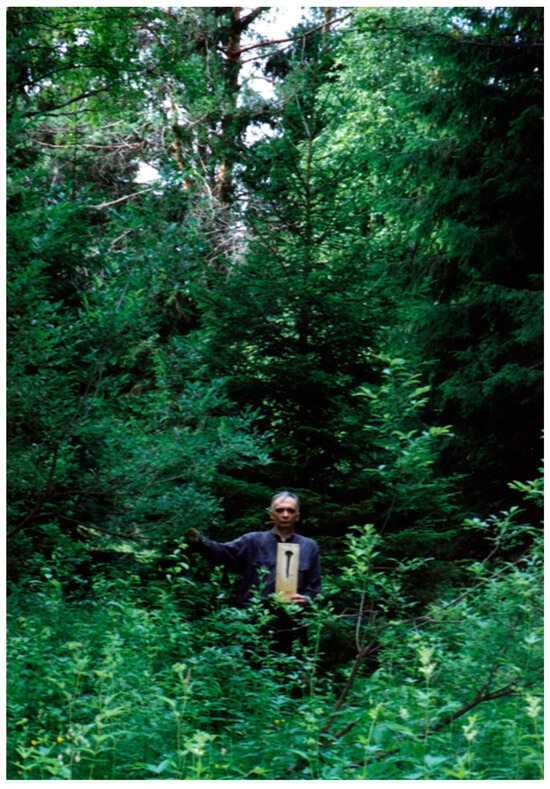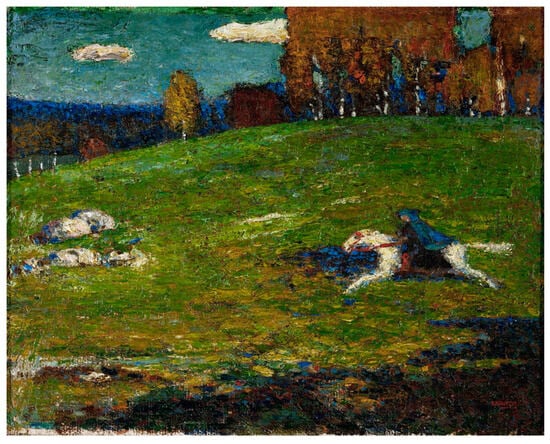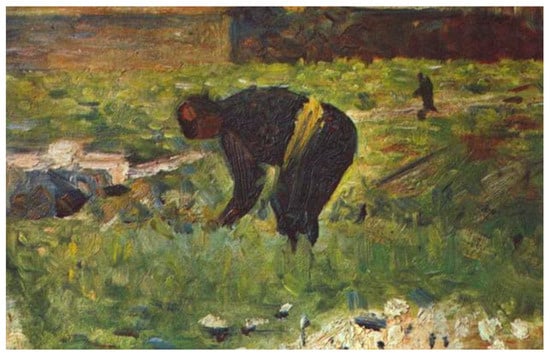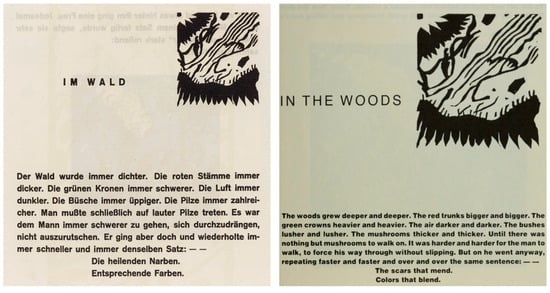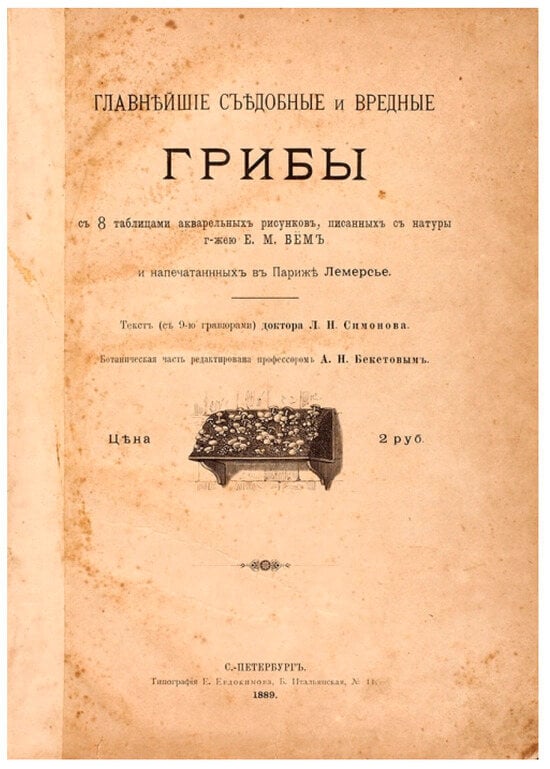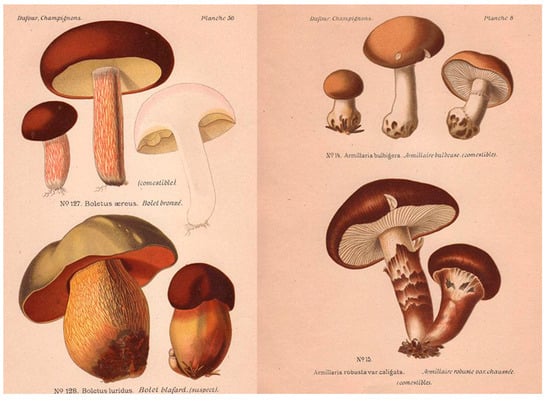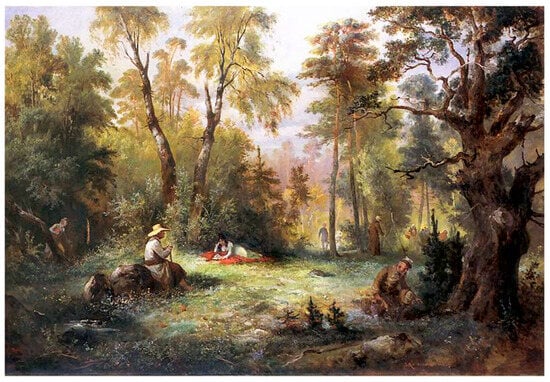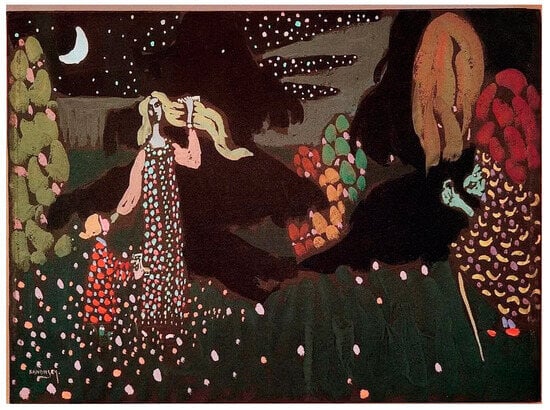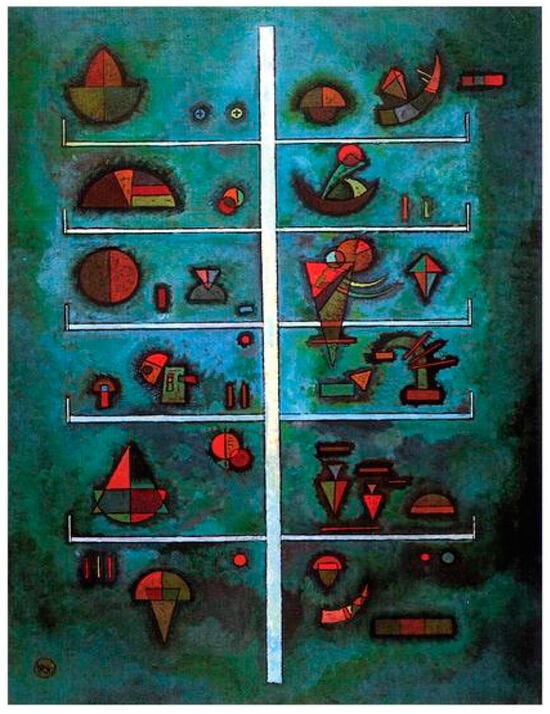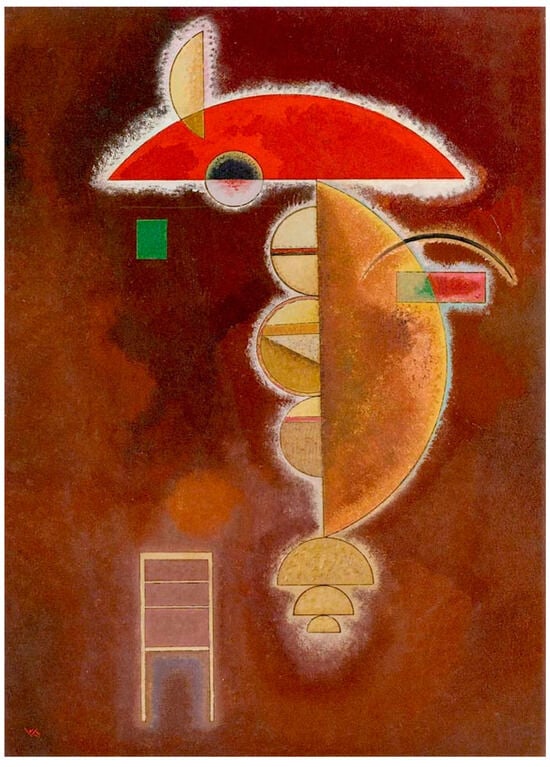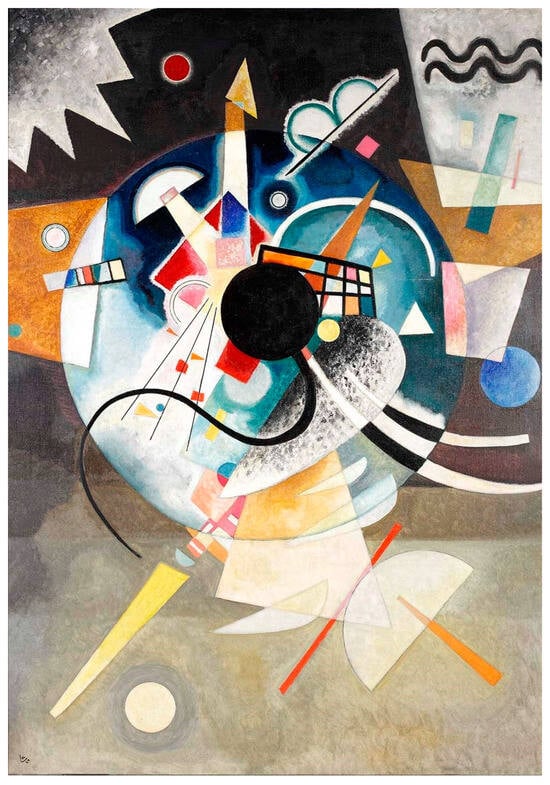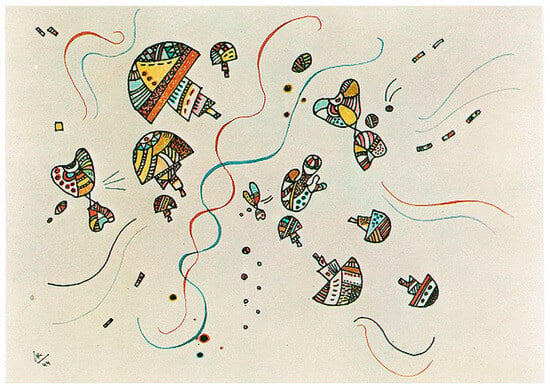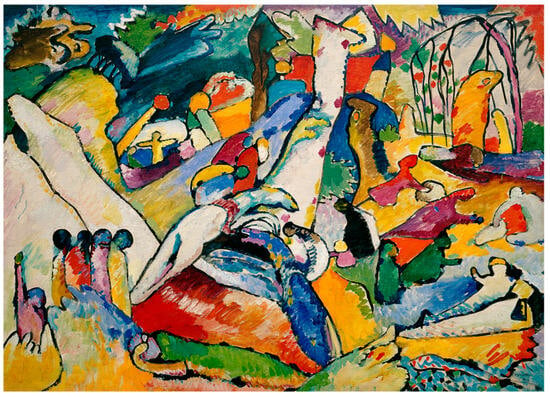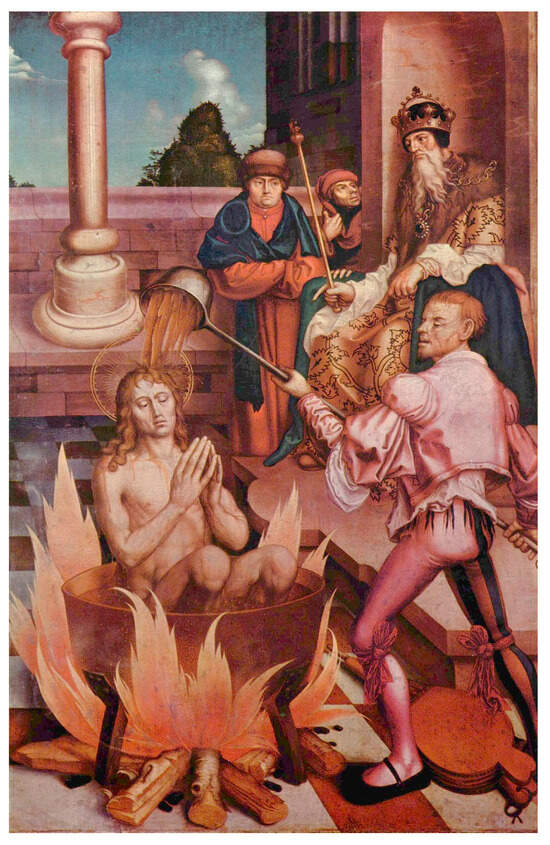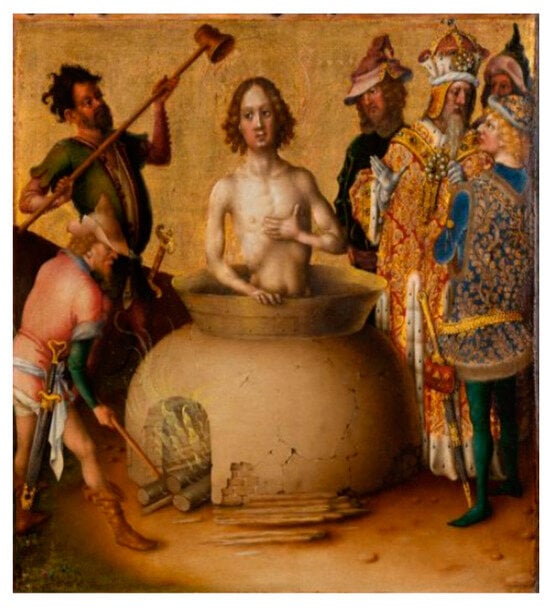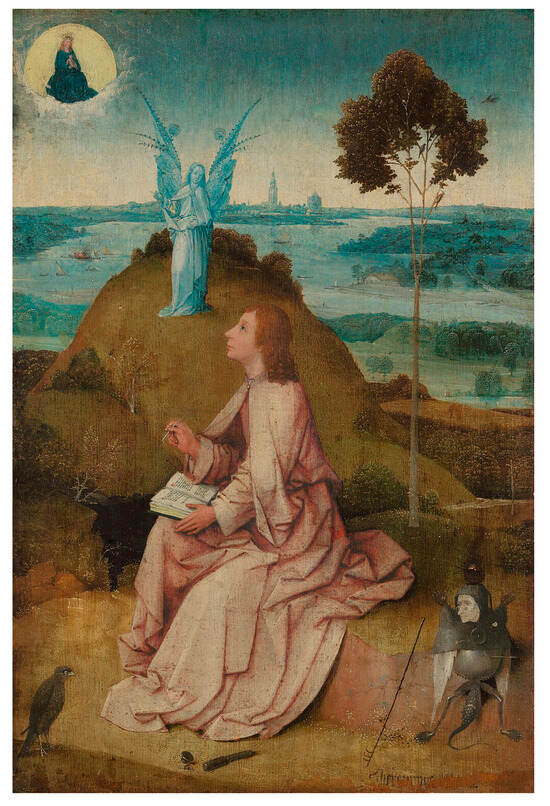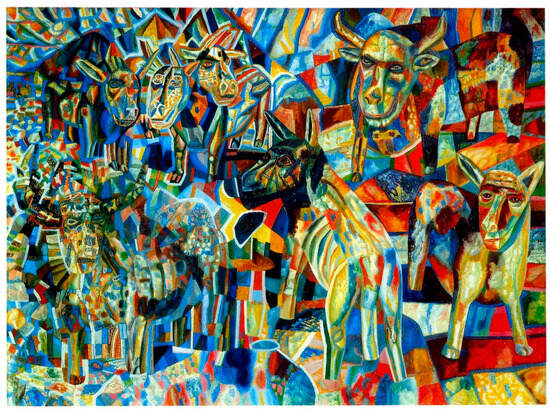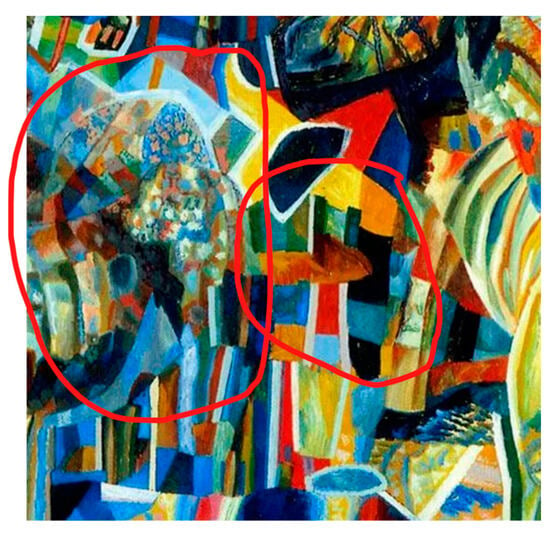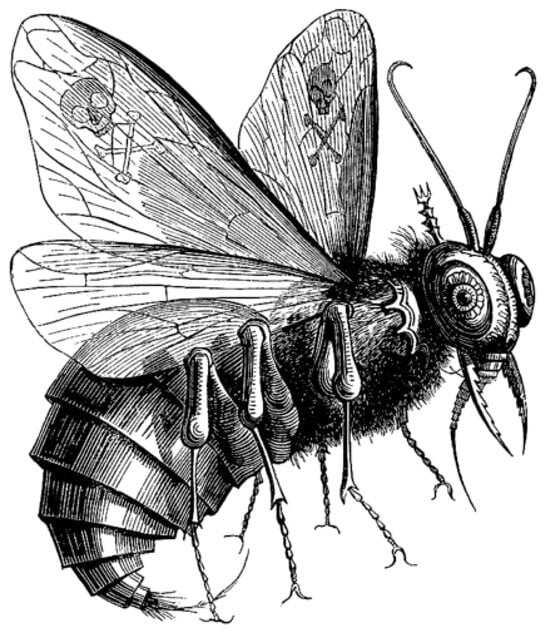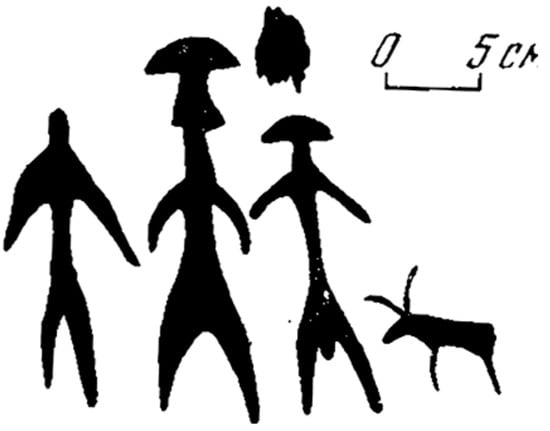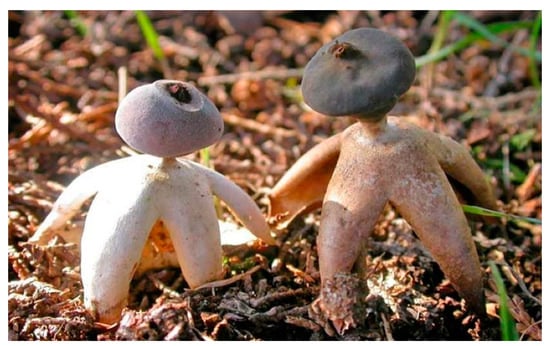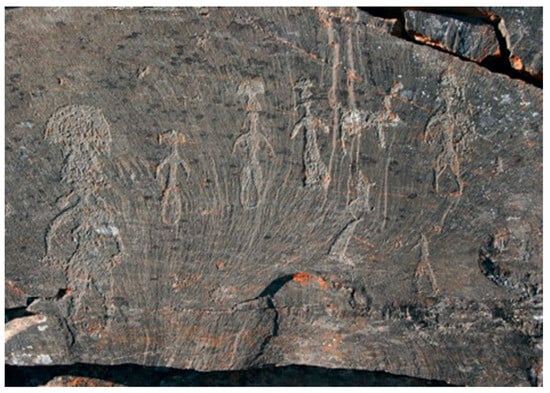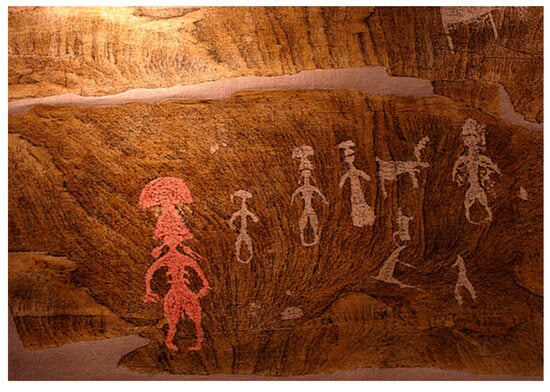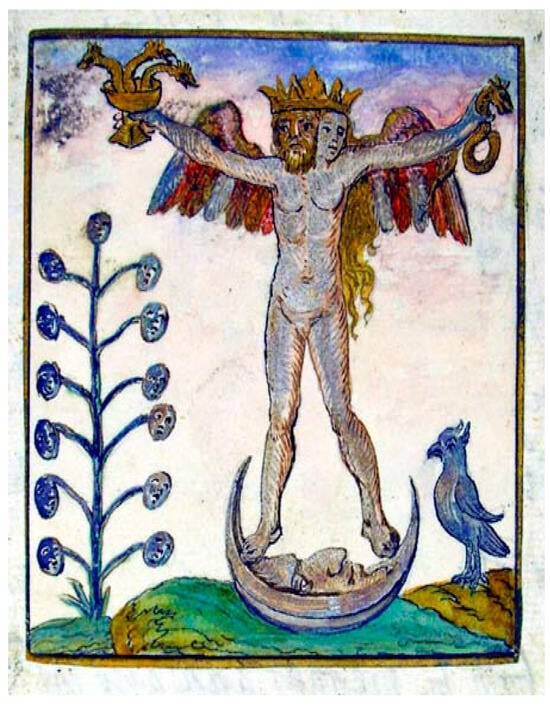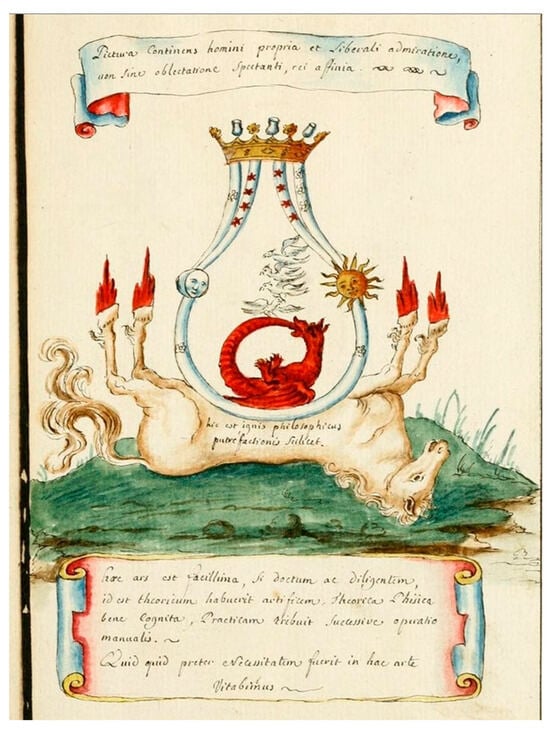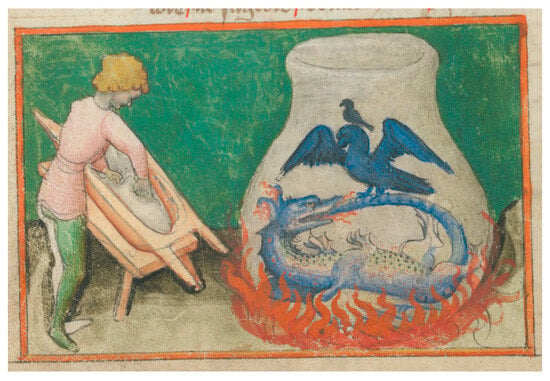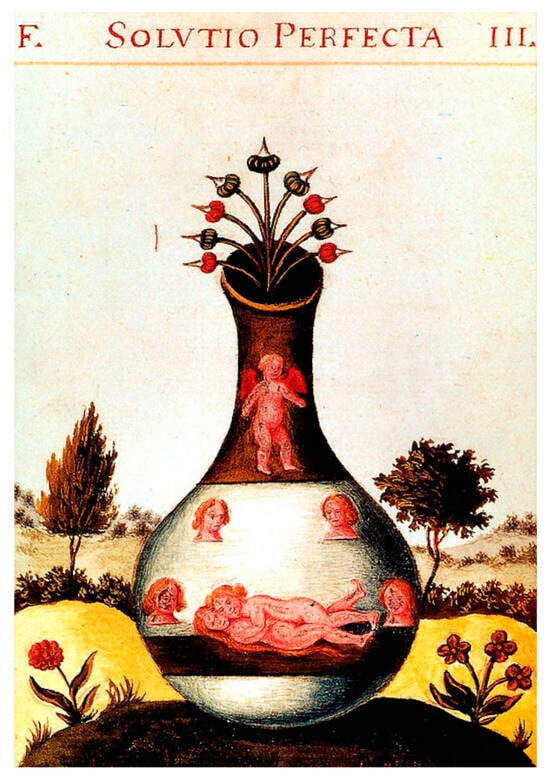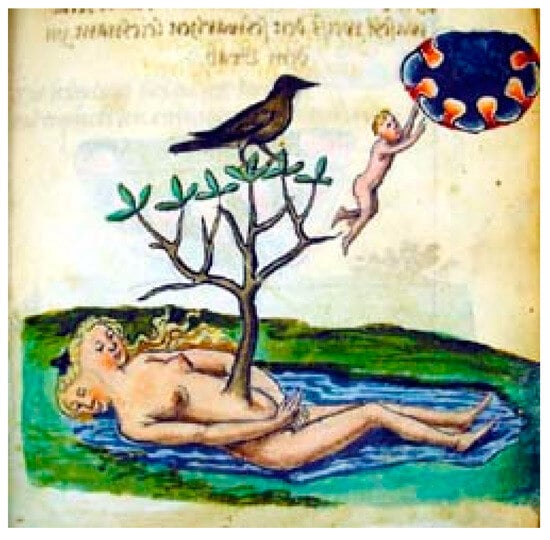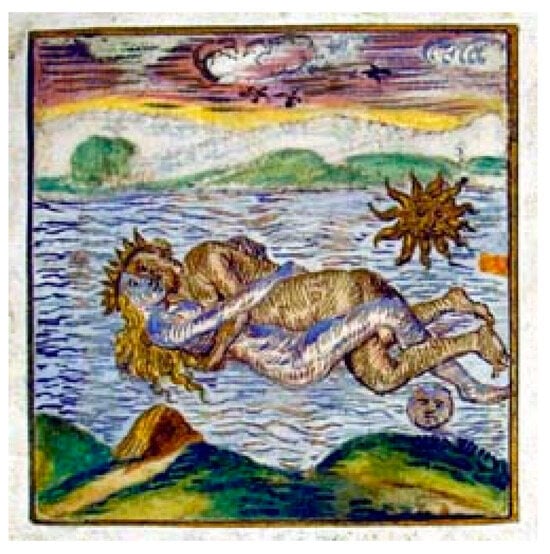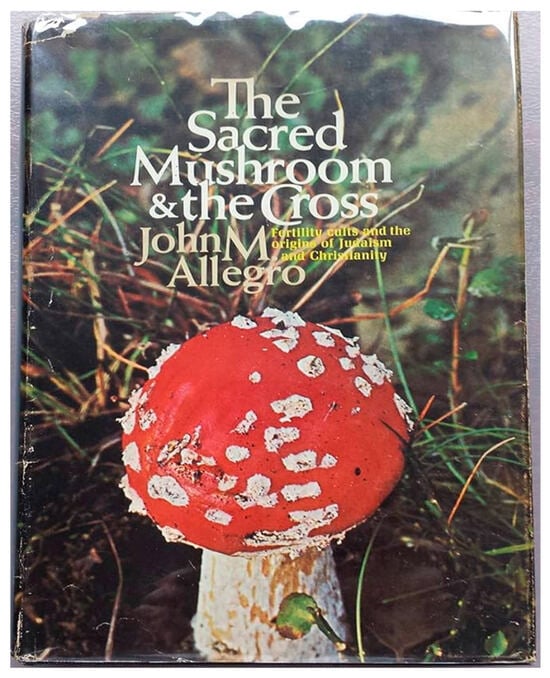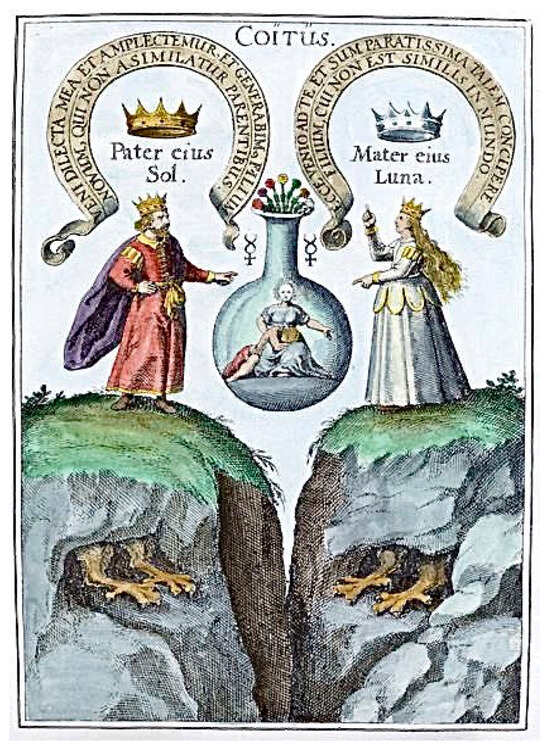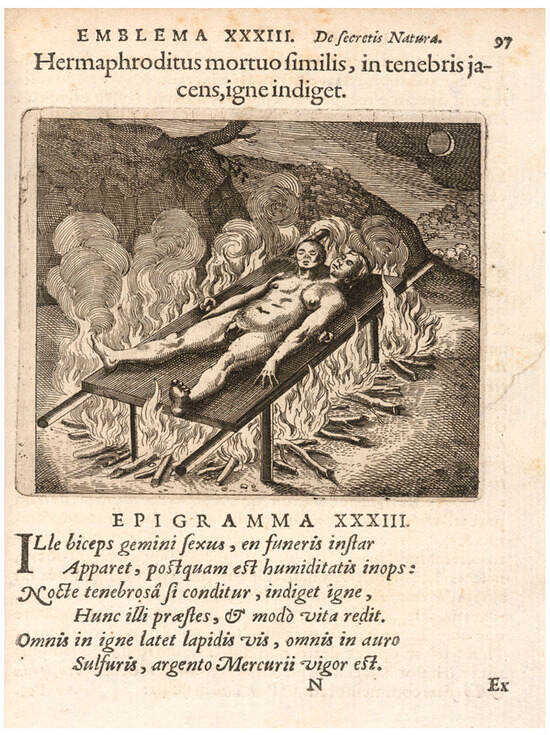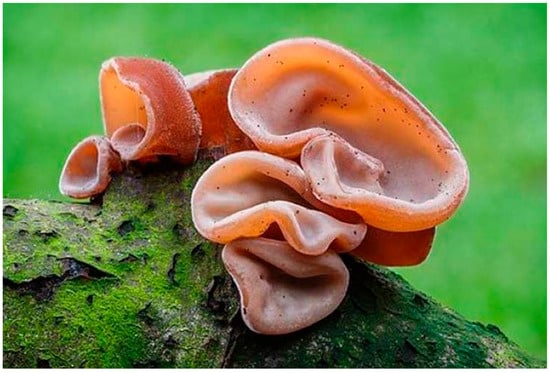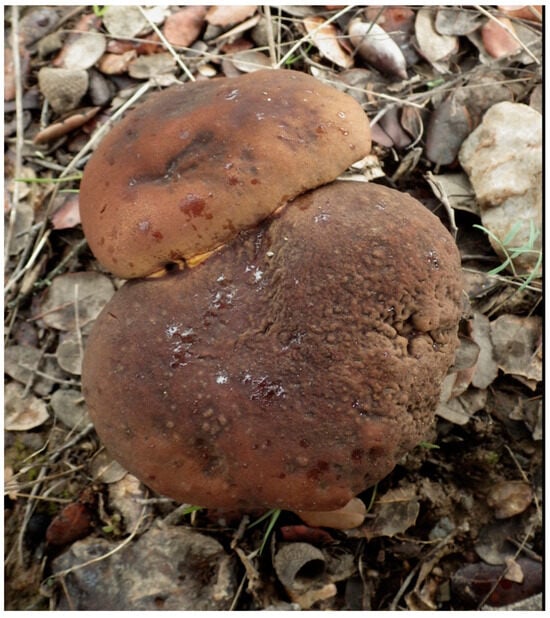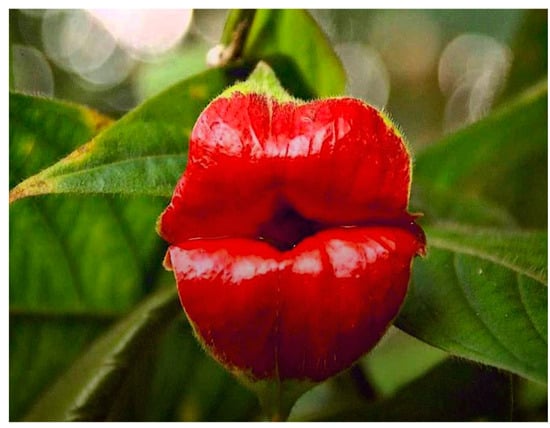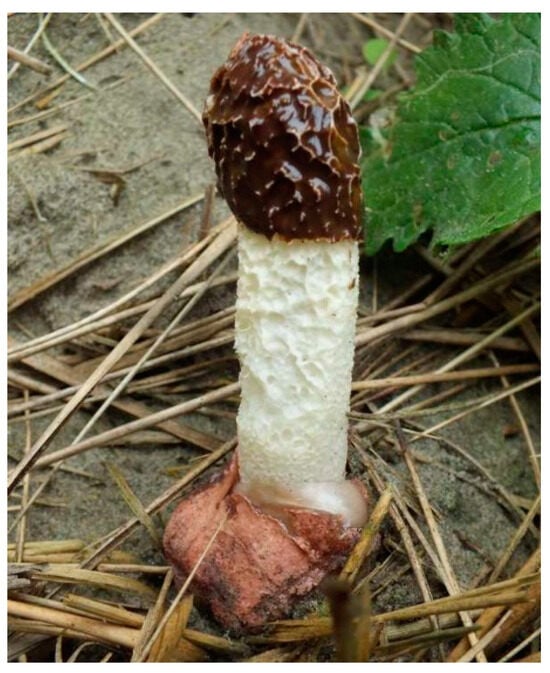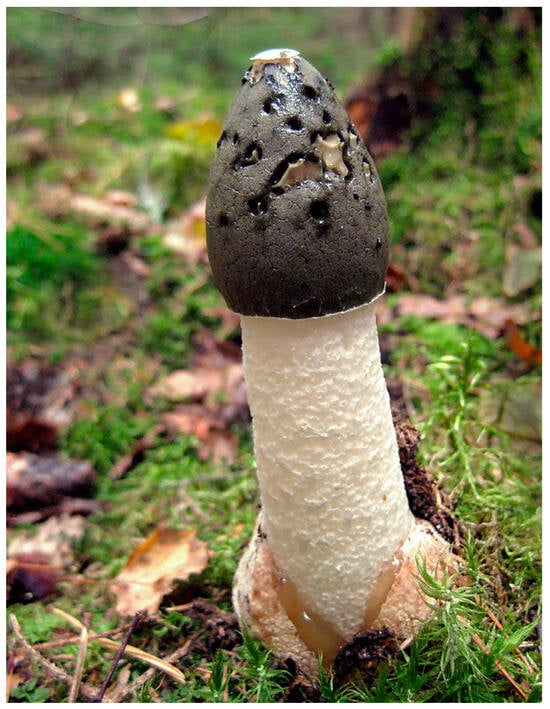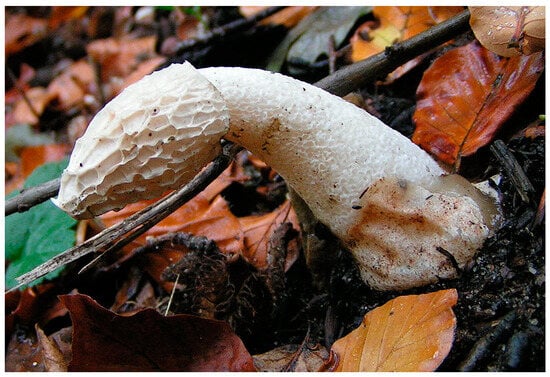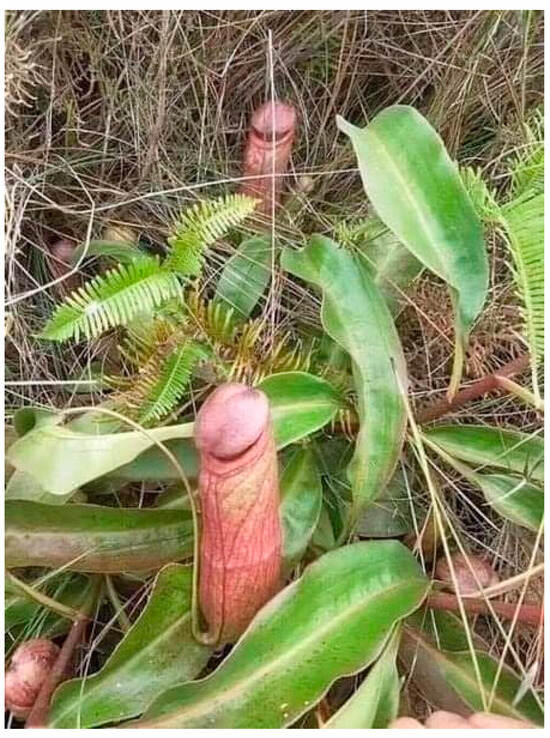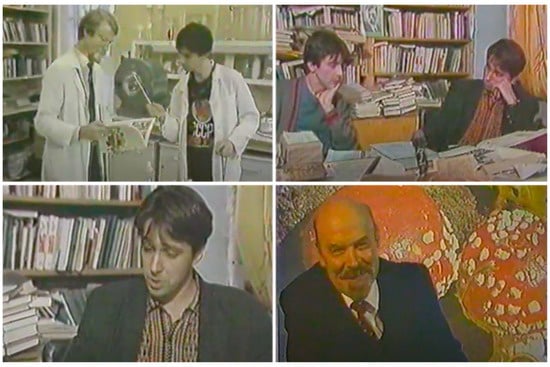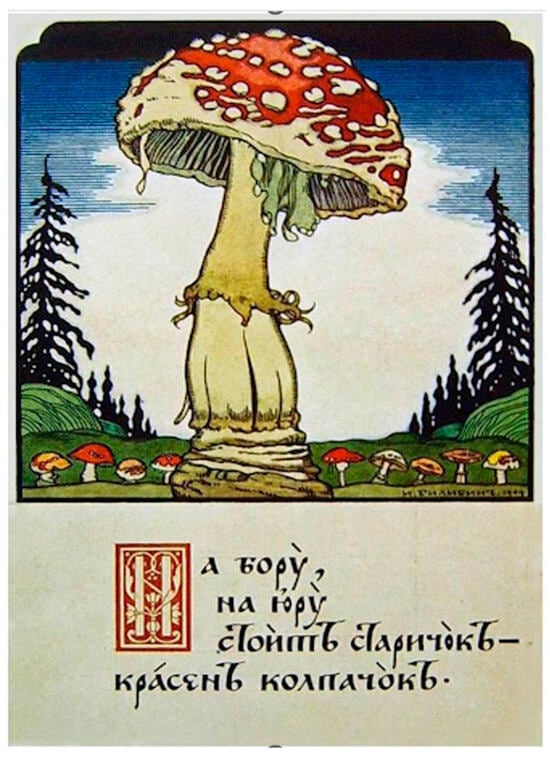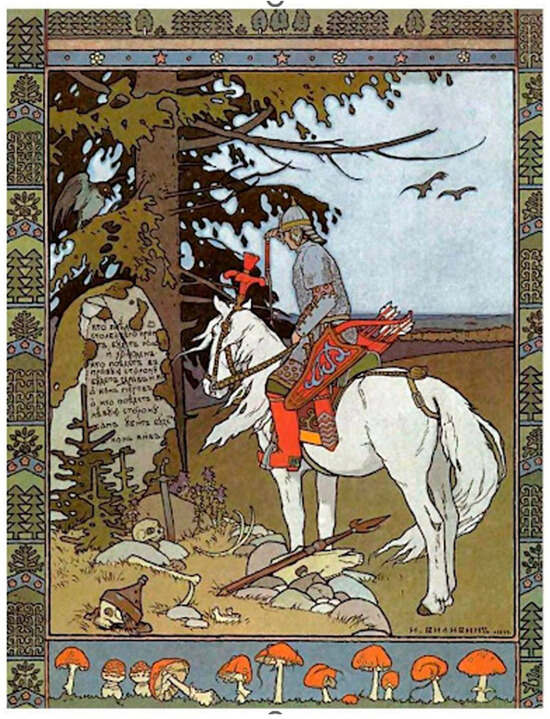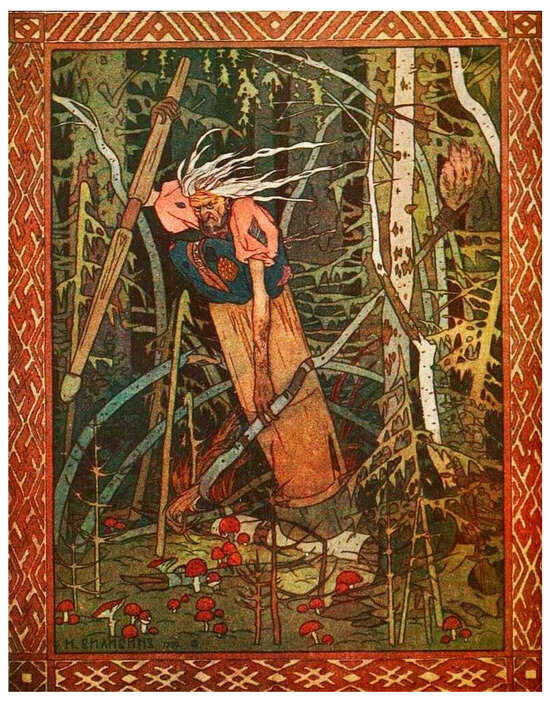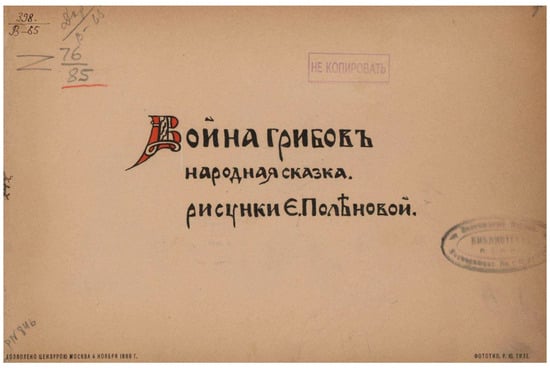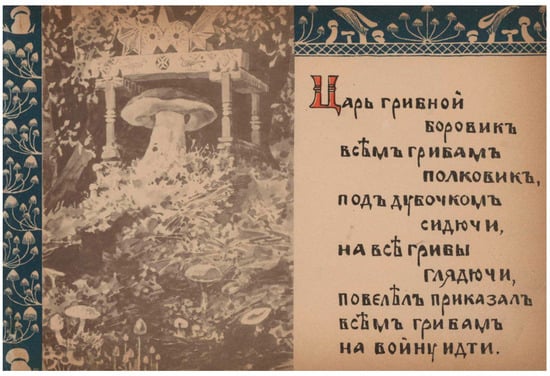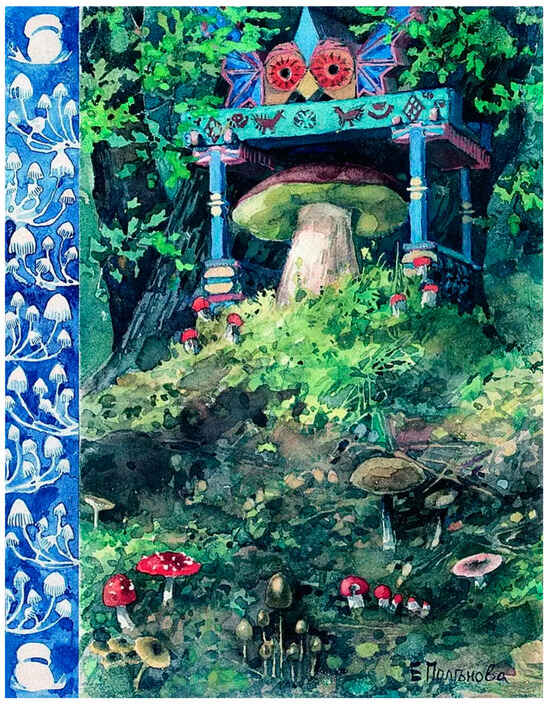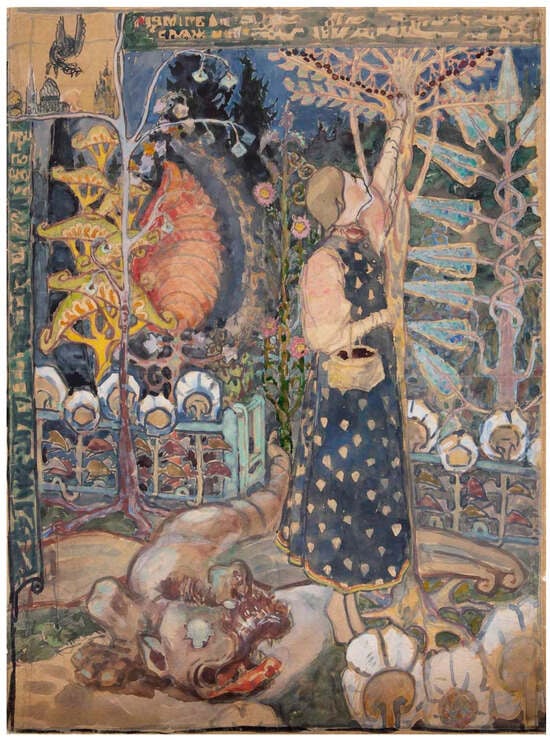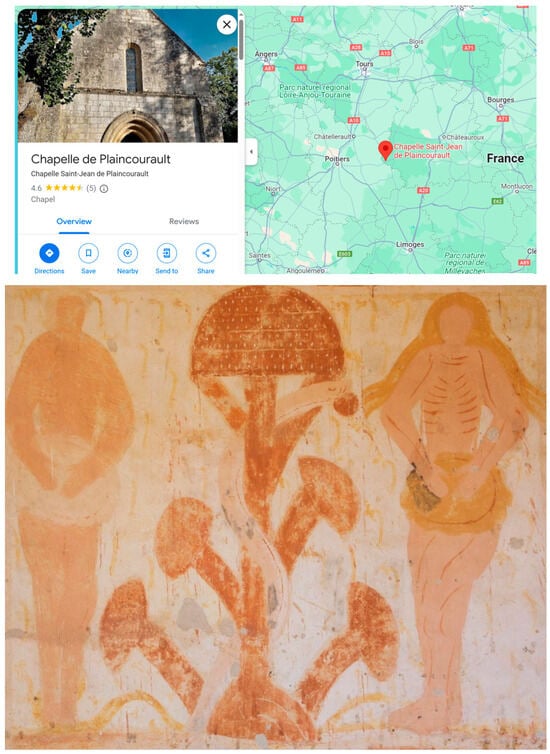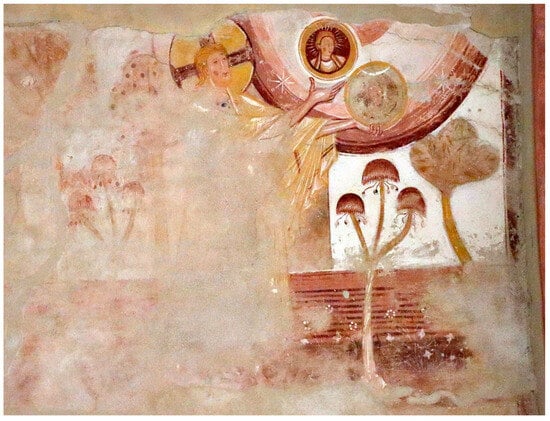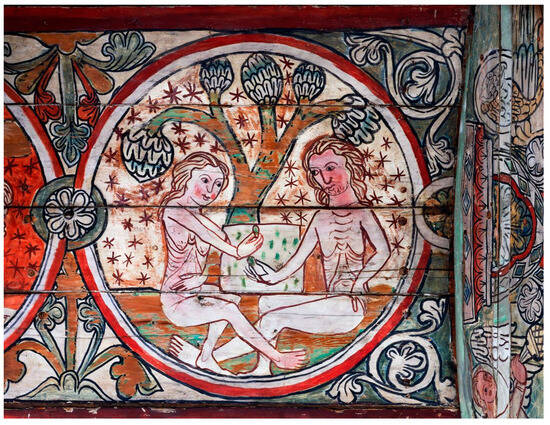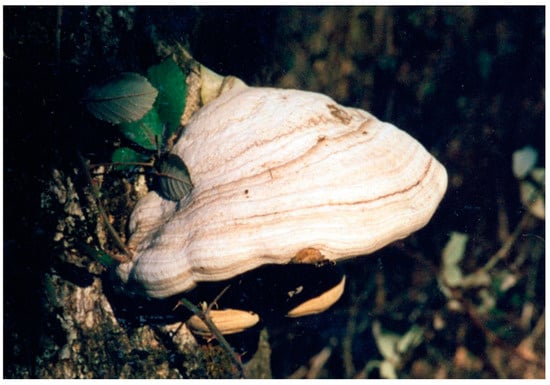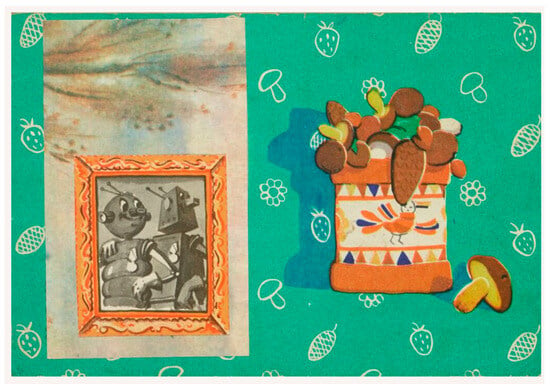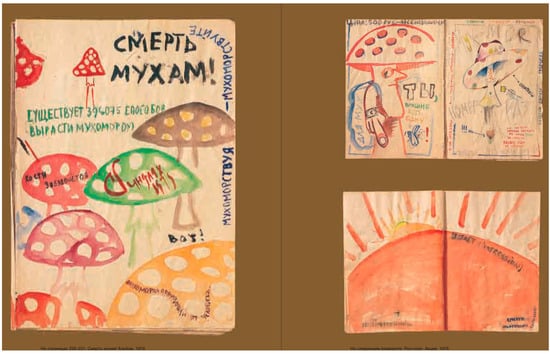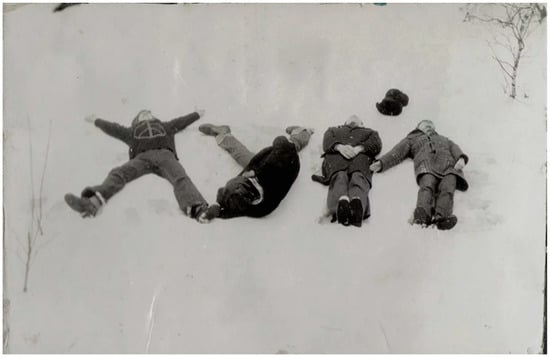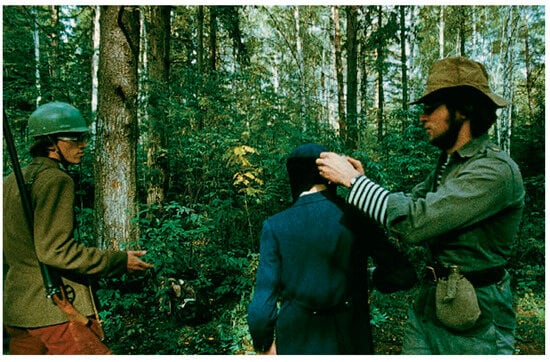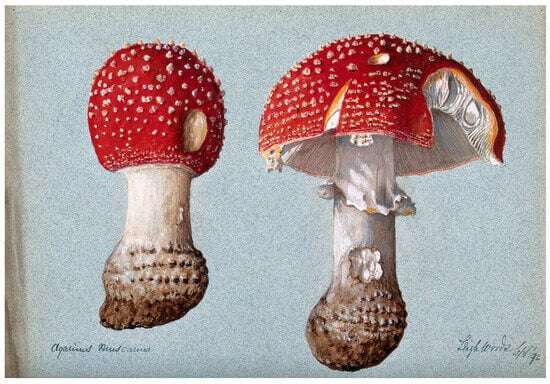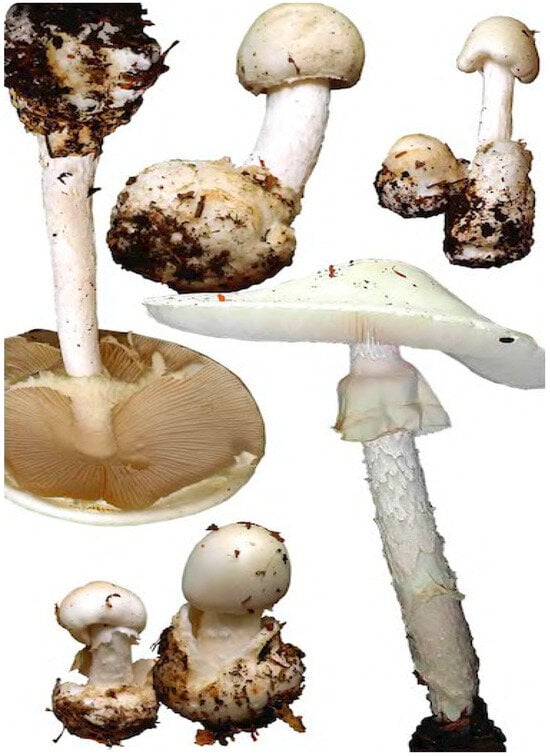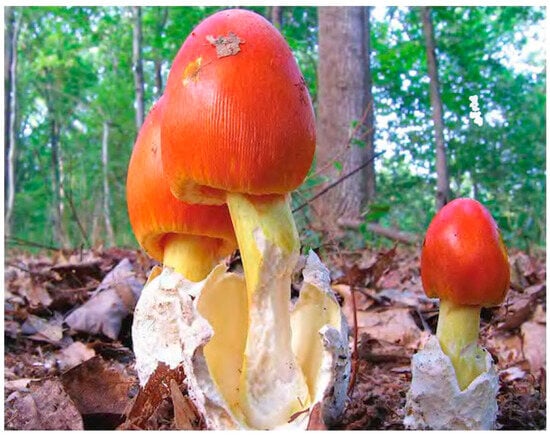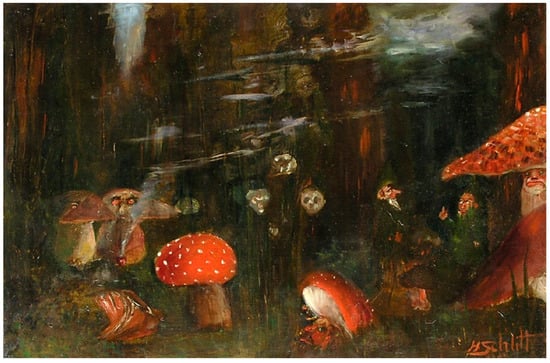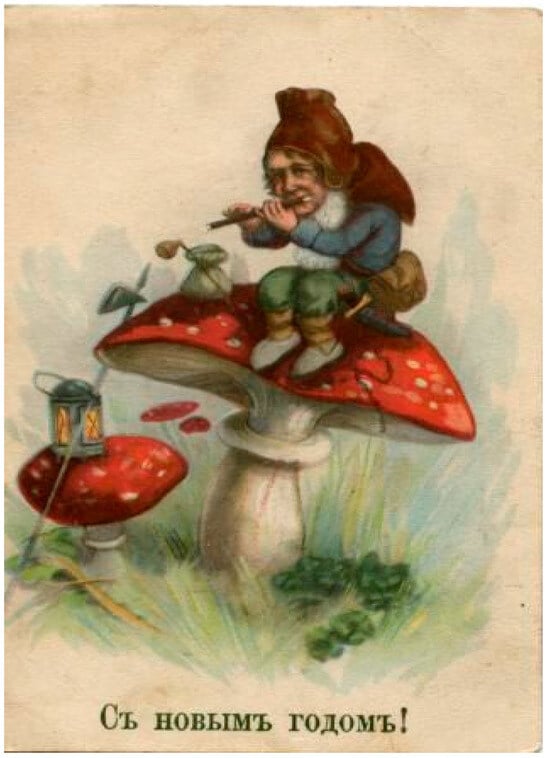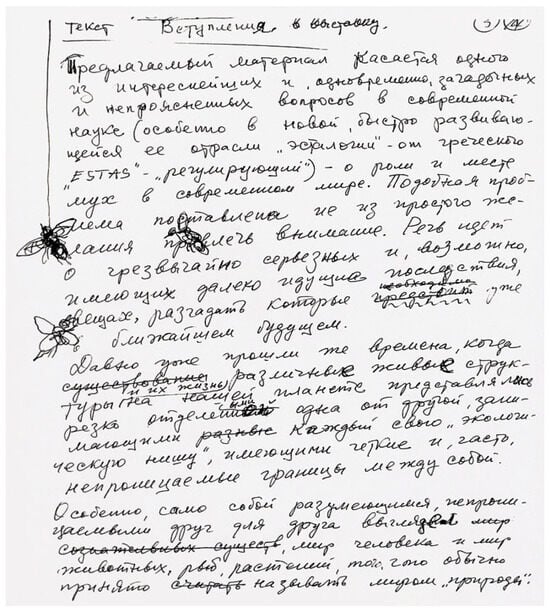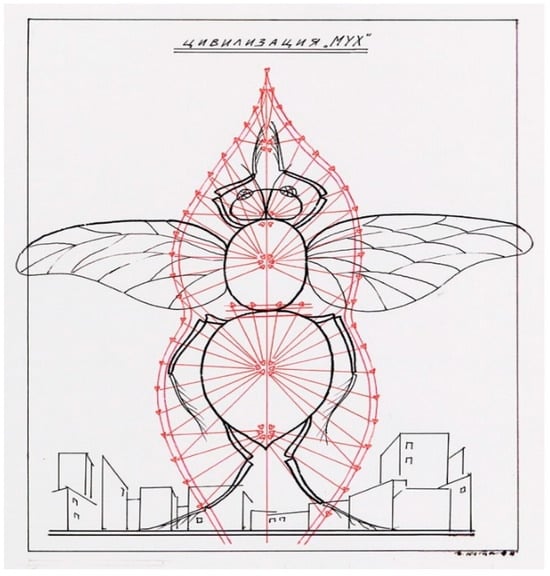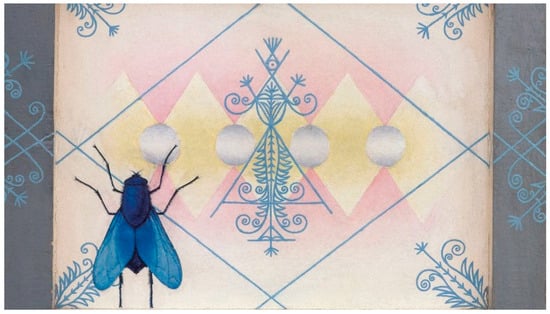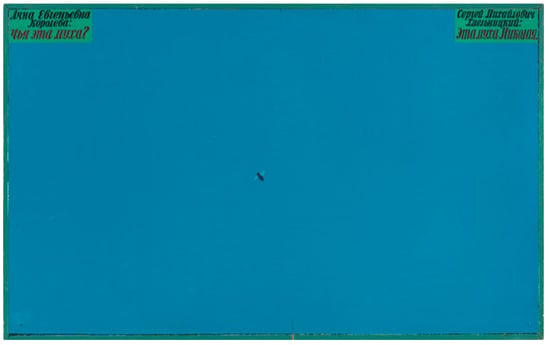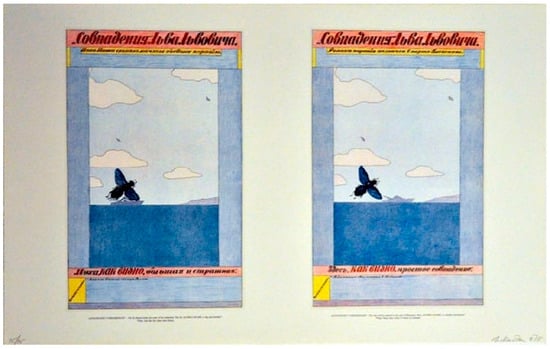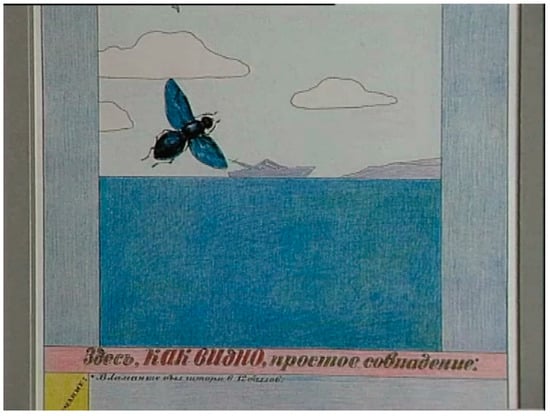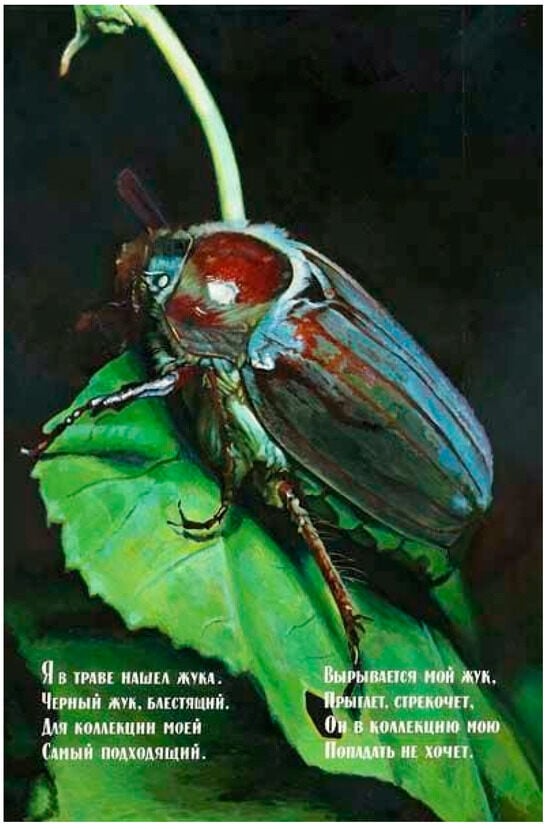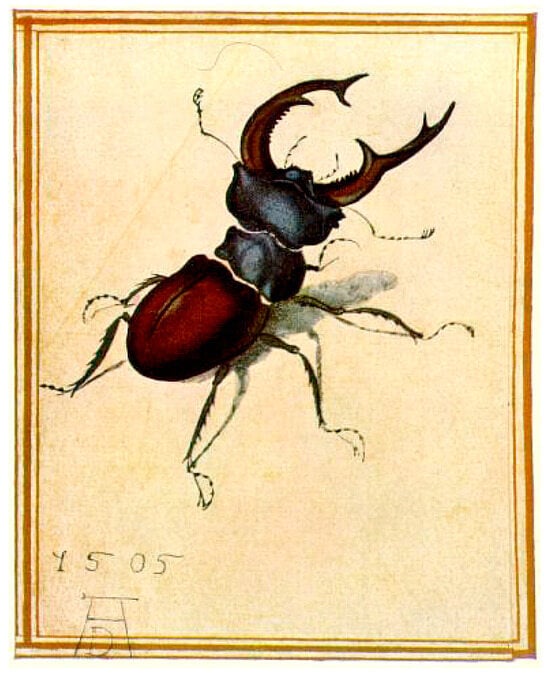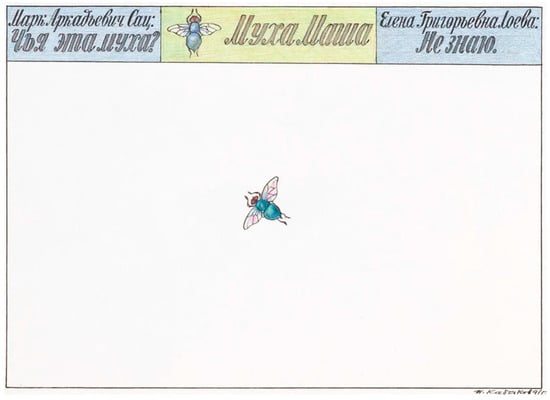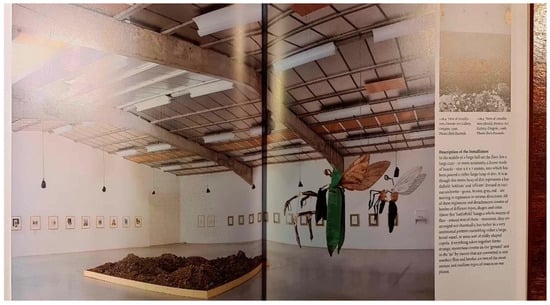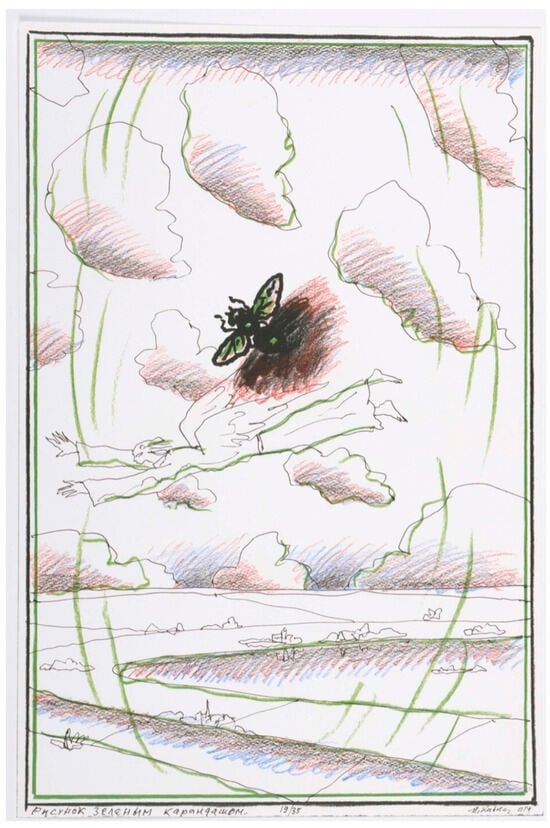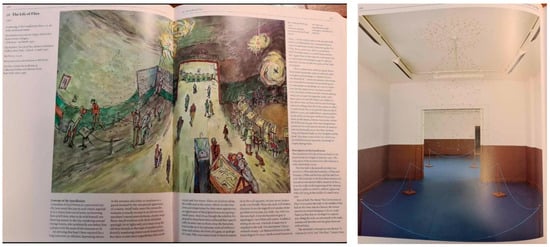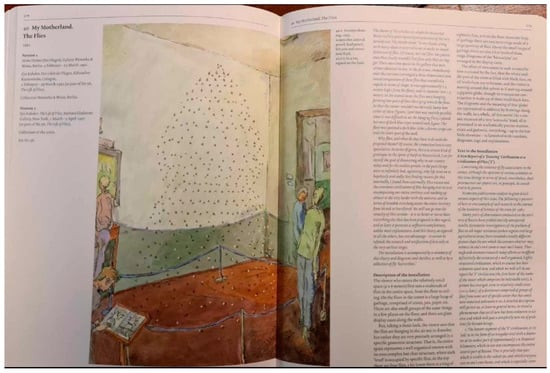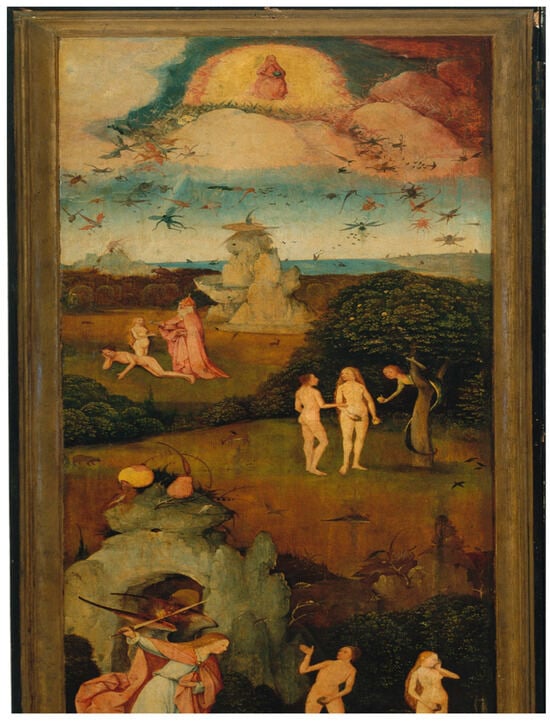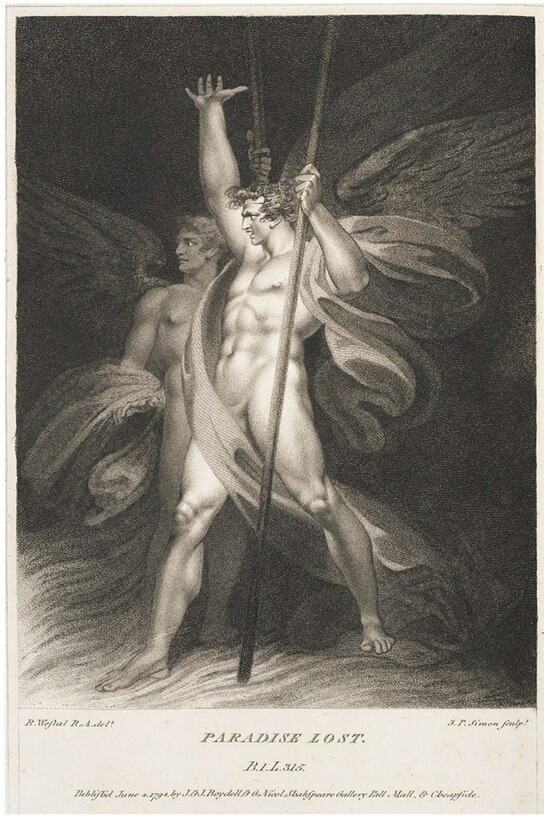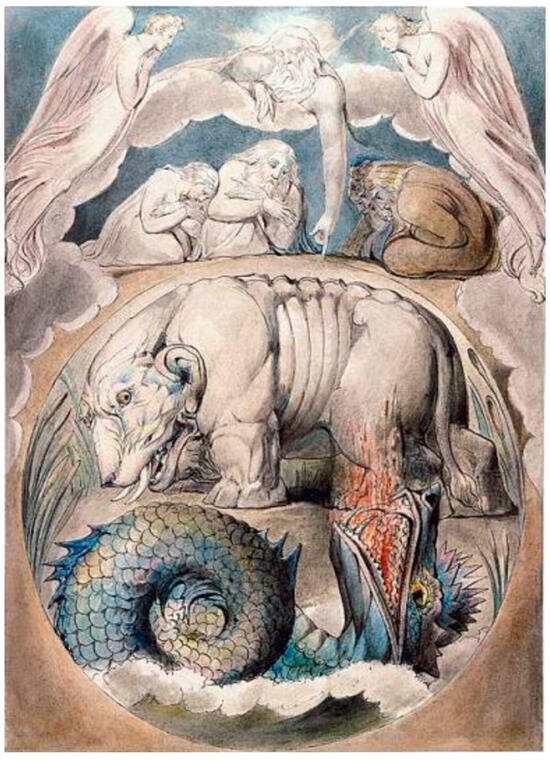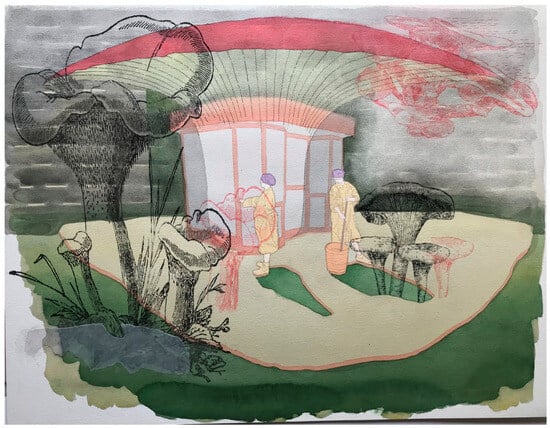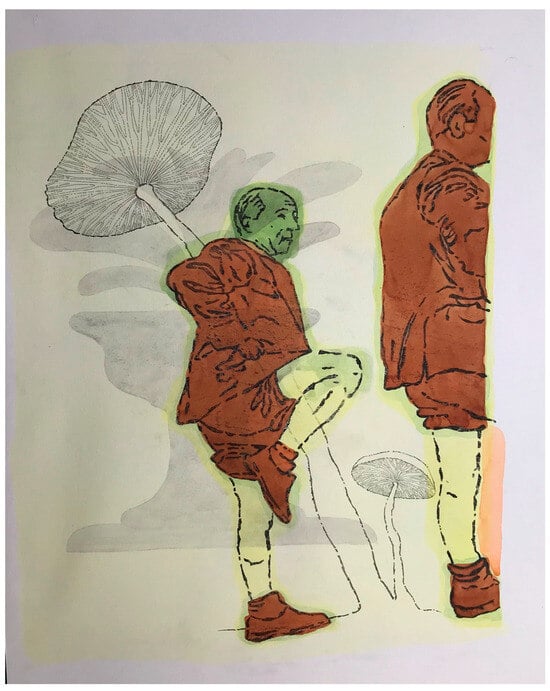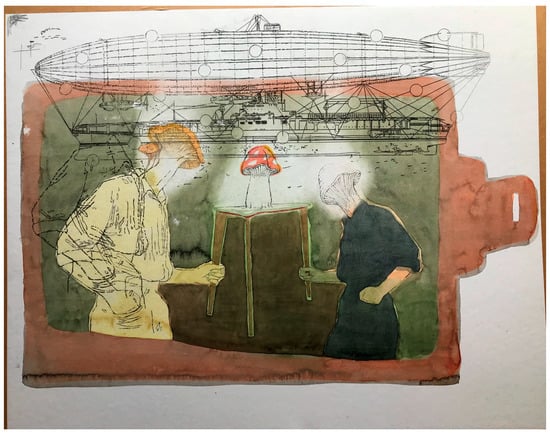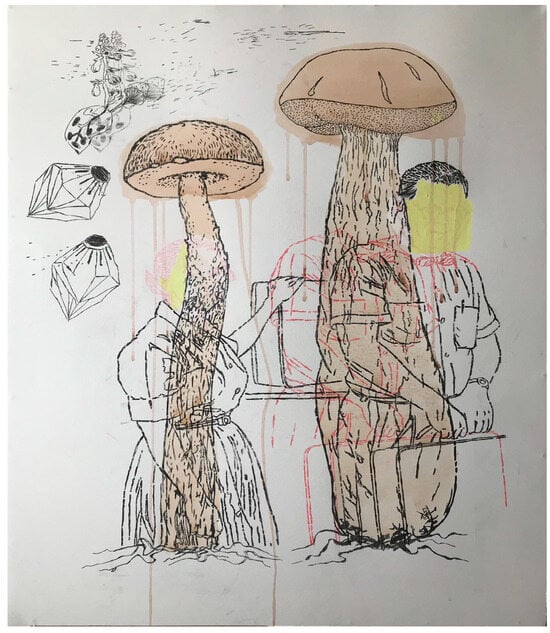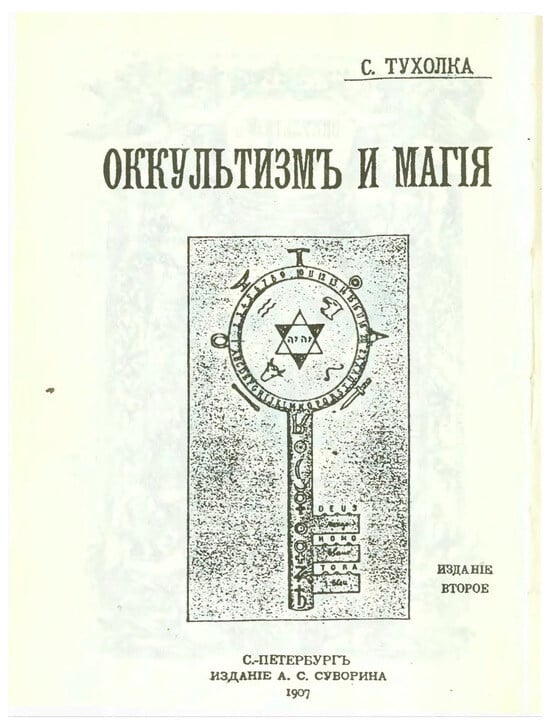Abstract
This paper aims to observe, contextualize, and analyze the multifaceted religious fungal foundations of Moscow Conceptualism within the context of Slavic and European esoteric mythological praxis. By unveiling the thematic basis of their transgressive spiritual endeavors, this study seeks to enhance our comprehension of this artistic and literary movement in the Western world. Besides exploring the erotic aesthetics associated with mushrooms, significant attention is devoted to various flies, as the biological vitality of the mukhomor (‘fly agaric’ or amanita muscaria) is inconceivable without them. Moscow Conceptualist visionaries, including Andrey Monastyrsky, Ilia Kabakov, Elagina and Makarevich, and the Mukhomor Moscow collectives, along with their no less famous colleague from Leningrad, Sergey Kuriokhin, emerge not only as artists but also as literary innovators. They seamlessly integrate advancements from the realm of art, giving rise to a novel form of religiously symbiotic semiosis. Consequently, the traditional boundaries between diverse art forms become blurred, marking a distinctive characteristic that aligns with international contemporary avant-garde aesthetics.
“The most beautiful thing we can experience is the mysterious. It is the source of all true art and all science. He to whom this emotion is a stranger, who can no longer pause to wonder and stand rapt in awe, is as good as dead: his eyes are closed. The insight into the mystery of life, coupled with fear, has also given rise to religion. To know what is impenetrable to us really exists, manifesting itself as the highest wisdom and the most radiant beauty, which our dull faculties can comprehend only in their most primitive forms—this knowledge, this feeling is at the center of true religiousness.”Albert Einstein (1954).
1. Preliminary Remarks
In the following discussion1, I delve into the intricate intellectual roots of the ‘mushroom theme’, or more precisely, the concept of a ‘mushroom esoteric religion’ within the multifocal realms of Moscow Conceptualism.2 This thematic exploration is vividly showcased through the works of numerous influential figures and collectives from the tumultuous decades of the 1970s and 1980s. This recurrent motif among several visionary artists can be aptly likened to the construct of an esoteric religious ideology, embodying layers of hidden meanings and spiritual connotations. It serves as a symbolically rich thread weaving through their artistic expressions, inviting interpretations that transcend the surface narrative. At the core of this phenomenon lie the Moscow Conceptualists, who emerged as the vanguard of intellectualism and cultural exploration within Soviet society. They constituted a distinctively erudite and cultivated subset, endowed with a depth of knowledge and insight often inaccessible to the broader provincial populace. Their privileged access to information, combined with their relentless pursuit of intellectual inquiry, afforded them a unique perspective that permeated their artistic endeavors. Through their oeuvre, they not only challenged the constraints of the prevailing socio-political landscape but also illuminated the clandestine realms of thought and belief, inviting viewers to engage with concepts beyond the ordinary (Nicholas 2024; Groys 2013; Eşanu 2013; Degot and Zakharov 2005; Nicholas 2022; Jackson 2016; Ioffe 2013, 2016, 2022). In essence, the ‘mushroom esoteric religion’ of Moscow Conceptualism (Ioffe 2020) transcends mere artistic expression; it embodies a profound exploration of the human condition, spirituality, eroticism, and more generally, the boundaries of perception. It stands as a testament to the power of creativity to transcend limitations and inspire deeper introspection, even in the face of adversity. Uniquely, they had access to the so-called library ‘Special Storage’ (spetzkhran) reserved for the members of Soviet scientific/academic community. Their intellectual milieu, epitomized by figures like Monastyrsky and Kabakov, was exceptionally assertive and successful in obtaining “restricted” reading material and various Western resources. (Zdenek 2000).
For the purposes of this essay, I consider the potential influence of Moscow Conceptualism stemming from the broader historical context of mushroom symbolism and esotericism. This encompasses various cultic depictions of mushrooms, particularly the fly agaric, along with the topical spiritual dimensions associated with them. Throughout its existence, Moscow Conceptualism has been marked by a playful engagement with metaphysical themes, often expressing sarcasm and irony directed at various targets, a characteristic trait often referred to as ‘Russian steb’ (Ioffe and Oushakine 2013; further elaborated upon below). This essay illustrates how mushrooms, long revered in ancient religious and magical traditions, continue to hold significance as catalysts for various provocative cultural endeavors within the artistic collective consciousness. Fungi play pivotal roles in subversive cultural movements, artistic expressions, and common practices. This paper delves into a remarkable case study of a neo/post/avant-garde practice, which, through the lens of ethnomycology, can aptly be characterized as a ‘blurred genre’, if to borrow from the theoretical framework proposed by Clifford Geertz. Another objective of this essay is to highlight the potential reference (and relevance) to the alchemical imagery within Russian Conceptualism, focusing on the unique process of fluid transmutation where one entity transforms into another. This phenomenon underscores the birth of novel entities through the mutation of existing concepts and representations, revealing intriguing layers of meaning within the movement. (Glanc 2001; Kusovac 2019).
By and large, this article zooms in on the iconographic origins of mushroom imagery within the Moscow Conceptualist milieu, highlighting the potentially infinite depth of knowledge they represent. The focus lies on exploring the potential influence of esoteric mushroom symbolism within the conceptualist community. It is more appropriate to refrain from passing judgment on the historic empirical accuracy of specific beliefs regarding mushrooms’ nature, their anthropomorphic interpretations, or notions concerning the figure of Christ. The ad hoc goal is not to privilege any specific notion but to try to describe their potent existence as well as their relevance to the provocative iconography characteristic of Moscow Conceptualist circles. Mushrooms occupy a very special niche in the early-modernist cultural milieu. One may refer to the Belgian Symbolist Charles Van Lerberghe’s famous Sélection surnaturelle, conceived in 1905, known also under the title of ‘Les Aventures merveilleuses du Prince de Cynthie et de son serviteur Saturne’ which develops the science-fiction notion of huge blue fungi which upon consummation magically transport those who ate them to the distant centuries, allowing them to dwell in a hallucinogenic reality of the newly transformed universe.
Central to this exploration of fungal psychotropic reality arises the controversial figure of John Allegro, whose work on the sensual occult nature of a Christ figure involving mushrooms de facto lacks scientific acceptance and verifiable credibility. It belongs rather to the New Age occult metaphysics than to the domain of normal science. Nevertheless, these concepts hold significant sway in the realm of history of (esoteric) ideas, contributing to the surrealistic alchemical essence inherent in conceptualist art. Moscow Conceptualism has long been intertwined with the legacy of surrealist culture, and Allegro’s provocative exploration of psychedelic Occultism, as discussed below, aligns seamlessly with this tradition.
To grasp the iconographic foundation of mushroom-themed surrealism within Moscow Conceptualism, as exemplified by artists like Kabakov, Makarevich–Elagina, and the group ‘Mukhomor’, it is essential to delve into reflections on esoteric and erotic Occultism, mushroom-suggestive gnostic alchemy that evokes fungal associations, and related subjects. Primarily, it is essential to define our interpretation of New Age esotericism, a category under which we position Moscow Conceptualism in this broad context. The primary object of the study of this essay is therefore the visual artistic creation of Moscow Conceptualism, while the secondary, auxiliary matter of enquiry is the esoteric universe of the New Age occult and the related minor currents that are discussed as the source of influence and potential gravity.
What actually represents Moscow Conceptualism as such? This highly elusive art movement showcases a conglomerate of various artistic groupings that gradually emerged in Moscow in the late 1960s, continuing though the 1980s and has had a significant impact on Russian art and culture in general (Rosenfeld 2011; Nicholas 2024). It is associated with a wide range of art forms, including painting, sculpture, photography, video, and especially installation and performance art (Nicholas 2024; Ioffe 2016, 2017). The main ideology of Moscow Conceptualism presumes that a work of art should not only represent a skillfully created aesthetic object, but more importantly, it must pose the original idea or concept that underlies its entire ‘mental’ being of thought. In this sense, conceptual artists tend to prioritize the originality of wording or the spiritually visionary nature of the conceptual ideas and messages they are usually trying to convey through their complicated activities. One of the key aspects of Moscow Conceptualism is its carnivalesque-critical attitude towards Soviet reality and official ideologies of all kinds. Artists of this current actively and provocatively explored themes of political censorship, identity, history, and social reality, expressing their subversive thoughts and ideas through abstract creations and symbolic art forms. The movement, among other things, openly championed esoteric and mystic subtexts in their aesthetic programs. The originality of Moscow Conceptualism for art history lies in its combination of experimentation, sophisticated intellectualism, and a radical-critical approach to the initial cognition of reality. This movement helped to draw attention to contemporary Russian art as an essential and indispensable part of the global artistic context, spotlighting the development of international conceptual art in general (Groys 2013).
2. Introducing the Subject: Esoteric Context and the Fungi
Esotericism often emerges at the borderlines, signifying a loss of traditional culture that previously provided a rich source of metaphysical contemplation and religious action. The concept of ‘tradition’ here encompasses the broader spiritual quests of the past. Traditional knowledge about the world may cease to function normally and lose value, especially during significant events like the collapse of a large state or drastic political regime changes. Esotericism (at times also erotic), in such instances, becomes a quest for spiritual support in various alien traditions and cultures, including those rooted in foreign belief systems and practices. Moscow Conceptualism, which developed during the decadent/stagnant decline and fall of the Soviet empire, can be analogized with the emergence of Hellenistic mystery cults during the gradual decline of the Roman Empire. In this context, Moscow Conceptualism manifests as a new metaphysical mysticism, using esoteric narratives—whether visual or verbal—as stylization, bitter irony, and sometimes a peculiar form of ‘schizodiscourse’3 intertwined with a newly developed psychedelic religion (Ioffe 2020).
This essay aims to shed background light on the esoteric religious and quasi-religious metaphysical stiobby practices of Moscow Conceptualism, focusing on the roots of its ‘mushroom artistic system of thought’ with the groups like Mukhomor, Collective Actions, and Medgermeneutika. It analyzes the origins of this unique psycho-hallucinatory (post-)religion, providing concrete examples of myco-centric esoteric Buddhism as applied to Russian soil by figures like Andrei Monastyrsky in their art performances, diaries, and personal behavior (Ioffe 2013, 2016). The paradigmatic paternal figure of Ilya Kabakov emerges by the end of the essay in relation to the infernal insects that correspond to the fly-agaric theme of the discussed artistic esotericism (on general imagery of mukhomor, see Ioffe 2020; Batyanova 2001a, 2001b).
Here (Figure 1), Monastyrsky is possibly parodying the famous picture by Wassily Kandinsky with a rider that ‘escapes’ his destiny as it gradually dissolves within the green impressionistic landscape.
Instead of Kandinsky’s modernist velocity, Monastyrsky showcases the static (or even the stasis) and instead of a horse—a mushroom, or rather a painted conceptual image of it, referring to the semiotics of Joseph Kosuth’s masterwork “One and Three Chairs” (created in 1965). Monastyrsky’s virtual (or alchemical) connection to the mushroom is established through his exploration of the symbolic significance within an image and its resonance with the stillness inherent in this visual performance. By equating the depth of meaning found in both perceptual representation and static expression, he deepens his suggested identification with the mushroom, finding common ground between its essence and his own artistic expression. This alignment underscores his belief in the power of hidden symbolism and the transformative potential of art to convey profound insights about existence and human experience. The Blue Rider offers a notable contrast (Figure 2): which in its own turn compositionally somewhat reminds one of Georges Seurat’s canvas “Farmer Work” 1883 (Figure 3), bearing a suggestive allusion to the process of a natural mushroom selection and picking:
The evocative imagery of suggestive mushrooms can be found in the creative oeuvre of several prominent artists of Russian and global Modernism and the avant-garde. The intricate interrelation between the Russian historical avant-garde and Moscow Conceptualism is deeply embedded in both movements’ profound engagement with radical and innovative artistic expressions, albeit emerging from disparate historical contexts and pursuing distinct objectives. Both movements’ profound dedication to innovation and experimentation was epitomized by an emphatic departure from traditional art forms and a fervent quest for novel artistic languages. The avant-garde, analogous to Conceptualism, endeavored to amalgamate art with quotidian existence, significantly impacting architecture, design, and propaganda. Moscow Conceptualists articulated a defiant response to the state-mandated doctrine of Soviet ideo-realist approaches, striving to engender art that was reflective, critical, and frequently imbued with irony, accentuating the primacy of the concept or idea underpinning the artwork over its aesthetic attributes.
A salient characteristic of many conceptualist works is the coherent artistic integration of text and language, which serves as a medium to critique the power structures and constraints imposed by Soviet ideology. The employment of diverse working media, including performance art and installations, by these movements, sought to subvert and redefine traditional conceptions of art. The avant-garde movements instigated a rupture from 19th-century rigid realism and mainstream academic art (Ioffe and White 2012), while Moscow Conceptualists repudiated Socialist Realism as the best and the most characteristic instance of the “sanctioned art form”. Each movement operated within a highly politicized milieu: the avant-garde initially aligned itself with the revolutionary zeal of the nascent Soviet state, whereas Moscow Conceptualism emerged as a critique of the stagnation and autocracy of the late Soviet era. The philosophical foundations of both movements were profoundly influenced by contemporary philosophical and theoretical discourses. The avant-garde, nourished by the tenets of Futurism, Constructivism, and Suprematism, generally served as a progenitor to Moscow Conceptualism, which also drew inspiration from Western conceptual art as well as the sophisticated traditions of semiotics and structuralism. Both movements espoused the ethos of ‘Art as Life’ praxis: the avant-garde’s aspiration to fuse art with everyday life found a meaningful resonance in Moscow Conceptualism’s employment of mundane objects and vernacular language to articulate profound insights about reality and society. The historical avant-garde established a foundation that enabled subsequent generations to challenge prevailing artistic and societal norms. In many respects, Moscow Conceptualists revitalized the spirit of radical experimentation that the avant-garde had initially inaugurated, albeit in a context necessitating subtlety and irony to circumvent censorship and potential political repression. Avant-garde was renowned for its audacious utilization of novel materials and techniques in painting, sculpture, and architecture. In contrast, Moscow Conceptualists frequently resorted to “traditional” text, semi-theatrical series of quasi-spontaneous performance, and the new art form to be known as ‘installations’ to convey their complex messages, often engaging in a metacritique of Soviet society and its concealed hypocritical politics. Despite the temporal and political disparities separating the Russian historical avant-garde and Moscow Conceptualism, both movements were united by a steadfast commitment to challenging the status quo and exploring new artistic possibilities to the widest possible extent. Moscow Conceptualism can thus be perceived and then construed as a continuation and reinterpretation of the avant-garde’s radical legacy, meticulously adapted to the specific exigencies of the late Soviet period. As I have pronounced a number of times in my previous publications—avant-garde and avant-gardists gave technical as well as spiritual birth to conceptualism and conceptualists (Ioffe 2013, 2016).
Foremost among these avant-gardists appears Wassily Kandinsky, whose shamanistic mushrooms have garnered considerable recognition.4 In Wassily Kandinsky’s multidimensional oeuvre, the recurring presence of mushrooms serves as a multifaceted symbol, embodying both tangible and metaphysical elements within his artistic expression. As a pioneering figure in abstract art, Kandinsky employed mushrooms as visual motifs to convey complex themes related to nature, spirituality, and the subconscious mind. Through their organic forms and vibrant colors, mushrooms in Kandinsky’s compositions often evoke a sense of extraordinary vitality and even some sort of theistic mysticism, inviting viewers to discern the interconnectedness of the natural world and the human psyche. Furthermore, the recurrent inclusion of mushroom-resembling objects across Kandinsky’s works (Figure 4) underscores his fascination with the transformative potential of art, wherein mundane subjects transcend their physicality to become conduits for transcendental experiences. Thus, the remarkable role of mushrooms in Kandinsky’s visuality extends beyond mere representation, serving as symbolic portals to realms of imagination and intangible illumination. In Kandinsky’s renowned poetic volume “Klange” (Sounds) (Kandinsky 1981) comprising prose poems and engravings (appeared in 1913 in the pre-war Munich), magical mushrooms feature within an esoteric framework intertwined with ancient pagan beliefs corresponding to a Thunderer deity (see the discussion below on Vladimir Toporov’s phallic mushroom symbolism).
The [magic] forest grew thicker and thicker. The red trunks turned increasingly dense. The green foliage became much heavier. The air grew darker. The bushes grew lusher. The mushrooms appeared to be more abundant. Eventually it was necessary to walk right through the mushrooms. It was increasingly difficult for a person to walk, treading rather than slipping.
At the time of Kandinsky, the exploration and utilization of mushrooms were already subjects of extensive study and fascination. Scholars and enthusiasts alike delved into the diverse array of mushrooms, probing their culinary, medicinal, and cultural significance. From ancient times to Kandinsky’s era, mushrooms held a multifaceted allure that transcended mere sustenance, embodying some mystery, hidden folk symbolism, and also scientific intrigue. In Kandinsky’s milieu, the realm of mycology had been enriched by years of observation and experimentation. Ethnobotanists documented the traditional uses of mushrooms by different cultures, revealing a tapestry of practices ranging from culinary delicacies to spiritual sacraments. Meanwhile, scientists scrutinized the biochemical composition of mushrooms, uncovering potential therapeutic properties and unlocking new avenues for pharmaceutical research.
Kandinsky himself may have been drawn to mushrooms not only for their practical appeal but also for their aesthetic and symbolic resonance. Just as he explored the expressive potential of colors and shapes in his art, mushrooms offered him a rich metaphorical vocabulary. Their ephemeral beauty, nestled between decay and regeneration, echoed themes of transience and transformation that permeated his work. Furthermore, the burgeoning interest in mycology intersected with broader cultural movements of the time. The fascination with nature, fueled by Romanticism and later by the burgeoning environmental consciousness, spurred renewed interest in the study of fungi. Intellectual representatives of the new historical age found in mushrooms a potent symbol of the interconnectedness of all living things, inspiring new perspectives on humanity’s place in the natural world. In this context, Kandinsky’s artistic exploration of mushrooms would have been both timely and resonant. Whether as subjects of ethnographic research or as motifs in abstract compositions, mushrooms provided him with a rich visual vocabulary to explore themes of nature, spirituality, and the subconscious. Thus, while Kandinsky’s era may not have been defined specifically by a mushroom craze, the fascination with fungi was undoubtedly a vibrant thread in the cultural tapestry of the new “eco-time”, weaving its way through art, ethnography, and philosophy with a richness that mirrored the diversity of the mushrooms themselves (Figure 5 and Figure 6).
Figure 6.
Leon Dufour. Atlas des Champignons Comestibles et Veneneux. 1891. “Of mushrooms there were plenty: the lads gathered the fair-cheeked fox-mushrooms, so famous in the Lithuanian songs as the emblem of maidenhood, for the worms do not eat them, and, marvelous to say, no insect alights on them; the young ladies hunted for the slender pine-lover, which the song calls the colonel of the mushrooms, All were eager for the orange-agaric; this, though of more modest stature and less famous in song, is still the most delicious, whether fresh or salted, whether in autumn or in winter. But the Seneschal gathered the toadstool fly-bane”. ‘Pan Tadeusz’ by Adam Mickiewicz ([1834] 1917).
In the corpus of traditional Slavic lore, many esoteric attitudes, intrinsically intertwined with the tenets of Christianity, were employed to guarantee an abundant mycological harvest. It was believed that the inaugural gaze upon the forest during the beginning of the day of Christmas would predestine a prolific bounty of fungi during the festival season. Furthermore, during the solemn Sunday Matins of Pascha, upon the sacerdotal proclamation ‘Christ is risen!’, the appropriate response would be, ‘I desire to gather mushrooms’. This invocation aligns the act of mushroom gathering with the sanctified Name of Jesus Christ, casting an intriguing Slavic nuance upon John Allegro’s contentious hypothesis. Paradoxically, it was deemed anathema to enact the signum crucis or to engage in prayerful supplications whilst embarking on a fungous foray, for mushrooms were perceived as sentient entities; they would ostensibly discern the sacred utterances and promptly sequester themselves subterraneously. Conversely, upon ingress into the sylvan expanse, it was customary to procure three arboreal branches from disparate species and place them within one’s headgear. Subsequently, the initial triad of mushrooms discovered were to be reverently deposited into a tree’s hollow, accompanied by the thrice-recited Pater Noster. The spiritual rites extended further, wherein the primordial mushroom harvested was to be ceremoniously baptized and affectionately kissed upon its cap, thus imbuing the entire enterprise with a profound ecclesiastical gravitas (see the context in Belova 1995).
The potential impact of the pan-Slavic element of the mushroom-religion or peculiar mushroom-obsession is yet to be discovered. At this point, we can commonly observe the unique importance of fungi in, among others, the Polish context. The best-known Polish national Romantic poet Adam Mickiewicz, in his principal work ‘Pan Tadeusz’ (1834), mentions the process of passionately gathering the wild mushrooms. Stanislaw Trembecki, a prominent literary figure of the late 18th-century Polish classicist period, left several interesting ruminations on that matter. During the 17th century, the esteemed Polish baroque poet Waclaw Potocki in his work ‘The Unweeded Garden’ discussed wild mushrooms extensively, suggesting that mushroom hunting is an arcane practice best left to those with specialized knowledge. This attitude hints at the pan-Slavic, so to say, cultural obsession with mushrooms and their various forms of living and consuming.
Polish mythological conceptions and representations concerning the genesis of mushrooms (Figure 7) exhibit a remarkable congruence with those held by Ukrainians and Belarusians. These beliefs frequently intertwine with apocryphal narratives detailing the terrestrial sojourns of Christ and the apostles. One such esoteric legend posits that mushrooms originated from the expectoration of the Apostle Peter, who, while clandestinely consuming bread, choked upon being suddenly questioned by Christ, causing him to expel the crumbs, which subsequently somehow metamorphosed into mushrooms. Polish folklore further contends that certain fungi were once mythical human gnomes transmuted through divine intervention, and that the late autumnal rappu mushrooms are, in deeper reality, nothing but bewitched sorceresses. Moreover, mythological entities possess the capability to transform humans into all sorts of flora, including mushrooms. An illustrative example is found in a certain East-Slavic fairy tale wherein a devil transmutes a comely princess into a birch tree. In another Ukrainian legend, a mermaid entices a handsome youth named Vasil into a meadow on Trinity Day, where she erotically tickles (schekochet) him to death with her feminine tickler (schekotun = clitoris), eventually mercilessly transforming him into a cornflower (basil). These myths underscore a profound belief in the intrinsic connection between humans and the vegetal realm of spores, attributing anthropomorphic qualities to all living entities. Plants were perceived as sentient beings endowed with souls. In Polish, the term ‘dusza’ (soul) also signifies the essence of the vegetal trunk. Within the mythological cosmos, plants were envisioned as animate entities capable of locomotion, communication through the susurrus of leaves, and the generation of sounds via their branches or foliage. Mushrooms, in particular, were considered to be sentient organisms possessing their own secret language, and it was believed that one could theoretically try to discern the semiotics of their squeaks within the forest (See Usacheva 2000; Munn 1973).
In fact, a unique cultural relevance of magic mushrooms in Russia is prominently displayed throughout numerous artworks created by Wassily Kandinsky. One of these is “The Night” (1907) (Figure 8) is replete with various suggestive colorful spots that evidently resemble forest fungi. Both of its main characters—Mother and Daughter are suggestively decorated with fungal imagery, especially the little Daughter seems to be somehow immersed in mushroom-dominated surface fabric. Aside from the wicked magician on the right, Mother (center-left) appears to be feeding her child with a handful of barely visible mushrooms:
Geometrized images of mushrooms are conceptually shown on the famous canvas ‘Storeys’ (1929). The conical fungi often depicted by Kandinsky manifestly resemble psilocybin mushrooms.
Apart from these, in Kandinsky’s art we encounter even more obvious representations of fungi, more evidently amanita muscaria (Figure 9 and Figure 10).
Another quite famous canvas is Un Centro (1924) (Figure 11) painted in the year of Vladimir Lenin’s timely death, referencing the end of this famous Fungus–Human leader’s rhizome-reign:
The very final painting of the artist’s entire career is the so-called Last Watercolor, (Figure 12) created at the year of Kandinsky’s death (1944).
Aside from these artworks, we must also mention a rather overlooked earlier canvas titled ‘Sketch for ‘Composition II’ (Skizze für “Komposition II’) (Figure 13) created as early as 1909 (or 1910). One may find there some evident mushroom-related imagery, in particular delving into the anthropomorphic fusion between human bodies and the fungus. Several human figures there are portrayed as fungi with characteristic heads and corresponding body lines.
This painting, approaching the rather significant year of 1910, reflects Kandinsky’s deep engagement with the complex of theological and spiritual contexts related to the apocalyptic Book of Revelation of Saint John (Figure 14, Figure 15 and Figure 16).5 Some canonical images of St John bear interesting allusions to the theme of alchemical transformation and myco-homunculus transmutation6:
In Kandinsky’s apocalyptic vision, Nature is depicted through the enduring, syncretic image of a Divine Rider, symbolizing one of the Horsemen of the Apocalypse, destined to bring epic destruction to the world as we know it. This abstract portrayal of cataclysmic events is ultimately a pathway to spiritual salvation, as envisioned by Kandinsky. The artwork hints at various natural disasters, such as a future global deluge, and features suggestive figures like serpents and fungi-people, who come together in a new cosmic alliance. Kandinsky’s use of vivid colors and dynamic forms intensifies the sense of impending chaos and imminent material transformation. He appears to implicitly be quoting the famous apocalyptic assertion of Apostle Paul that ‘we will not all sleep [in death], but we will all be [completely] changed [wondrously transformed]’ (1 Corinthians 15:51). The swirling patterns and fragmented shapes evoke a world in turmoil, where established biological orders are dissolving, making way for a new spiritual awakening. Kandinsky’s Divine Rider, a central figure in this apocalyptic vision, not only embodies destruction but also heralds a profound natural renewal. This duality of destruction and creation is a recurring theme in Kandinsky’s oeuvre, emphasizing the cyclical nature of existence and the possibility of rebirth through upheaval. Moreover, the painting reflects Kandinsky’s specific approach to his developing art of radical abstraction, gradually moving away from traditional mimetic representation to convey profound spiritual truths revealed to the initiated few. By abstracting the elements of nature and myth, he gently invites viewers to interpret the imagery on a personal, intuitive level, engaging with the universal religious themes of destruction, salvation, and renewal. The serpents and fungi-people, as symbolic figures, suggest a perpetual symbolic metamorphosis, hinting at the interconnectedness of all life forms and the potential for collective transformation. In essence, this painting is not just a reflection of a major apocalyptic prophecy but also a visionary statement on the transformative power of art that conveys new modernist spirituality. It challenges viewers to look beyond the immediate chaos and destruction, to envision a future where spiritual salvation emerges from the depths of cosmic upheaval. As I have mentioned above, Kandinsky’s life-long profound fascination with the mushroom universal imagery may be directly linked to his early interest in shamanism and the related professional anthropological quests (Weiss 1995). Mushrooms, with their bridge-transformative essences, mysterious and almost magical qualities, symbolized a boundary between the materiality of the physical dimensions contrasted with the spiritual worlds. This aligns very well with Kandinsky’s initial quest to explore and delineate the eternal-spiritual in art, transcending mere representation.
Within the very same context of the suggestive use of fungal imagery in Russian pictorial avant-garde, we should also mention the somewhat less well-known concealed mushrooms of an eminent Russian avant-garde painter Pavel Filonov (Figure 17 and Figure 18):
There seems to be amorphous fungal imagery, possibly of a hallucinogenic nature, integrated in this canvas (resembling to Slavic “poganki”):
Filonov, along with Kandinsky, always remained among the favorite paradigmatic painters very well respected by the Russian Conceptualist milieus. It is considerably simpler to discern the underlying visual foundations (at times erotic) that spurred mycological interest stemming out from Russian Conceptualism, as they are firmly rooted in the shared lineage of Modernism and the avant-garde movements. Delving into this matter reveals a rich tapestry of influences and inspirations that shaped the aesthetic inclinations of Russian Conceptualists towards mycology. (Ioffe 2008a). These influences stem from the avant-garde’s embrace of radical mental and visual experimentation, the rejection of traditional artistic norms, and the exploration of unconventional mediums and subject matters. Furthermore, the symbiotic relationship between modernist principles and the avant-garde ethos provided a fertile ground for the emergence of mycological themes within Russian Conceptualism. Through a truly thorough examination of historical contexts, artistic manifestos, and visual analyses, one can try to unravel the intricate connections between mycology and the broader artistic discourse of Russian Conceptualism. This exploration not only sheds light on the visual allure of fungi within the movement but also underscores the profound impact of avant-garde ideologies on shaping artistic sensibilities in Russia during the post-avant-garde Conceptualist era.
One may consider elucidating a salient characteristic of Slavic, particularly Russian, onomastics, manifesting an intrinsic cultural and linguistic phenomenon. It is within the purview of Slavic languages, notably Russian, that surnames such as ‘Grib’ and ‘Gribov’ are quite frequently prevalent. Possibly the Russian name “Gubin” or Ukrainian “Gubenko” might bear some implicit myco-allusions. In the Polish context one may remember the family name of Grzybowski. These surnames are not mere linguistic curiosities but are borne by a considerable number of individuals. Contrastingly, within the Francophone world, it is not common for an individual to bear the surname ‘Champignon’7 (although Champollion was of course possible), nor would it be conceivable within the Anglophone milieu for a surname to be ‘Mushroom’. During the 25 years of living in Belgium and the Netherlands, I have never encountered someone with a surname ‘Paddenstoel’. This observation substantiates the unique and profound symbiosis between the Slavic peoples, especially Russians, and fungi, reflecting an anthropomorphization that is absent in other cultures. This cultural peculiarity offers further insight into why Russian Conceptualism, and to some extent, the antecedent avant-garde movement, often draws parallels between humans and mushrooms, encapsulating the notion of Human = Mushroom. As Olga Belova (1995) elucidates, mushrooms have historically been anthropomorphized as infernal shapeshifters or gnomes—a point that is very pertinent to be acknowledged. The pivotal concept here is the syncretism between fungi and humans, an idea that John Allegro also expounded upon in the context of Christ (see the details below). This onomastic suggestive phenomenon underscores a deeper, almost metaphysical intertwining of identity, where the nomenclature reflects a cultural reverence and symbolic amalgamation of human and mushroom. This confluence is not merely lexical but indicative of a broader ontological perspective within the Slavic ethos, wherein the mushroom is emblematic of certain anthropological and existential attributes, further enriching the tapestry of Slavic linguistic and cultural identity.
This exploration extends to the artistic interpretation of fungal cults by various Conceptualist art groups, affecting literary texts, visual materials, and performance practices. Central to the discussion is how Russian Conceptualists utilized the Eurasian tradition of mukhomor consumption both inwardly (through ingestion) and outwardly (in the creation of various art objects). The exceptional fungal cult they engaged in holds a direct connection with the notion of entheogens, a common element in a variety of pagan practices in the Slavic world and Eurasia, as extensively studied, among others, by Michael Harner and Mircea Eliade (Ioffe 2020). Moscow Conceptualism was generally very much dependent on the Western one, including currents like Fluxus, and in the world of music—the conceptual sounds of John Cage (See Ioffe 2016, 2022). To Andrei Monastyrsky—the informal leader of Moscow Collective Actions group—John Cage always remained an important cultural model and a constant source of influence, just like for other fellow artists of this artistic current, e.g., the late Nikita Alexeev. One should not forget that Cage could be regarded as one of the true pioneers of myco-centered international (intercontinental) cultural fashioning. Cage’s profound fascination with mushrooms blossomed during the tumultuous era of the 1930s, amidst the economic turmoil of the Great Depression, a period exacerbated by the strains of American deadly capitalism. It was during this challenging time that Cage sought solace and sustenance in the wild forests surrounding his home in the Monterey Peninsula of California. This deep connection with nature seeded the roots of his enduring passion for mycology, which burgeoned notably from the early 1950s onward. The convergence of Cage’s mycological pursuits and his avant-garde musical practice offers a compelling lens through which to examine his creative process.
His forays into the forest, often in silence, mirrored his quest for esoteric and innovative modes of thought (Cage 1972, 2020). In these solitary wanderings, Cage found inspiration not only for his mycological meditations but also for his revolutionary musical compositions. The parallels between Cage’s exploration of the natural world and his musical experimentation appear suggestively evident in his conceptual compositions. Just as he delved into the intricate networks of mycelium beneath the forest floor, Cage delved into the realm of sound, seeking unconventional methods of composition and performance. His fascination with the interconnectedness of all things, including the mycelial network, found expression in the unconventional structures and philosophical underpinnings of his music. Moreover, Cage’s engagement with mycology provided him with a unique perspective on creativity and collaboration (Nordenson 2016). The decentralized, non-hierarchical organization of fungal networks served as a metaphor for his approach to composition, which often involved chance operations and collaborative improvisation. In this way, Cage’s immersion in mycology not only enriched his artistic praxis but also offered profound insights into the nature of creativity and interconnectedness. In essence, Cage’s journey into the world of mushrooms was not merely a personal obsession but a transformative experience that deeply influenced his approach to music and creativity. Through his exploration of the natural world (Figure 19), Cage found inspiration, sound innovation, and a profound understanding of the interconnectedness of all things, themes that resonate throughout his pioneering body of work (Cage 2020).
“I have come to the conclusion that much can be learned about music by devoting oneself to the mushroom.”.—John Cage, 1954
Figure 19.
John Cage, A Mycological Foray, Mushroom Book. Los Angeles, California, Atelier Éditions, 2020.
In a broad sense, ‘entheogens’, etymologically meaning ‘generating the Divine within’, or often referred to as ‘psychoactive sacramentals’, constitute a specific class of narcotic substances with a historical usage spanning various periods and cultures (Shanon 2002; Hanegraaff 2013; Wasson et al. 1986). These materials have been employed for centuries to induce spiritual experiences, including shamanic visions, mystical states, and religious ecstasies. Moreover, they have played a role in inspiring literature and art, delving into the realms of spirituality. Beyond the Russian Conceptualists, one may recollect numerous international writers and poets who have turned to entheogens like ayahuasca, psilocybin, and peyote as potent tools for accessing deeper levels of consciousness and exploring the concealed nature of reality. My essay concentrates on the psychedelic ritual utilization of mushrooms, as expressed in the Russian esoteric Conceptualism of three generations. This fungal/mushroom tradition has given rise to many literary texts, artistic objects, and creative performances (Ioffe 2020).
An eminent Russian scholar, a semiotician, linguist, and cultural historian Vladimir Toporov, in his groundbreaking “long-read” article on the mythology of mushrooms and Slavic religious themes (Toporov 2004; See also Elizarenkova and Toporov 1970; Belova 1995), outlined the primary framework and focal points of this entire discussion. Members of all Moscow Conceptualism groups, whose works bear traces of what we term ‘mushroom religion’, were evidently acquainted with the entire layer of ‘mushroom representations’ outlined by Toporov. The Russian underground’s particular interest in all sorts of fungi and mushroom myth-religion can be traced back to the psychedelic revolution of the sixties and partly the seventies. My recent article on the mushroom and hallucinogenic themes of the novel “Mythogenic Love of Castes” delves deeply into this matter (Ioffe 2020). The fascination with mushrooms has even given rise to a distinct discipline, ethnomycology. The full acquaintance of the Russian Conceptualist milieu of both Moscow and Leningrad with various mushroom theories of various historical sorts including the scholarly works of R.G. Wasson and V.N. Toporov is today generally well established (Ioffe 2013, 2017, 2020; see also Nekhoroshev 2021).
My previous essay on the related subject (Ioffe 2020) seeks to offer a general overview of ethnomycology, analyzing the contributions of scholars who have pioneered a new approach to studying hallucinogens of mushroom origin (such as Richard Evans Schultes, Michael Harner, Roger Heim, Peter Furst, etc.) and, more significantly, exploring the cultic role of mushrooms in ritual and mythological practices and systems. Undoubtedly, a critical aspect is the potential fungal nature of the brew-drink ‘soma’, the divine elixir of happiness and immortality mentioned in the ancient philosophical teachings of mankind, specifically the Vedas. One may not fail to add that the fungal origin of soma is only one of the existing hypotheses. To some scholars, it still appears not the most probable heuristic version. Often, based on the Vedas, researchers claim the plant origin of soma (from ephedra or hemp). The word “soma” itself possibly originates from a verb meaning “to squeeze.”8 The ritual for preparing soma presumed that the plant from which it was allegedly made was soaked in water, then squeezed using crush stones, strained through a sheep’s wool sieve, diluted with water, mixed with milk or barley, and then the finished product was poured into wooden vessels. To some critics, this may indeed not necessarily seem like a typical recipe for preparing some peculiar sort of mushroom brew.
A comparative analysis of soma and other mushroom substances structures the foundation for the conceptualist examination and creative representation of various mushrooms, with particular emphasis put on the fly agaric, identified by R.G. Wasson as the probable derivative of Soma9 among various hallucinogenic mushrooms. Wasson was well acquainted with Russian mushroom traditions via his wife Valentina Pavlovna (Wasson and Wasson 1957) and thanks to his friendship with Roman Jakobson, whom he knew quite well. Russian American Professor Vyacheslav Vs. Ivanov later recalled that Jakobson informed him about how his close friend, the banker Wasson, persuaded Claude Lévi-Strauss, a prominent French linguist and anthropologist, to consume the so-called magic mushrooms. Later, Wasson admitted that it was Roman Jakobson who, as early as the mid- 1940s, shared his informed ideas about the religious role of fungi in the prehistory of European humans. According to Wasson, Roman Jakobson continuously disseminated his ideas about mushrooms, including quotes from books, names derived from mushrooms, and rare and archaic nominations of mushrooms in Russia (Wasson et al. 1986; Wasson and Wasson 1957; Wasson 1956; see also Nekhoroshev 2021).
As observes Christopher Partridge, Terence McKenna argued that hallucinogenic mushrooms are the key to understanding the evolution of the entire human consciousness, be it religious or otherwise. It may be further compared to some sort of an “alien Gnosis”. Accordingly, “spores, which had drifted across the frozen vastness of space, settled in cow manure around the communities of our ancestors”. Afterwards, when fungi were successfully consumed, they effectively introduced the “divine spark” that led to the emergence of the modern human esoteric and exoteric consciousness. “There is a hidden factor in the evolution of human beings … that called the human consciousness forth from a bipedal ape”, which “involved a feedback loop with plant hallucinogens” (McKenna 1991). Mushrooms are, in other words, “repositories of living vegetable Gnosis” (McKenna 1992). Moreover, because “psilocybin is a source of Gnosis” (McKenna 1991, p. 97) it enables an understanding of “the eternal nature of the mind” and how to “release it from the monkey” (McKenna 1991, pp. 41–42). Hence, while “the monkey body has served to carry us to this moment of release”, psychedelics enable us to look forward to “the transcendence of physis, the rising out of the Gnostic universal prison of iron that traps the light: nothing less than the transformation of our species” (McKenna 1991, pp. 95–96) (see more context and details in (Partridge 2019)).
2.1. Mushrooms, Humans, and Religious Systems: Analytical Observations
A mushroom-related, “fungal” religious role is undeniable, even more so the esoteric dimension of it. Chapter 29 of Irenaeus’s paradigmatic Adversus Haereses provides one of the first metaphoric comparisons of esoteric religions with fungi: “…from among the aforesaid Simonians, a multitude of Gnostics arose under Barbelo, and they appeared as mushrooms growing from the earth where they had been conceived” (Super hos autem, ex his qui praedicti sunt Simoniani multitudo Gnosticorum Barbelo exsurrexit, et velut a terra fungi manifestati sunt, quorum principales apud eos sententias enarramus) (Irenaeus 1907, pp. 278–79). It is of course not immediately possible, based on a certain idiomatic expression, to postulate a vivid connection between Gnostic teachings and the real fungi. This might very well appear as a linguistic metaphor expressed by means of some local idiosyncratic phraseology. The conceptology of the ‘underground’ here metaphorically signifies the diabolical origin of heretical teachings that are further compared with mushrooms. This in its turn exemplifies the important role mushrooms played in the human operational existence of that time. The human condition of that era readily embraced the very possibility of such a transgressive comparison: a fungus with a living person and vice versa.
In what follows, this paper postulates and further reinforces an intimate transcultural link between fungi and muscas (Figure 20). Mushrooms and flies are (inter)connected through their ecological relationship, specifically in the context of decomposition and nutrient cycling in ecosystems. In the complex process of decomposition, flies, particularly species like fruit flies (Drosophila), are powerfully attracted to decaying organic matter, including various rotting fruits, vegetables, and multiforme plant material. Mushrooms, as fungi, perform a crucial role in decomposition by breaking down organic substances, including dead or decayed plants and trees. As mushrooms gradually decompose organic material, they de facto give birth to a polyvalent environment extremely rich in nutrients that attracts flies seeking food and breeding dwellings. During the lifecycle, some species of flies, such as fungus gnats, develop a peculiar symbiotic relationship with fungi, thereby illustrating the interdependence of these species. The larvae of these flies often feed on the mycelium or spores of fungi. In this way, flies meaningfully contribute to the dispersal of fungal spores, aiding in the reproduction and distribution of mushrooms (Thomas 1942).
It is thus practically and etiologically impossible to firmly separate flies from mushrooms. One may also remember the so-called nutrient cycling when mushrooms, through their decomposition activities, release nutrients back into the soil, which can then be utilized by plants for growth. Flies, by aiding in the breakdown of organic matter, contribute to the cycling of nutrients within various ecosystems. The nutrients released from decomposing matter by mushrooms can also serve as food sources for fly larvae, completing the nutrient cycle. In the end, it relates in general to the ultimate ecological balance, i.e., the relationship between mushrooms and flies is part of a larger ecological balance within ecosystems. Flies help to break down organic matter, while mushrooms facilitate this process and utilize the resulting nutrients to support their vital growth. This interconnectedness contributes to the overall varieties of health and functioning of ecosystems. One may normally conclude that mushrooms and flies are intrinsically mutually connected through their roles in decomposition, nutrient cycling, and ecological interactions within ecosystems. They form part of a complex bio-web of relationships that sustain life and contribute to the functioning of natural systems (Thomas 1942).
As we can ascertain, mushrooms have been broadly revered and used in various religious and spiritual practices throughout history, particularly in indigenous cultures where they are often seen as powerful, albeit ambiguous and suggestive, symbols of fertility, healing, or spiritual enlightenment (Wasson 1971; Schultes 1976; Ioffe 2020; Belova 1996; Dikson 2008; Heinrich 2002; Stamets 1996). Mushrooms sometimes also bear an extremely intriguing social symbiotic value as well (see the recent study: Tsing 2021). Many indigenous peoples in the Americas have used edible as well as hallucinogenic mushrooms in religious ceremonies for centuries. Flies, on the other hand (aside from Beelzebub, on which topic see below) are less commonly associated with religious or spiritual symbolism, though they may have significance in certain cultural contexts10. In several ancient Egyptian and Greek mythologies, flies were associated with decay and death, while in other cultures, they may be seen as symbols of annoyance or pestilence. Russian Conceptualism, and especially Makarevich–Elagina on the one hand and Kabakov on the other, in de facto proposes such an esoteric religion centered around mushrooms and flies, playfully incorporating themes of transformation, decay, regeneration, and the interconnectedness of all living beings. Jean-Paul Sartre famously expressed a somewhat parallel attitude in his suggestive war-time theatre play (1943) Les Mouches.
It is noteworthy that the general essence or classification of mushrooms is still a debated and rather ‘loaded’ topic in scientific mycology. As Vladimir Toporov notes, in various religious narratives, mushrooms act as representatives and mediators among distinct entities—mineral, vegetable, animal, and, in some unique cases, human. Mushrooms, omnipresent and versatile, can be consumed or revered, serving as universal nutritional substitutes for various things. Mushrooms in folk demonology are living creatures (Figure 21 and Figure 22) that have the gift of speech, in the forest you can hear them talking or squeaking. In some Slavic traditions, mushrooms correspond with mythical characters, like mythical bogatyrs or giants or, on the contrary, ambiguous dwarfs (one may mention the Polish czerwonolicy legendary human gnomes, which God, for some reason, turned into mushrooms). Sometimes, mushrooms are more clearly correlated with shapeshifters, witchery, and the devil (szataniak, duibelnik, chertouo vajce, chertovo hovno), in particular werewolves (vrkolak). The careless handling of Slavic mushrooms can be the cause of a devil that flies out of a large mushroom, or its black goat with golden or branching horns. The provocative behavior of wild fungi in the plant world is similar to that of sorcerers among humans. Masluszki survive other living creatures from the forest with the help of a certain “lich”, ingest their “milk”, and strangle them, while ssawki, clinging to people, suck away their strength and absorb their spirit. (See Belova 1995).
The complicated transgressive relationship between mushrooms and humans, as Toporov explores, involves all the traditional aspects of anthropomorphism, with mushrooms symbolizing individuals, particularly gods, being hiddenly divided also into male and female categories. As my previous research demonstrated, in some parts of the Russian empire, there existed beliefs based on a strong mythological and religious syncretism between mushrooms and men. Such was the notion of the so-called Liudi Mukhomory (Fly Agaric Men) (Cf. also Wasson 1967; Ioffe 2020). Here, one may refer to the renowned rock paintings attributed to the fly-agaric cult within the Paleo-Yeniseian culture. These depictions, resembling some odd “dancers”, originate from the Sayan Canyon of the Yenisei and the Mogur-Sargol tract (Figure 21, Figure 23, Figure 24 and Figure 25). The anthropomorphic, mushroom-shaped figures from Pegtymel in Chukotka present iconographically distinct representations, characterized by wide-brimmed hats that visually replace their heads. These images are distributed along both banks of the Chinge River and the Yenisei River in the Mogur-Sargol tract. The Mukhomor figures appear to be in perpetual motion, seemingly engaged in an enigmatic dance (Figure 25), often accompanied by animal figures. A peculiar vertical object at their waists may be suggestive of a phallic symbol. See below the photos of the ancient Siberian petroglyphs depicting this unique breed of fungi and humans as rendered in my 2020 article.
Figure 23.
Ludi-Mukhomor (Human-Amanita muscaria) at Chukotka archaeological site, reproduced in (Ioffe 2020).
The virtual link between the fly agaric mushroom (mukhomor) and actual flies may stem from its historical use as an insecticide. Across Europe, it was common to sprinkle this mushroom in milk to eradicate flies, a practice recorded by Albertus Magnus around 1256 in his magisterial work ‘De vegetabilibus’. Linnaeus initially labeled it as ‘the mushroom of flies’, Agaricus muscarius, but Lamarck later in his turn voluntary renamed it Amanita muscaria while establishing the very Amanita genus (Harding 2008; Dugan 2008). The name phonetically resembles ‘amanta’, suggesting a certain link to fly-attraction, possibly with sexual connotations embedded inside. Historically, Amanita muscaria was utilized as a mighty bug repellent in England and Sweden, which is reflected in alternative names like ‘bug agaric’. French mycologist Pierre Bulliard attempted to emphasize its insect-repelling properties in 1784, proposing the name Agaricus pseudo-aurantiacus, albeit unsuccessfully (Harding 2008; Gurevich 1993). Flies might be drawn to Amanita muscaria due to its fluid intoxicating effects, though another theory suggests the term ‘fly’ relates to the certain magic delirium induced by consuming the fungus, rooted in medieval beliefs associating flies with mental illness. Regional folk and pagan variations further enrich its suggestive symbolism. Some names like ‘mad’ or ‘fool’s’ versions in Catalan and Trentino (Italy) hint at this interpretation, while in Fribourg, Switzerland, it is known as ‘tsapi de diablhou’ meaning ‘Devil’s hat’ in the local dialect (Dugan 2008; Ruck 2011). In Russian and many Slavic and Baltic languages, the name directly means more or less ‘destroying flies’, reinforcing its insecticidal reputation. However, in some Slavic languages, it is merely associated with flies without implying extermination, creating a peculiar mix of attraction, intoxication, and death, reminiscent of esoteric cults.
Aside from fungal–human organic links, the possible correlation between mushrooms and divine entities proves to be exceedingly significant. Notably, in several cultural and religious representations, mushrooms, characterized as a miraculous “gift of the gods”, are intricately linked to the offspring of the archetypal godly Thunderer. Providing the necessary myth-religious details, Vladimir Toporov (2004), carefully explores the historical evolution of this concept. He enters in more scrupulous detail into the widespread belief among Greeks and Romans that mushrooms grow not because of rain but as a result of thunder, a notion validated by analogous reports from regions such as India, Kashmir, Iran, the Arabian Bedouin territories, the Far East, Oceania, and among Mexican Indians. Two noteworthy categories of cases emerge from this data: first, instances where the connection with thunder, lightning, and rain is reflected in the mushroom’s popular nomenclature (or when the terms for the mushroom, lightning, and thunder share linguistic similarities); and second, cases where distinctive mushroom rituals have been commonly preserved. The broad picture of hallucinogenic and ethnological mushroom-related encounters with humans is available in a wide variety of studies: (Wasson 1967; Shanon 2002; Schultes et al. 2001; Schultes 1976; La Barre 1990; Heinrich 2002; Harner 1973; Gordeeva 2017; Elizarenkova and Toporov 1970; Allen 1997; Batyanova and Bronshtein 2016; Batyanova 2001a, 2001b).
According to Toporov, examples falling into the first category include typical mushroom names such as Russian ‘gromovsh’, ‘dozhdevik’ (mushroom rain), or Slovene ‘molnjena gob’, and probably Amanita muscaria (Ippolitova 2008). The Māori term ‘whatitiri’ carries dual meanings of ‘thunder’ and ‘mushroom’, with the name of the mythical ancestor-girl being ‘Whatitiri’, and her grandson, Tawhaki, producing lightning from his armpits. As Toporov remarks, in Pampanga, the mushroom’s name contains the element ‘kulog’, meaning ‘thunder’, similar to some specific Chinese names reported in the 1811 History of Mushrooms written in Japanese. Additionally, a prevalent motif concerns the origin of mushrooms from god’s spittle, akin to the origin of plants, and further connections with mushrooms as god’s excrement and their association with heavenly urine. The Somang hunting tribes of the Malacca Peninsula believe that the sky god Kari scatters animal souls like seeds on the ground; where they fall, mushrooms emerge. Poisonous mushrooms, according to prevalent beliefs, harbor the active souls of animals perilous to humans (See Toporov 2004).
2.2. New Age Esotericism, Gnosticism, and the World of Fungi: The Problematics of Spermic Religious Imagery
Normally, the terminology of New Age Esoteric Religion refers to an international spiritual movement that emerged in the latter half of the 20th century, drawing from various religious, philosophical, and mystical traditions, often incorporating elements of Eastern spirituality, Western Occultism, and alternative metaphysical practices. It typically emphasizes (and epitomizes) personal spiritual growth, inner transformation, and a holistic approach to existence that integrates mind, body, and spirit. From a scholarly perspective, New Age Esoteric culture can be grasped as a socio-cultural phenomenon characterized by a rather eclectic syncretism, with disparate beliefs and practices merged into a new body of thought. It often involves the adoption of exotic spiritual beliefs and practices that are not necessarily rooted in empirical evidence or mainstream scientific understanding. However, New Age spiritualism may occasionally incorporate elements of psychology, neuroscience, and quantum physics when seeking some rational basis for its worldview. Overall, New Age Esoteric Religion, if it existed, should reflect the human primordial quest for reciprocal semiosis of meaning, transcendence, and connection to something beyond the ordinary mind, albeit often outside the scope of conventional intellectual inquiry (see Hanegraaff 1996, 2022; Radulović and Hess 2019).
Esotericism permeates the fabric of diverse global cultures, representing the suggestive reservoir of ideas concerning the divine, the cosmos, and humanity, divulged through revelation and reserved for the enlightened few (Figure 26). Generally, the esoteric realm encompasses Hermeticism, Occultism, and a historic segment of the Gnostic legacy. Hermeticism, rooted in the Greco-Egyptian tradition, delineates a framework of cosmological concepts preserved in what is often termed as the Corpus Hermeticum, attributed to the legendary divine sage Hermes Trismegistus. This intricate esoteric system of thought traces its lineage through millennia, offering insights into the nature of existence and the mysteries of the universe (Hanegraaff et al. 2019; Van den Broek 1998, 2013; Hanegraaff 2012, 2016, 2022; Faivre 2010; Versluis 2004). Occultism, on the other hand, encompasses pragmatic methodologies aimed at manipulating the fabric of reality through an active collaboration with supernatural forces (Gunn 2005; Page 2013). It serves as a pragmatic conduit for those seeking to exert crypto influence beyond the constraints of conventional understanding. The perception of Gnostic doctrines has evolved over time, initially branded as Christian heresies (Churton 2015). However, discerning minds, such as Harnack (1901) delineate a distinction between Gnosis, an esoteric mode of comprehension, and Gnosticism, a second-century movement emerging from within Christian obscure sects. The delineation between these traditions remains fluid, with overlaps and interplay evident throughout history. Scholars recognize the multifaceted nature of Hermeticism, distinguishing between its scientific, philosophical, and ‘popular’ manifestations, the latter encompassing disciplines such as astrology, alchemy, and magic. Similarly, Gnosticism intertwines with magical practices, exemplified by figures like Simon the Magus, who is hailed as a progenitor of Gnostic deviations (Van den Broek 2013; Trompf 2019; Hanegraaff 2016). Conversely, occult sciences draw upon philosophical underpinnings, evident in traditions like alchemy and the neo-Occultism espoused by figures such as Eliphas Levi. Even within the Corpus Hermeticum, parallels to Gnostic tenets emerge, underscoring the interconnectedness of these esoteric traditions. In essence, esotericism transcends temporal, cultural, and even national boundaries, offering a diverse tapestry of insights into the profound mysteries of existence, while simultaneously blurring the distinctions between disciplines and belief systems (Johnston 2014; Hanegraaff 2012, 2022; Forshaw 2017).
As Wouter Hanegraaf has once remarked, Hermetic practitioners “believed that the horizon of human consciousness could not just be expanded but could be transcended altogether, resulting in those states of absolute knowledge and direct insight to which they referred as gnosis” (Hanegraaff 2022). As another scholar has aptly put it, the modern mystics, “imagined as part of a stream that flowed back to Origen and Dionysius the Areopagite, presented as a small club with a few exemplary members, especially William Law, Jacob Boehme, Jeanne Marie Guyon, Antoinette Bourignon, Miquel de Molinos, Francois Fenelon, and Pierre Poiret” and many others (Schmidt 2003).
It is important to mention that the term Occultism was initially used in 1842 to be later accepted on a larger literary scale. During the first decennia of the 19th century, the usage of esotericism as a noun (ésotérisme) was promoted by Jacques Matter in “Histoire critique du gnosticisme et de son influence” (1828). As Wouter Hanegraaf points out, the adjective esoteric goes back to the second century (Lucian of Samosata), while currently it is used extremely broadly (Hanegraaff 2016). Today, the historical studies from the field of Western esotericism could be normally merged with explorations of new religions, pagan studies, in order to achieve a compete and adequate analytic picture (Asprem and Granholm 2013; Asprem 2021).
For the topical purposes of the current essay, I broadly utilize the suggestive term entheogens which came to scholarly attention (among others) with the studies of Gordon Wasson. As Wouter Hanegraaff points out, the noun entheogen was seemingly firstly coined in 1979 “by a group of ethnobotanists and scholars of mythology who were concerned with finding a terminology that would acknowledge the ritual use of psychoactive plants reported from a variety of traditional religious contexts, while avoiding the questionable meanings and connotations of current terms, notably hallucinogens and psychedelics” (Hanegraaff 2013). These substances generate special states of consciousness “in which those who use them are believed to be ‘filled’, ‘possessed’ or ‘inspired’ by some kind of divine entity, presence or force” (Hanegraaff 2013). This may go back to Paracelsus and his thoughts on the special “synthesis of physical body, immortal soul, and sidereal (or astral) spirit” (Moran 2016). Speaking of entheogens forces one to bring the concept of magia naturalis and the many perturbations the ideas of magic were undergoing through the centuries (Hanegraaff 2012). As many scholars emphasize, it is uneasy to point out “what distinguishes religion from magic”. At the same time, it could be said “that magic tends to grow on a substratum of religion, like a fungus, and that it is able to adopt religious ceremonies and divine names” (See Luck 2006, p. 2; see also Frankfurter 2019).
Esoteric magic, human–mushroom anthropomorphic syncretism raises a broader imagery of artificial suggestive entities, created in the context of human manipulations with the realm of the divine/demonic forces (Dunn 1973; Clark 1999; Heinrich 2002; Ioffe 2020). In the Middle Ages and Renaissance, the concept of the alchemical humanoid or homunculus emerged as a hypothetical creation pursued by alchemists (Figure 26). The homunculus was envisioned as a miniature, fully formed human being produced through alchemical processes. Alchemists believed that by manipulating various substances and performing specific rituals, they could generate life artificially in the form of the homunculus. The creation of the homunculus was often associated with the quest for the Philosopher’s Stone (on which below) and the elixir of life (possible human semen, or logos spermaticos, on which below), as alchemists sought means to achieve immortality and unlock the secrets of existence. However, it appears to be crucial to observe that despite fervent speculation and experimentation, there is no historical evidence of any clinically successful homunculus creation. The very concept of the homunculus became intertwined with alchemical symbolism and mystical beliefs, reflecting the broader fascination of our entire era with the mysteries of life, creation, and transformation. It also served as a mighty metaphor for the very alchemical quest itself, symbolizing the aspiration to transcend natural limitations, acquiring the unique mastery over the fundamental forces of nature (Van den Broek 1998).
The notion of the alchemical humanoid, known as the homunculus, remained somewhat enigmatic throughout the High and late Middle Ages, yet found notable elaboration in Paracelsus’s famous seminal work, ‘De natura rerum’ (circa 1537). In this treatise, as Roelof van den Broek has remarked, Paracelsus powerfully articulates his views on a depiction of the homunculus that bears eye-catching resemblances to elements found in ninth-century Pseudo-Plato’s ‘Liber Vaccae’ (‘Kitāb Al-Nawāmīs’ or ‘The Book of the Cow’), an obscure magical text of significant heuristic importance. These parallels encompass various facets such as the utilization of human sperm, an incubation period of forty days, the nourishment of the incipient being with blood, and its purported capacity, upon maturation, to unveil mystical and alchemical secrets. It is plausible that Paracelsus drew inspiration from the ‘Liber vaccae’, suggesting a cross-pollination of ideas between alchemical and magical traditions of the era. Moreover, the Jewish historical folklore surrounding the Golem, an artificial human-like essence, shares intriguing resemblances with the experiments detailed in the ‘Liber vaccae’ (Figure 27) (Van den Broek 1998).
The alignment of these storylines highlights the profound intrigue that medieval and Renaissance esoteric intellectuals held towards artificial life, alongside their exploration of the enigmatic domains of alchemy and magic (Figure 28, Figure 29, Figure 30, Figure 31 and Figure 32). This convergence serves as compelling evidence for the interconnected nature of various streams of thought during this era. It underscores how scholars of the time were deeply engaged in probing the boundaries between natural and supernatural, seeking to unravel the mysteries of existence through both empirical and mystical lenses. The fascination with creating life artificially, intertwined with the pursuits of alchemical transformation and magical practices, demonstrates a holistic approach to understanding the universe, where scientific inquiry and metaphysical exploration were intertwined. As the eminent Dutch historian of religions Roelof van den Broek justly observed, the Golem-making undertaking was perceived as “permissible magic”, as a very important Israeli historian of Jewish mysticism Moshe Idel stressed, “usually appearing in stories of the extraordinary deeds of legendary rabbis” (Van den Broek 1998; see also Bohak 2007).
The tale of the Golem, depicted as a humanoid entity crafted through mystical means, emerges towards the close of the twelfth century, although the notion of fashioning artificial beings, including humans and cows, finds its roots in earlier epochs. Within this tradition, Adam serves as a pivotal figure, resonating particularly in the ‘Liber vaccae’. In Talmudic Aggadah, Adam is portrayed as akin to a Golem during the initial stages of his formation—a shapeless entity awaiting the divine breath that would grant him life and speech. References to human components in the ‘Liber vaccae’ experiments are made in relation to the line of Adam, alluding to the creation of artificial entities and the first human. As Roelof van den Broek observes, the possible parallel could arise between the Jewish mystical intention to fabricate humanoid creatures and those mentioned in the Liber vaccae, where discussions on crafting artificial humans coexist with accounts of creating artificial cows—a notable example being the Jewish legend of the so-called ‘sabbath-calf-offering’. Furthermore, these quests may be somehow interwoven with the mystical practices of Harrān. This juxtaposition of suggestive themes signifies a profound intersection of mystical lore, scientific inquiry, and theological contemplation. According to the Dutch scholar, it exemplifies the intricate web of influences shaping medieval and Renaissance thought, where narratives of creation, both divine and human-wrought, blur the lines between the natural and the supernatural. The incorporation of magical traditions from diverse cultural and religious backgrounds further enriches this tapestry of intellectual exploration, highlighting the universal human fascination with the mysteries of life and perpetual creation (Van den Broek 1998).
As Roelof van den Broek pertinently remarks, “thirteenth-century German Hasidim who commented on the Sefer Yetsirah interpreted the souls they [Abraham and Sarah] had made in Harrān as beings magically created by Abraham in the tradition of golem making (Figure 33). On this tablet stands the following text: ‘Hermes the Prince. After so many wounds inflicted on humankind, here by God’s counsel and the help of Art I flow, a healing medicine” (Van den Broek 1998). It can be readily deduced from this inscription that Hermes is symbolically represented as some sort of the aqua permanens of the alchemists, that is to say, the “philosophical mercury” (mercurius philosophicus), which is also named the “water of life” (aqua vitae). That is why the tablet invites one to drink from this wonder water: “Drink, brothers, and live” (‘Bibite fratres et vivite’) (Van den Broek 1998). In addition to this, discussing the ‘Origin of the World’ of Nag Hammadi, Roelof van den Broek has addressed the emergence of a certain “Valentinian world” which is introduced by a passage about the birth of a real Eros, an androgynous figure, represented as the mighty inspiration of sexuality and the human reproductive urge, which should be in their turn strongly rejected. It is to him that “not only people but also plants and animals owe their existence” (Van den Broek 2013). The oral consummation (drinking) of sperm or smearing semen over one’s body as a part of a sacral act appears to be a rather characteristic aspect of these Gnostic attitudes. John Allegro’s hypothesis about the early Christian sect of Essenes (who were related to Gnostic heritage) appears therefore less outrageous as it might have been evaluated in the first instance.
Within this highly allusive esoteric contextual framework emerges a significant and provocative figure of John Allegro, an eminent academic historian of ancient Christianity, a semitologist, and an archaeologist. Notably, his groundbreaking ‘psychedelic’ scholarly work seems to have captivated the attention of Moscow Conceptualists from different generations, including both Andrei Monastyrsky’s and Pavel Peppershtein’s artistic cohorts (Ioffe 2020). Allegro, once a renowned British archaeologist and researcher of the Dead Sea Scrolls, garnered global recognition for his unconventional theories, particularly his interpretation of crucial religious personifications and symbols as allusions to psychoactive mushrooms. As part of an international team working on the publication of the Dead Sea Scrolls, Allegro’s revolutionary views, presented in his 1970 book “The Sacred Mushroom and the Cross”, (Figure 34) posited an unorthodox connection between the origins of primeval Christianity and the ritual use of psychoactive mushrooms, specifically the secret veneration of the “crucified fly agaric” (in imagination or in reality).
Allegro argued that the story of Jesus and other religious symbols and myths were nothing but allegorical representations of peculiar fungal esoteric cults and universal rituals of orgiastic sexuality and fertility. He contended that ancient religious texts, including the Bible, concealed the true nature of these psychedelic rituals, suggesting that the term ‘Christ’ itself had a concealed meaning grounded in an ancient Semitic root denoting subversive mushroom activity. Allegro interpreted various sacred (also apocryphal) stories, such as the virgin birth and the Last Supper, as symbolic representations of rituals originally associated with visionary mushroom practices, positing that the word ‘Christ’ itself is rooted in a mysterious crypto-nomer denoting a particular mushroom, and the biblical stories are essentially symbolic Semitic narratives of various hallucinogenic experiences.
John Rush in his turn proposes an exceedingly challenging perspective that diverges from traditional perceptions of Jesus Christ. Essentially refusing to regard Jesus as a real historical figure, Rush seems to suggest that early Christians conceived of him as a symbolic representation of mystical encounters induced by entheogenic substances like psychedelic plants and fungi. According to this interpretation, Christ was not an ordinary individual but rather a manifestation of something else, a personification of the profound spiritual experiences facilitated by these psychoactive substances. This viewpoint implies that the depictions of Jesus in Christian art may symbolize the transformative and even transcendent experiences associated with entheogenic rituals, rather than representing a literal historical figure. Moreover, the notion that Jesus symbolizes the psychedelic urge suggests a deeper spiritual dimension within Christian theology (Rush 2011). It prompts exploration into the potential influence of altered states of consciousness on the development of religious beliefs and practices throughout history. By conceptualizing Jesus as a metaphorical expression of the psychedelic journey, we can potentially reframe our understanding of Christian teachings and their origins (Brown and Brown 2016). This psychedelic perspective challenges conventional interpretations of Christianity trying to engage interdisciplinary research into the intersections of religion, consciousness, and various altered states of mind (Furst 1990). It promotes an unorthodox examination of the historical and cultural contexts in which original semitic religious traditions emerged, shedding light on the intricate relationship between spirituality and psychoactive substances in ancient human societies (Rush 2011). This topic appears to be further elaborated in a Jewish mystical book of Zohar (first disseminated by thirteenth century writer Moses de León with reference to Simeon ben Yochai (Rashbi), a second century sage from the ancient Judea:
Zohar Sitrei Torah 1: 147b–148b, (Jacob’s Journey)‘The secret of secrets: Out of the scorching noon of Isaac,out of the dregs of wine, a fungus emerged, a cluster,male and female together, red as a rose,expanding in many directions and paths.The male is called Sama’el,his female is always included within him.Just as it is on the side of holiness,so it is on the other side:male and female embracing one another.The female of Sama’el is called Serpent,Woman of Whoredom, End of All Flesh, End of Days.Two evil spirits joined together: the spirit of the male is subtle;the spirit of the female is diffused in many ways and pathsbut joined to the spirit of the male.’(Sitrei Torah is translated in (Zohar 1983, p. 77))
According to materials brought by Roelof van den Broek, Asclepius synthesized similar matters relating to the special sexuality of the debated divinity: “God, the only and the All, completely full of the fertility of both sexes and ever pregnant with his own will, always begets whatever he wishes to procreate” (Van den Broek 2011).
According to van den Broek “the original idea was that the androgynous God is pregnant (praegnans) of everything and produces everything out of himself. He is not only his own father (autopatōr) and his own mother (automētōr), but also the father and the mother of the universe” (Van den Broek 2011) as in CH V:
“If you force me to say something still more daring, it is his essence to be pregnant (kuein) with all things and to make them.”
As the Dutch scholar observes, the verb that is used here, kuein, can only be used with reference to a woman; it means to “become, or be pregnant”. God appears to exist as male and female at the very same time: he begets everything and is pregnant of everything.
Further, in another hymn of Asclepius the Coptic Prayer of Greek Papyrus Mimaut, the bisexual ambiguous language of procreation comes to the surface in plain terms:
“We know you, O intellectual Light, O Life of life, We know you, O Womb of every creature, We know you, O Womb pregnant by the member [physis = phallus] of the Father. We know you, O eternal permanence of the begetting/pregnant Father.”
As Roelof van den Broek further explains, “the Greek words used here are patros kuēphorountos. The verb kuēphorein means to ‘bear/take inside the womb, to become pregnant’, and, accordingly, can normally only be used with reference to a woman”; “The Coptic translation has the word čpo, which means to ‘beget, bring forth’, which can be used with reference to both male and female beings. O eternal permanence of the pregnant/begetting Father.” (Van den Broek 2011).
In agreement with this conceptual framework, the initial adherents of the Christian mystical cult, whether Essenes or affiliated ancient co-societies, may have venerated, in some manifestation, a colossal, crucified fly agaric—whether it was tangible or an illusion resulting from their ecstatic practices. Those at the forefront of the Qumran Christianity cult, as per the British–American philologist and archaeologist Allegro, were ostensibly influenced by the toxic and inebriating qualities of fly agaric. The nomenclature of the mushroom god, contends the philologist, assumes exceptional significance within this semantic context. This perspective aligns with the ‘religion’ of Russian Conceptualism, characterized by its logocentric nature, wherein the significance of one’s name carries profound weight. In the onomastics of Moscow Conceptualism, the choice of names assumes considerable importance.
A certain interpretation suggests that one of the movement’s principal founders, Andrei Sumnin, adopted the religious-conceptual pseudonym Monastyrsky possibly to avoid resemblance to a ‘kabak’ (tavern), akin to Ilya Kabakov. Alternatively, it is proposed that as a child, having spent some time in the former Finnish territory above the Arctic Circle where his father served as a pilot in an area called Luostari (meaning ‘monastery’ in Finnish), he conceived the idea of dedicating himself to the spiritual word of both art and philosophy. The eternal dilemma of holy Russia—between the kabak and the monastery—is reflected in the history of Moscow Conceptualism, which, according to Andrei Monastyrsky, traces its roots back to the spiritual tradition of icon painting (Monastyrsky 2013). The name of God, semiotically speaking, becomes a pivotal casus bello in the (anti-)Saussurian interpretation of this mushroom religion, mirroring the significance attributed to the divine names in Christian religion as per (Pseudo-)Dionysius the Areopagite (On the Divine Names and the Mystical Theology, created in the 5th cent.).
According to the Byzantine Hesychasts and their followers, the Russian Name-Glorifiers (imiaslavtsy) who worshipped the divine nomenclature and its eternal energies, “The Name of God is always nothing but God himself” (Ioffe 2008b). The divine name encapsulates the entire essence of the Almighty, and no other word can mechanically substitute it, as suggested by the conventional ‘semiotic pact’ created by Ferdinand de Saussure or Charles Sanders Peirce. God the Almighty cannot be arbitrarily replaced with terms like ‘table’, ‘pot’, ‘geranium’, or ‘teapot’. I have previously discussed the semiotics of religious nominalism in a series of thematic studies (Ioffe 2007a, 2007b, 2008b, 2012). This perspective finds resonance in the Jewish Tetragrammaton of the tabooed biblical God Yahweh-Jehovah, translated as ‘inherent’, perpetually existing in the Hebrew form הוֹוֶה ‘hoveh’11.
As is well known, in the Hebrew Scriptures, the divine name-entity is identified by a distinct verbal form represented by the four letters of ‘YHWH’. The precise pronunciation of these ancient letters remains rather less proven and is considered to be generally uncertain. This specific name served to differentiate the deity from other divinities mentioned in the earliest biblical writings, such as, most importantly, the god Baal. As numerous scholars remark, certain passages in the biblical texts suggest the existence of a secretive, potentially (All)mighty name, but not everyone could directly perceive such a deity, not fully comprehending their secret name (Exodus 3: 14–15). The universally and commonly used transliteration for this nomenclature is ‘Yahweh’. As noted in scholarship, such discussions about names within language normally fall under the category of pragmatic metalinguistics (Janowitz 2002). The “monistic foundation” of the resulting occult tradition appears to be close to the Hebrew letter/word Yod or the Greek Tau, “both marks of the eternal rendered in the English letter G: When The One hailed Moses on the mount, He bellowed in terrifying speech, I am that I am, which is the first axiom of occult philosophy, being is being” (Gunn 2005).
In agreement with John Allegro, the name ‘Christ’ refers to a mushroom-erotic subversive root, with the adjective ‘Christian’ possibly derived from Sumerian, signifying “wildly smeared with semen” or enriched with something deeply beneficial. Allegro contends that these cryptic roots link the characters and stories of the Bible to the orgiastic and often prohibited mushroom cults of the Middle East. For instance, the Greek designation of a “stumbling block”, used to describe the crucified Christ in Corinthians I, originally meant “bolt”, allowing Allegro to connect it to the phallus-shaped mushroom. Thus, he concludes that “stumbling block” is essentially a cryptic reference to the use of hallucinogenic mushrooms. The very playful idea of Christianity originating from various obscure phallocentric cults was already quite developed even before Allegro (Godwin 1994).
Meanwhile, the conventional understanding of the name ‘Christ’ is quite well-established. It has no evident connection to a fungus. This name finds its roots in the Greek word ‘Christos’ (Χριστός), signifying “anointed one” or “chosen one”. In the context of Christianity, ‘Christ’ serves as a title for Jesus from/of Nazareth, denoting him as the promised Messiah, the Son of God, and the Savior of humanity. The term ‘Christos’ itself is a translation of the Hebrew word “Mashiach” (מָשִׁיחַ), which logically also means “anointed one”. In the Old Testament, kings, priests, and prophets were usually often anointed with oil as a symbol of consecration and divine appointment. This concept of the Messiah as the Anointed One has deep roots in Jewish religious traditions. Thus, the name ‘Christ’ reflects Jesus’ central role as the chosen and anointed one, fulfilling the Messianic Jewish prophecies of the Old Testament. The use of ‘Christ’ as a title for Jesus became widespread in early Christian communities and remains a significant part of Christian ideo-theology. Moreover, Jewish hallucinogenic shamanic religion, known as Merkavah mysticism was in its turn scrupulously studied by James Davila (2001). The Hekhalot–Merkavah magic tradition also occasionally utilized semen in some of its magic rituals (Bohak 2007, pp. 333–34).
Especially important in this context is the paradigmatic name of ‘Jesus’. This nomer normally originates from the well-known Hebrew alias ‘Yeshua’ (ישוע), a shortened form of ‘Yehoshua’ (יהושע). ‘Yehoshua’ in fact consists of two linguistic elements: ‘Yeho’, commonly abbreviated for the divine name Yahweh, and ‘shua’, meaning ‘to save’ or ‘salvation’ in Hebrew. Therefore, the name Yeshua can be interpreted as ‘Yahweh who is salvation’ or ‘Yahweh saves’. While ‘Yeshua’ appears in the Old Testament, the anglicized form ‘Jesus’ is used in the New one, referring to the central figure of Christianity believed to be the Son of God and the Messiah. It is worth noting that ‘Jesus’ is the English transliteration of the Greek name Ἰησοῦς (Iēsous), itself a Hellenized form of the Aramaic/Hebrew Yeshua. Pronunciation and spelling may vary across languages and cultures, but the consistent theme in the basic etymology of the name is its association with the concept of salvation or benevolent deliverance.
Allegro presents a radically different hallucinogenic interpretative explanation of Christ’s personal name. According to him, the use of the name ‘Jesus’ for healing finds its roots in the Sumerian *IA-U-ShU-A* (‘ShUSh’), meaning “semen that saves, restores, and heals”. Allegro connects this to the Greek legendary name Jason, derived from the hidden Sumerian sources. He points to the New Testament taunt, “Physician, heal thyself”, as a direct allusion to this meaning. Allegro’s philological theory suggests a link between the names of Jesus and the fertility god Dionysus, emphasizing their shared obscure origins in the Sumerian concept of healing through the transformative notion of “seed”.12
According to Allegro’s conception, the mushroom fertility deity energetically and biologically manifested itself in nearly all living beings. Organic plants with mushroom-like properties, particularly those with magical or healing qualities, became subjects of study among herbalists, prophets, and priests in the ancient world. Beyond the names and identities of these vegetation species, they retained the onomasticon of ancient demons and guardian angels crucial for protection and procreation. Allegro saw the mushroom nature not only in the name of Jesus but also in the names of his closest companions, such as ‘Peter’, = Pétros, Cephas, the Aramaic  Kipa attributed by Allegro to the Semitic root which surprisingly (coincidentally) also means “mushroom”. (For various light-consuming and light-bearing representations of Peter see Figure 35). Consequently, the Church of Christ is metaphorically envisioned as growing on a colossal rock-mushroom in Allegro’s interpretation: “Saint Peter’s name is an obvious play on the Semitic word ‘pitria’ (פִּטְרִיָּה), general word for ‘mushroom’, and we have seen that his original patronymic Bar-Jonah, is really a fungus name cognate with Paeonia, the Holy Plant…. The sacred fungus was the ‘bolt’ or ‘key’ that gave access to heaven and to hell, a double reference to its shape as a knobbed bolt for opening doors, and to its ability to open the way to new and exciting mystical experiences” (Allegro 1973, p. 72). On the ‘lightning bolt and mushrooms’ see also (Wasson 1956).
Kipa attributed by Allegro to the Semitic root which surprisingly (coincidentally) also means “mushroom”. (For various light-consuming and light-bearing representations of Peter see Figure 35). Consequently, the Church of Christ is metaphorically envisioned as growing on a colossal rock-mushroom in Allegro’s interpretation: “Saint Peter’s name is an obvious play on the Semitic word ‘pitria’ (פִּטְרִיָּה), general word for ‘mushroom’, and we have seen that his original patronymic Bar-Jonah, is really a fungus name cognate with Paeonia, the Holy Plant…. The sacred fungus was the ‘bolt’ or ‘key’ that gave access to heaven and to hell, a double reference to its shape as a knobbed bolt for opening doors, and to its ability to open the way to new and exciting mystical experiences” (Allegro 1973, p. 72). On the ‘lightning bolt and mushrooms’ see also (Wasson 1956).
Disagreeing with the mainstream etymology of Jesus Christ’s name, Allegro offers his own, a mushrooming one: “The mushroom with its split volva was so described, the derived Greek name Kirkaion among the Mandrake lists. Word Crocus has the same Sumerian origin, referring to the phallic form of the flower stem and head. Another of our common vegetable names so derived is Chicory, a variant form of whose name in Greek is Korkoron. This last occurs also as a mushroom name, and Pliny’s description of ‘Chicory’ shows that whatever magic plant he is describing it is not the culinary root we know so well: …those who have anointed themselves with the juice of the whole plant, mixed with oil, become more popular and obtain their wishes more easily …so great are its health-giving properties that some call it Chreston”. …The juice was to be ‘rubbed on’ or ‘anointed’ (i.e. khristos), and its properties were so beneficial that it was called Chreston (From Greek khrestos, ‘good, honest, health-bestowing’, etc.). This was the name by which non-Christians spoke of the object of the sect’s adoration: Chrestus. Suetonius speaks of the emperor Claudius having to expel Jews from Rome because they were making a disturbance ‘at the instigation of Chrestus’. What Pliny is describing then is the ‘Jesus Christ’ kind of mushroom whose consumption brought on the first-century Christians the vilification and contempt of the Roman historians. The Greek Korkoron, the ‘Christ’ mushroom, appears also as an alternative name for Halicacabus, another of the ‘bolt’ designations of the fungus. Its name is related to the Semitic word for ‘star’ envisaged as a penis in the sky, a miniature ‘sun’. Our own word ‘star’ comes via Greek from a Sumerian word for ‘knobbed bolt’” (Allegro 1973, p. 76) (On bolt and mushrooms see (Wasson 1956)).
De facto, John Allegro develops a rather bizarre theory of the theogony origin of humans and gods from the rain sperm of a supreme deity: “Rain, the semen of the god, was spurted forth from the divine penis at his thunderous orgasm in the heavens, and was borne as ‘spittle’ from the lips of the glans to earth on the storm wind. It was a unique concentration of this powerful spermatozoa in the juice of the ‘Holy Plant’ that the Magi believed would give anyone anointed with it amazing power. They could ‘obtain every wish, banish fevers, and cure all diseases without exception’. Christ, the ‘smeared or anointed one’, received ‘knowledge of things’ by his ‘anointing from the Holy One’” (I, John 2: 20) (Allegro 1973, p. 81).13
The matters touched by Allegro relate to the special place of (consuming or using) human sperm in constructing the imagery of Jesus Christ. The Last Supper here logically should acquire the primary focus. The famous ritual means the consummatory practices of bread and wine that Jesus offers his disciples as symbols of his body and of his blood. Marco Pasi studied various texts that described the special practice of spermatophagy (literally, the consuming of sperm) as a “hidden ritual practice of the Catholic priesthood”. The matters were initially developed by a Belgian spiritualist, the Chevalier Georges Le Clément de Saint-Marcq (1865–1956) in his notable 1906 text L’Eucharistie (Pasi 2011). As Marco Pasi observes, another scholar, Massimo Introvigne “has argued that there already existed a magical tradition involving the ingestion of sperm in western esotericism, pointing at documents originating in the eighteenth-century Golden and Rosy Cross, a German masonic group, and transmitted through Cagliostro’s secret instructions for his Egyptian masonic rite” (Pasi 2011). There exist more recent usages of the same radical occult pornolatric (in the sense of Georges Bataille and Aleister Crowley) problematics (Koenig 2018).
As several other scholars emphasize, seed and sperm are very easy to encounter in various Coptic texts. Sperm often becomes “symbolic seed” (in the Coptic Greek spora = spermata). We encounter, among other things masturbation depicted as “seed in the hand”, then “forced fellatio is transformed into the polluting of Eve’s voice”, while “ejaculation is euphemistically expressed as ‘defilement’” (Kripal 2007, 2001). As the scholar observes “male sexual fluids flow throughout the Nag Hammadi library along rivulets and in directions that help define the very soteriologies of the gnostic worldviews” (Kripal 2007). The ‘Apocryphon of John’ informs: “And she assists the whole creature, by toiling with him, and by restoring him to his perfection and by teaching him about the descent of his seed and by teaching him about the way of ascent, (which) is the way it came down” (Kripal 2007).
As is quite well known, the concept of “seed” (sperma) appears to be rather principal to so-called Sethian Gnosticism, which seems to be quite intimately relevant to Allegro’s line of thinking. The well-known ‘Apocryphon of John’ depicts this issue in a vivid way. What do we know of the essence of the so to say, “seed of Seth”? This seems to be some kind of “mystical substance that carries divinity across the generations, from Adam to Seth to Jesus to the Sethian Gnostics who loved the Serpent’s gift” (Kripal 2007). This must be seen in terms extremely close to Allegro’s theory, namely “a cult of mystical semen”. This cult must stem out of so-called “eucharistic erotic” (which theoretically could be called both erotic and cannibalistic at the very same time). The result of may be various “modern spermatophagic theories” (Pasi 2011). Whether the original ritual of “the literal consumption of sexual fluids” did exist is extremely difficult to say (Kripal 2007).
In this very context, one may recall the “Lucretian atoms”, which might be rather similar to the “seminal reasons” (i.e., logoi spermatikoi) or seeds (spermata) of a Stoic philosophical system of knowledge, signifying “the primary elements from which all things will subsequently develop” (Crasta and Follesa 2017). The logical path of this leads to ideas of a matter “animated from inside by a breath-pneuma”. This background ideology is seen in the images of spiritus mundi also known as a world soul, abundantly philosophized in various instances of Neoplatonic tradition, also exploring the eternal-feminine imagology (Ruether 2005). This highly important complex of issues could be noticed in the mystical writings of Emanuel Swedenborg, notably his text De cultu (Crasta and Follesa 2017; on logoi spermatikoi see (Hirai 2008)).
The Sethian spermic Gnosticism also evokes the name of Allogenes known to be an alias of Seth, who according to apocryphal Gnostic traditions is no one else but the third son of the famous primordial couple: Adam and Eve. About her third child Eve has allegedly remarked that the Good God has provided her with “just another seed” (King James Gen. 4: 25), whereas as per Roelof van den Broek, “the Greek of the Septuagint has sperma heteron, the word allogenēs is not mentioned there”. As the senior Dutch scholar concluded, “Seth and his spiritual offspring, the Gnostics, are therefore allogeneis, strangers amidst other people” (Van den Broek 2013). As is mentioned in various scholarship, Clement of Alexandria preached against the Gnostic Carpocratian sect and their “love feasts for uniting” that involved promiscuity and alcohol consumption. According to accusations, “Gnostics regularly gathered and consumed the male and female sexual fluids, in the belief that the semen and menstrual blood are the vessels of the soul and that by consuming these scattered seeds they could lead them to spiritual unity” (Urban 2006). Accordingly, Irenaeus mentioned that “the power which resides in the (female) periods and in the semen, they say, is the soul (Psykhḗ) which we normally collect and eat” (Irenaeus 1907).
Gnostic narratives my appear ostensibly close to Dionysian cultic happenings of which Livy’s History of Rome offers a brief account discussing the potential prohibition of the Bacchic rituals in 186 BC, reflecting the moral stance, resembling Euripides, of the esoteric Bacchic cult as essentially emblematic of frenzy and chaos opposed to the sense of the state order (Ziolkowski 2013). A troubled Greek individual, described as a ‘priest of secret nocturnal rites’ arrived in Etruria, and following initiation, indulged in wine-fueled wild feasts, abandoning modesty and engaging in various forms of promiscuity. The spread of this influence into Rome, likened to a “contagious disease”, was eventually uncovered by Consul Postumius (Ziolkowski 2013).
As some scholars are keen to emphasize, Epiphanius of Salamis (4th cent.) left several meaningful observations about some obscure Egyptian Gnostic groups. The bishop remarked that “lascivious women shamelessly tried to seduce him”, and he could actually see some outrageous ceremonies outperformed by these Gnostic females, “who not only gorge themselves with wine and meat, but then proceed with their own horrible love rite of agape in which they actually consume male and female sexual fluids as the body and blood of the Eucharist” (Urban 2006). The bishop continued by informing that one woman was supposed to be vaginally and orally fed or impregnated during these orgiastic gatherings. In agreement with him “…they serve up lavish helpings of wine and meat even if they are poor. When they have had their drink and filled their veins, as it were, to bursting point, they give themselves over to passion. The husband withdraws from his wife and says to her: ‘Rise up, make love with your brother’. The miserable wretches then indulge in outrageous promiscuous intercourse. …it truly shames me for the disgraceful things they did… After brazen copulating, as if the crime of their whoredom were not enough, they offer up their shame to heaven. The man and woman take the man’s sperm in their hands and stand looking up to heaven. With this impurity in their hands, they pray …offering to the Father of the universe what is in their hands, saying ‘We offer you this gift, the body of Christ’. And so, they eat it, partaking of their own shame and saying, ‘This is the body of Christ, and this is the Passover’” (Urban 2006). This remarkable (anti)Gnostic description seems to curiously represent almost exactly the subject matter of what John Allegro is narrating in his theory of Jesus as some visual agency of a spermic ejaculating mushroom.
The addition to divine sperm bears a likeness to the roseate fluid of women’s monthly cycle, as per this discourse, “similarly with the woman’s emission at her period: they collect the menstrual blood, which is unclean, take it and eat it together and say, ‘Behold the Blood of Christ’” (Urban 2006). As is mentioned in Gnostic scholarship, in the framework delineated by Paracelsus, the esteemed alchemist and Renaissance thinker, the emergence of the Philosopher’s Stone is depicted as the culmination of a transformative process wherein sulfur and salt, symbolizing the cosmic universal masculine and feminine principles as embodied by Sol and Luna, undergo a profound union. Paracelsus posits that while this union is foundational, it remains incomplete without the incorporation of a third element, Mercury. In his discourse, Mercury is regarded as the hybrid unifying force that binds the complementary aspects of sulfur and salt, akin to the manner in which spirit complements both soul and body. Henceforth, according to Paracelsus’ alchemical philosophy, the virtual attainment of the Philosopher’s Stone possibly necessitates the harmonious convergence of these three constituent elements, embodying a synthesis of material, spiritual, and cosmic principles (Urban 2006).
This procedure biologically and (meta)physically resembles the union of physical man and woman, who must closely unite themselves by the divine power of semen in order to conceive a child. As in Gnostic terms this would mean that “…there are also two matters of the Stone, Sol and Luna, formed together in a proper marriage… [A]s we see that the man or the woman, without the seed of both, cannot generate, in the same way our man, Sol, and his wife, Luna, cannot conceive… without the seed and sperm of both. Hence the philosophers gathered that a third thing was necessary, namely, the animated seed of both. …Such a quick sperm is Mercury, which, by the conjunction of both bodies, Sol and Luna, receives their nature into self in union. The result of this alchemical marriage is nothing less than the birth of the new spiritual being, the hermaphroditic Adam, who contains his own female principle within himself, just as Adam originally contained Eve within himself in Paradise: Hence the philosophers have said that this same Mercury is composed of body, spirit and soul… They even called it their Adam, who carries his own invisible Eve hidden inside his body, from that moment in which they were united by the power of the Supreme God. …[T]he matter of the Philosopher’s Stone is none other than a fiery and perfect Mercury extracted by Nature and Art; that is the true hermaphroditic Adam. The second and no less important influence of Paracelsus on magic lay in his central belief in the power of the Imagination (imaginatio)” (see all the quotes in (Urban 2006)).
Paracelsus further elucidates that imagination possesses the characteristics of a generative seminal force, capable of imprinting the intentions of the magician onto external entities, akin to seeding the fertile ground of reality with the essence of their impregnated will. “…God planted the seed in all its reality and specificity deep in the imagination of man. If a man has the will, the desire arises in his imagination and the desire generates the seed.” (Urban 2006). In this way, imagination appears to be intimately and intricately linked with carnal sexual desire (Figure 36 and Figure 37), also leading to the assertion that a woman can significantly influence the characteristics of a fetus, giving birth to children who embody traits akin to those envisioned by her imagination. On the contrary, a female essence characterized by excessive carnal lust and evident lack of chastity may inadvertently manifest perilous entities from her imaginative faculties, including demonic creatures such as incubi and succubi, and even mass maladies such as plague. Additionally, it is through the adept manipulation of his imaginative faculty that the alchemist elevates the seemingly mundane act of transmuting minerals into a spiritual endeavor, thereby facilitating his own metamorphosis, purification, and spiritual rebirth (Urban 2006).
Figure 36.
Alchemical marriage (Coïtus) of King Sol and Queen Luna. Anatomiae auri, Johann Daniel Mylius. 1628.
Figure 37.
Alchemical Hermaphroditus. Emblemata. Michael Maier, Atalanta fugiens, Hieronymus Galler for Johann Theodor de Bry. 1618.
This alchemic paradigm, conceptualized as a discipline with both spiritual and profoundly sensual/erotic dimensions, alongside the perception of imagination as a spermic agency responsible for active magical potency, exerted a significant shaping force upon numerous historic manifestations of purely sexual conjuring magic. Indeed, the principles inherent in this perspective, championed notably by figures such as Paschal Beverly Randolph (1825–1875), whose ideas on “magia sexualis” continue to underpin and inform various practices within the realm, merging into a new form of what one may call “affectional alchemy” (Urban 2006).
It should be crucial to emphasize that Allegro’s theories have sparked considerable controversy and faced criticism from numerous scholars (Jenkins 2002; Taylor 2012). Most prominent scholars and theologians have basically rejected his philological ideas, deeming them fundamentally speculative and lacking substantial historical evidence. Allegro’s interpretations have been characterized as highly figurative and not firmly grounded in rigorous linguistic or archaeological data. Consequently, his work has not gained widespread recognition within conservative academic circles. Along with its evident psychedelic strength and appeal, Allegro’s theories remain on the fringes of the study of Semitic religion and philology, with the mainstream understanding of the origins of Christianity and biblical texts largely excluding his ideas. Historians, archaeologists, and theologians predominantly adhere to more traditional and conventionally evidenced-based approaches when studying religious texts and the evolution of religious traditions.
The notion that Jesus or other religious symbolic figures are linked to mushrooms appears still as provocative and unconventional but also rather too incongruent as a theory. Generally speaking, Allegro’s ideas have not found acceptance among mainstream scholars or historians of semitic languages and bibliology. In his universally famous text, Allegro (possibly ironically) argued that various aspects of Christian teleology, ontology, and theogony, including the narrative of Jesus himself, in fact represent allegorical depictions of obscure mushroom cults and psychedelic rituals. Many scholars naturally question Allegro’s suggestion that the founder of Christianity might be either a mushroom or a hallucinogenic projection thereof. This dismissal, in essence, relegates the investigation of the historical personality of Jesus Christ to a secondary role. The question of who Jesus was and whether he existed in reality remains uncertain, a point underscored by a recent significant volume resulting from a major congress held at Princeton University (Charlesworth et al. 2014). Numerous academic scholars focused on the foundations of Christianity and immediately set aside considerations of strict empiricism regarding the events recounted in the Gospels. Questions concerning Jesus’ actual/historic performing miracles, really walking on water, truly turning water into wine, healing lepers, raising the dead, casting demons into a herd of pigs (and the very existence of demons), and ultimately, rising from the dead after martyrdom are often sidestepped in academic discourse.
Any contemporary academic author delving into the origins of Christianity would refrain from providing a definitive answer regarding the scientific/empirical accuracy of events narrated in the New Testament. The focus is not on scrutinizing the empirical truth of ‘historical events’ or ‘historical facts’ per se, such as the empirical raising of Lazarus, but on examining the recorded ideas surrounding them. While one may not fully embrace the perspectives of academic figures like Hayden White or Stephen Greenblatt, it is acknowledged that the study of the first 33 years of Christianity revolves around rather feeble interpretations and versions (often not reported by direct eyewitnesses). The Gospels present a veritable Rashomon of stories, and choosing to believe one over the other becomes a matter of faith rather than science. The scholarly historian’s task is to illuminate all conceivable versions of what might have occurred.
Within the context of the visionary and illusory nature of the magical events associated with Christ, there is no a priori fantastical element that can be definitively excluded beforehand—a stance taken by those who dispute Allegro’s ‘Christ hypothesis’ (typically the same skeptics who reject Wasson’s Soma provenance). Unlike the confident placement of Lenin as a mushroom essence in the realm of cultural mystification, the figure of Jesus Christ remains elusive, known to us in scientific terms by obvious but scant information and possessing a transgressive essence. As a Russian modern classic author once noted, “You don’t have to see to believe, but you have to believe to see”. The Satan-protagonist, Woland, further emphasizes, “…Just keep in mind that Jesus existed.” (Bulgakov 2021). Berlioz’s skepticism is met with Woland’s dismissive response, highlighting the absolute certainty of Jesus’ physical as well as religious existence without the need for any vivid empirical proof (as per Mikhail Bulgakov’s canonic text of “The Master and Margarita”).
In the exploration of historical and religious subjects, it is crucial to differentiate between established scholarly research and more audacious or speculative theories. Scholars unanimously agree that interpreting Jesus and his companions as mushrooms lacks broad academic support. However, within the framework of myco-mythological perspectives, asserting Jesus’ potential fungal nature is a distinct treatment of myth-creative perception. The syncretism of man versus mushroom, epitomized by the provocative idea of Kuriokhin about Lenin being perceived as a mighty revolutionary Fungus, finds a conceptual parallel in this approach, portraying Christ not only as a prodigious Jew-the-miracle-worker but also as a mushroom. A Messiah-mushroom that is, growing according to the New Testament lineage directly from King David’s mighty Fungi. In anthropology, the notion of perceiving mushrooms as humans is recognized, though it is not widely endorsed or prevalent. As a science, anthropology, focused on understanding human culture, behavior, and evolution, typically excludes mushrooms as a separate species or world from their direct primary scope. However, in specific cultural contexts, mushrooms may symbolically represent anthropomorph attributes or be further integrated into relevant cultural practices. For instance, certain traditional societies may incorporate folklore myths and rituals involving mushrooms, anthropomorphizing them symbolically or metaphorically. While fungi have historically played vital roles in food, medicine, and ritual practices, the direct anthropomorphism of fungi within the academic study of human cultures is still not a predominant theme in mainstream science. One may hope that with essays like ours, this situation could eventually change.
2.3. Fungal Eros: Phallic Occult Esotericism and Russian Cultural Links
Suggestive perplex eroticism inherent in many mushroom themes, as highlighted by Vladimir Toporov, centers on the fusion of mushrooms and sexual organs, echoing ideas put forth by Allegro. The mushroom serves as a symbolic representation of bodily sexuality across different semiotic planes. The act of tasting mushrooms and entering a special relationship with them takes precedence in their understanding. Toporov notes that in the Yoruba language, the verbs ‘to eat’ and ‘to enter sexual intercourse’ are expressed by the very same word, akin to the French term ‘consommer’, which refers to both spheres. This linguistic convergence extends into the rules of behavior depicted in legends, mythology, and symbolism. Additionally, there is a phonetic proximity between the Russian verbs “to eat” and “to know”, as well as their past-tense forms like ‘poel’ and ‘poyal’ (Ioffe 2021b, 2021c). The Russian traditional word for an erect Phallus Elda/Ialda possesses many interesting suggestive connotations, also with biblical Hebrew. (Pilshchikov and Ioffe 2021). The Hebrew verb ‘to know’ (ladaat) shares a similar proximity to the verb meaning abstract knowledge and sexual penetration at the very same time. As Olga Belova is keen to observe in her turn, in Slavic folk beliefs, mushrooms carry on a vivid erotic symbolism linked to the contrast between male and female visual attributes. (Belova 1995; Toporkov 1995). Consequently, mushrooms are categorized into ‘male’ and ‘female’ based on their physical characteristics, with the primary distinction revolving around convex and concave shapes. Mushrooms with a lengthy stalk and a cap resembling a phallus, such as those in the various forms of the Boletus class (Figure 38, Figure 39, Figure 40, Figure 41, Figure 42, Figure 43, Figure 44 and Figure 45), are considered to have sexual affiliation, while some of them are deemed male due to their clear association with the male reproductive organ. On the other hand, mushrooms with a short stalk transitioning into a funnel-shaped cap, as seen in the Agaricus class, are considered female (Figure 38, Figure 39 and Figure 40). This correlation with human genitalia is further reinforced by the particularity of the names of these mushrooms in many Slavic languages (Belova 1996). In Slavic folk songs concerning marriage, a young maiden brings a fly agaric mushroom from the forest and places it beside her in her bed in order to sleep together. More broadly, within the Slavic spiritual tradition, mushrooms symbolize the dynamics of sexual interrelationships. An active and fulfilling marital sexual life is believed to enhance success in forest hunting for wild mushrooms and vice versa (See Belova 1995).
Figure 42.
Phallus ravenelii, commonly known as Ravenel’s stinkhorn14.
The common Slavic appellation ‘guby’, denoting specific gens of mushrooms in a broad sense, permeates a plethora of colloquialisms within the Russian and Ukrainian linguistic spheres. This nomenclature is substantiated by ancient manuscripts of Old East-Slavic origin, as well as by analogous terms in Bulgarian and Slovenian languages. Among Eastern Slavs, there exists a dichotomy between common mushrooms and ‘mushroom-guby’ delineated as tubular and lamellar fungi, respectively. In the context of mushroom-explicit eroticism, the guby makes almost direct physical reference to the ‘sramnye guby’ meaning labia of female crotch lips (Figure 38, Figure 39 and Figure 40).
Naturally, some other plants may resemble normal female lips as well. See Figure 40:
The Russian vernacular employs the term ‘yarina’ or ‘yar’ connoting the ‘essence’ or ‘vegetative vitality’ inherent in the moist soil. Intriguingly, the archaic Russian verb ‘yarit’ bore peculiar erotic connotations. The ontological ambiguity regarding mushrooms—oscillating between the plant and animal kingdoms—manifests in the Slavic perception of fungi as entities imbued with a degree of impurity. Folk nomenclature often aligns mushrooms with bodily excretions and genitalia: for instance, the Slovak term ‘vraru trus’ (‘animal droppings’) is underpinned by the belief that such mushrooms sprout in locations where large animals copulate, depositing semen and other intimate secretions. This conceptualization of mushrooms as primordial droplets of divine sperm (specifically from the Rain God) harmonizes with their phallic forest manifestations. The Mazurian phrases ‘konskie bzdziny’ and ‘konskie wypierdki’ further emphasize the connection between mushrooms and the unclean animal realm. Moreover, mushrooms are frequently linked with various ethnic outsiders, notably Jews. It is noteworthy that these very people introduced Jesus Christ to the Gentile world, the same Jesus, who, according to Allegro, bears a significant association with the fungal universes. Remaining in the related context we encounter derogatory terms such as Malopolskie ‘zydy parszywe’, Slovak ‘terveny üd’, ‘ucho Judaiovo’, and Russian ‘Judas’ ears’ (‘iudovy ushi’), all of which underscore the deep-seated cultural and symbolic highly transgressive connotations mushrooms possess within Slavic folklore and ethnomycology (see more contextual details in Belova 1996).
In some Serbian regions, when treating a common disease called buba or vlasac, the sorceress could have put a wooden spoon in her belt, defining herself maika ložića (mother of spoons) in the specific incantation. When treating and conjuring up illnesses, a vilinia kashica spoon was often utilized, which was also the name of a wooded mushroom Phallus impudicus—common Veselka, “devil’s egg”, “witches’ egg”, “sramotnik”, or “sramnik” (pissbutt), which, according to some belief, was spit out by Veshtitsa demons, who occasionally consume human hearts (See Toporkov 2004, pp. 130–34) (Figure 41, Figure 42, Figure 43, Figure 44 and Figure 45).
At this point we are also keen to mention the carnivorous mushroom-like plant called ‘Nepenthes holdenii’—a tropical pitcher plant that offers an explicit mushroom-phallic tangible allusion extremely relevant to the mythological and mycological matters as presented by Vladimir Toporov.
This plant illustrates in a more vivid and clear way the context of the mythological tale about the forest-growing phalluses analyzed by Toporov (see below).
In the context of Toporov’s exploration, to know a woman, a famous Hebrew semi-obscene expression ladaat isha, implies tasting her inner juices and essences. The process of cognition is paralleled with coitus; for instance, the inhabitants of the city of Sodom sought to cognize/know the angels sexually but failed, resulting in their total damnation and annihilation. Mushrooms, in this interpretation, simultaneously function as sustenance, sexual organs, and representations of people. This multifaceted role is embedded within the divine conduction and mythosexual myco-world-arrangement. Toporov decisively states that “the Ket myth explains mushrooms as phalluses withered in the forest”. He expands on the ideas of Vladimir Anuchin, who posited that “only women lived before”, and there were no men. Phalluses grew abundantly in the forest, where women went when needed. One woman, tired of the journey to the forest, plucked out a phallus and brought it to her tent. The phallus became firmly stuck in the ground, resisting all attempts to remove it. Almighty Jesus then sent a man who, at that time, had no phallus for some reason. This man effortlessly pulled out the phallus. The joyous women treated the man, offering him wine and other gifts, but he found himself with both hands full. The man placed the phallus between his legs and peacefully began to eat. Upon finishing, he attempted to leave, only to discover that the phallus was somehow strangely stuck to him. Delighted and excited by this, the women left the man to enjoy and amuse himself with his newfound phallus (Figure 46). Meanwhile, all other phalluses in the forest withered and miraculously transformed into mushrooms, which Russians have been normally eating since that time (Anuchin 1914).
In the above passage, the theme of food once again intertwines with sexual symbolism, where the phallus is equated to a mushroom. The act of eating both food and mushrooms is depicted in parallel with suggestive undertones. Phonetically, the Russian words ‘est’, ‘et’, ‘eda’, and ‘yelda’ along with the past tense “poel” (ate up) and “poyal’ (copulated) exhibit a striking closeness in sound, creating a linguistic harmony15.
Sergei Kuriokhin, the avant-garde jazz-conceptualist from St. Petersburg, diverged from the Ketian mushroom-phallic myth recorded by Anuchin and further explored by Vladimir Toporov. In his renowned TV program (Figure 47), Kuriokhin introduced his own interpretation of the very transgressive concept of mushrooms.16 According to him, certain plants in the middle zone are equivalent to Mexican ‘Lophophora Williamsii’ and Mexican mushrooms, specifically the well-known toxic fly agaric mushrooms. Kuriokhin deemed mushrooms as one of the most mysterious Godly creatures in our world, highlighting ongoing scientific debates about their very nature, their primary classification as either Flora or Fauna. Contrary to the Ket myth presented by Anuchin and Toporov, where mushrooms are depicted as withered phalluses in the forest, Kuriokhin powerfully disagreed with this interpretation. Claiming to have been shown a secret laboratory at MIT during a visit, Kuriokhin firmly asserted that mushrooms possess acoustic properties similar to radio waves (Yurchak 2006).
According to Kuriokhin’s eccentric definition, a mushroom is essentially a materialized (solidified) radio wave, challenging the notion of it being a dying phallus or belonging to the plant or animal kingdoms. Drawing inspiration from Nikolai Fedorov’s famous philosophical works on cosmism and otherworldly immortality, Kuriokhin sought to identify and develop the elusive immateriality found in mushrooms. He suggested exploring some of Konstantin Tsiolkovsky’s lesser-known writings to uncover a similar mushroom immateriality (Yurchak 2011).
Many visual representations of Mukhomor and other poisonous mushrooms occupy a certain place in Russian art of the beginning of the 20th century, serving without doubt a clear visual back-reference for the Russian Conceptualists who in their turn would choose to work on this subject (Figure 48, Figure 49 and Figure 50).
Developing the same cultural and art-historian exposé that includes both Ivan Bilibin and Wassily Kandinsky, it appears also important to mention a somewhat lesser-known Russian painter Elena Polenova (1850–1898) (Figure 51, Figure 52, Figure 53 and Figure 54). In 1886, the Russian artist created her first unique series of illustrations for the twenty folk tales assembled by the famous Russian popular mythologist Alexander Afanasyev (Toporkov 2024) which are especially important for the current special volume of RELIGIONS focused on Russian and Slavic neo-paganism. Polenova’s art series called ‘War of the Mushrooms’ (1889)17 looks, by all means, highly pertinent to our contextual discussion. Some of her mushroom-art was published already during her lifetime, and her creative work influenced other prominent illustrators such as Ivan Bilibin and Sergey Malyutin. To all opinions, Polenova was an important Russian female artist who exhibited her work at the Palace of Fine Arts at the 1893 World’s Exposition in Chicago.
Incorporating a touch of this universal mycological stiobby irony (Yoffe 2013; Klebanov 2013), Kuriokhin in his creative and radical turn specifically referred to the world-famous radio pioneer Alexander Popov in connection with this philosophical banter and asserted that mushrooms exhibit specific radio properties. He pointed out that mushrooms are particularly attracted to radioactivity, cautioning against collecting them in areas with radiation, such as Chernobyl, Hiroshima, or Fukushima. Kuriokhin considered mushrooms dangerous because of their invisible radioactivity. Elaborating on Siberian and Russian fly agaric mushrooms (Mukhomory), Kuriokhin playfully contended that an extended fungal consumption gradually displaces human individual character and initial personality, exchanging it with the personality of the wild forest mushroom. According to him, amanita muscaria also possesses a unique distinct personality, making it incompatible with the human own ‘original’ personality existing within the very same individual, unless it represents a special schizo-personality or demonic personality. Quoting some obscure psychological studies, Kuriokhin asserted that the fly-agaric personality must be stronger than the normative human identity. In his subversive art-creative approach Kuriokhin emphasized that the consistent consumption of certain mushrooms can eventually in turn transform a person into a veritable mushroom (since ‘man is what he eats’ as coined by Ludwig Feuerbach) and, consequently, into a radio wave of some peculiar violent sort (Kuriokhin 1991).
John Allegro does not essentially contradict Sergei Kuriokhin’s otherwise outrageously stiobby ideas: “…The ancients were puzzled by mushroom’s manner of growth without seed, the speed with which it made its appearance after rain, and its equally rapid disappearance. Born from a volva or ‘egg’ it appears like a small penis, raising itself like the human organ sexually aroused, and when it spread wide its canopy the old botanists saw it as a phallus bearing the ‘burden’ of a woman’s groin. Every aspect of the mushroom’s existence was fraught with sexual allusions, and in its phallic form the ancients saw a replica of the fertility god himself. It was the ‘son of God’, its drug was a purer form of the God’s own spermatozoa than that discoverable in any other form of living matter. It was, in fact, God himself, manifest on earth. To the mystic, it was the divinely given means of entering heaven; God had come down in the flesh to show the way to himself, by himself” (Allegro 1973, p. 15). The God who became flesh is Jesus Christ, as before his Father was the original omnipotent Logos-Word who also became flesh in His time. As noted above, the Mushroom acts as one manifestation of the flesh of a god or many gods of different names. Comparing hallucinogenic mushrooms with god’s body is a common trope in contemporary writing (see further Furst 1990).
2.4. Mushroom Art: Several Important Visual Models
The pictorial ideology of Moscow Conceptualism, along with earlier depictions of mushrooms from ancient and medieval periods, can be intertwined through the exploration of esoteric symbolism and occult interpretations of imagery. Moscow Conceptualism, particularly during the 1970s and 1980s, was marked by a fascination with radical performative visual abstraction and a penchant for unconventional materials and forms, prioritizing the underlying idea or concept over the image itself. This movement constantly sought new avenues for self-expression and defiance against official art, indirectly resonating with the crypto-iconography of mushrooms as discovered in some obscure specimen of Christian art. Medieval representations of mushrooms typically appear as cryptic symbolic elements, associated with themes such as life, death, growth, and mysticism, often hinting at hidden dimensions imperceptible to the ordinary eye. The probable link between Moscow Conceptualism and medieval mushroom depictions may stem from the shared context of interpreting mushrooms as carriers of forbidden crypto-concepts or constructs (Ioffe 2020). Thus, within the framework of linear art history and systematic iconology akin to the methods of Erwin Panofsky, it is plausible to consider a direct ideological and one would assume semantic connection between historical portrayals of fly agaric mushrooms in European art and their abundant and extraordinary treatment in Moscow Conceptualism.
The central exhibit proving the visible importance and the historical connection between the monotheistic religion of Christianity and the mushroom world was the famous mural painted in the Plaincourault Chapel (Figure 55). (12th century, Knights Hospitaller) in Mérigny, located next to the Château de Plaincourault (Brown and Brown 2019; Betuel 2021).
Scholarly literature related to iconography of this image engages in a comprehensive debate revolving around a fundamental question: should we trust our eyes and acknowledge the unmistakable presence of mushroom motifs in a distinct fly agaric tree iconography? Or should we plainly dismiss it as an entirely unconventional representation, deeming it as mere decoration rather than an image of ‘real mushrooms’? Erwin Panofsky, the pioneering Father-figure in iconography and iconology, initially contested the mushroom nature of this iconography, but ultimately had to concede that mushrooms theoretically could have been indeed depicted in this piece of art. The resolution of this debate is succinctly presented in a recent article by Brown and Brown (2019), where ethnobotanist Richard Evans Schultes and pharmacologist Albert Hofmann highlight the uncanny resemblance of the Tree of Knowledge, entwined by a serpent, to the Amanita muscaria mushroom. An eminent ethnobotanist Giorgio Samorini also supports this identification, particularly emphasizing the resemblance of Plaincourault to the prototypical Amanita muscaria mushroom tree (2019, p. 7), a view echoed by Vladimir Toporov (2004, p. 771).
Similar images (Figure 56, Figure 57 and Figure 58) one may find at a Saint-Savin-sur-Gartempe abbey church. The Abbey Church of Saint-Savin-sur-Gartempe (Poitou, France) was constructed in the course of the 12th century; it contains unique fungi-related spiritual murals, showcasing unique Romanesque architecture and artistry. On mushroom imagery in Christian art in general, once should consult several pertinent studies (Samorini 1998; Rush 2011; Brown and Brown 2016).
Figure 56.
Mural wall and ceiling paintings in the main nave of the Saint-Savin-sur-Gartempe abbey church (Wikimedia commons).
Figure 58.
Adam and Eve in the Garden of Eden, wall decoration from Al Stavkirke church, Norway (wood paint).
Vladimir Toporov’s extensive scholarly exploration of various motifs leads him to propose a certain complex mythologeme centered on the topicality of mushrooms, intimately intertwined not only with humans and deities but also with various animals like worms, lice, mice, frogs, and snakes. The physical connection observed suggests the transformation of these animals into mushrooms, indicating their consistent co-presence in textual and visual artifacts. The connection of mushrooms to Mother Wet Earth (Mat’ Syra Zemlya) further allows the linkage of all mushroom-associated animals to the chthonic realm of the underworld on the one hand and some provocatively erotic allusions on the other. In this context, Toporov elaborates on the motif of the divine Thunderer overthrowing his sons from heaven and transforming them into suggestive chthonic creatures such as mushrooms, worms, snakes, and earth toads (Toporov 2004).
Contrasting with the chthonic-earth aspect of the mushroom world, it is essential to highlight its association with fire and explosions. Toporov’s research indicates that mushrooms in various traditions are linked to both heavenly and earthly fire, as well as heavenly and underground waters. The consistent connection between mushrooms and lightning elucidates stable mytho-religious motifs uniting mushrooms with fire, firebrick, and flint. Archaeological findings, such as those at Maglemose in Denmark dating back to 6000 B.C., reveal the presence of Fomes fromentarius (Figure 59) mushrooms alongside fire-making implements, reaffirming the intertwined themes of coitus and birth associated with both fire and mushrooms. (Roussel et al. 2002). Polypore fungi (trutoviki) were one of the materials for making “trut”—a flammable material that was used to make fire using a firewood until the invention of matches in the 19th century.18
3. Russian Post-Avant-Garde Conceptualism: The Case of Moscow Milieus
The emergence of fire and mushrooms is depicted as the outcome of a divine sexual act, a representation mirrored in archaic cultures and modern artistic practices, particularly in Moscow Conceptualism. In my previous study (Ioffe 2020), I discussed the exploration of the broader mushroom and hallucinogenic theme related to the second generation of Moscow Conceptualism, specifically focusing on the Medical Hermeneutics group. The main novel of this younger Moscow Conceptualism group, “Mythogenic Love of Castes”, features the visionary protagonist Partorg (a party-leader) Dunaev who deeply penetrates into the Slavic wondrous forests and combats the foreign infernal enemies. My study (Ioffe 2020) provided an international hallucinogenic context and shed some relevant light on the corresponding Eurasian and Siberian shamanistic practices related to the use of fly agaric. Notably, Koryak brutal practices included the (re)use of mushroom urine with hallucinogenic properties, which was sold outside taverns to poorer members of Siberian society (see details in Ioffe 2020; see also Znamenski 2003; Kir’iak 1998; Chaussonnet 1995; Kolosova 2014; Ternovskaia 1979; Dikson 2008; Belova 1996).
Sergei Anufriev, a close associate of Pavel Peppershtein, (Ioffe 2020) approached the mushroom theme visually in a distinct and different manner. One of his series of works, the pictorial collage “Mechanical Men and Mushrooms” (1989) (Figure 60), serves as an illustration to the children’s book series “Forests and Mushrooms” (1989) by A. Kumma and S. Runge. Anufriev creatively enhanced the collage with suggestive details, reinforcing his personal artistic style. The mechanical little men appear to enter into some syncretism with mushroom creatures, echoing the ideas of Allegro and Kuriokhin regarding the symbiosis of mushrooms, humans, and animals. The small figures semiotically interact with mushrooms and cones, emphasizing that even the fruits of trees gain significance in the magical forest. The humans eagerly gaze at the cones and mushrooms, anticipating the future consumption of these gifts and the absorption of their substance. This provocative collage serves as a poignant reminder of how deeply Russian Conceptualism, in both its older and younger generations, is rooted in the European avant-garde tradition.
It is noteworthy that the focus on mushrooms by the Moscow Conceptualists, such as Peppershtein and Anufriev’s group, is not an isolated phenomenon within the broader experimental artistic movement. Quite the opposite, many representatives of Moscow Conceptualism from the older generation, notably Igor Makarevich and Elena Elagina, also explored mushroom themes. This artistic couple, operating within the paradigmatic trajectory of Russian, and particularly ‘Moscow Romantic’ Conceptualism, constructs their own enclosed artistic realm where pseudo-documentary history integrates with creative conception and fiction. Both artists are integral to the Conceptualist movement, specifically involved in the activities of the central group known as Collective Action, founded by Andrei Monastyrsky. Makarevich, serving as a professional photographer, plays a crucial role as one of the primary documentarians of “Trips Out of Town”, a significant ‘action-series’ of this art collective. Particularly relevant to our discussion is their project ‘Pagan’ conceived in 2003 (Samman 2008), where the various suggestive images of the mukhomor mushrooms take center stage (Figure 61).
This magnificent Siberian fungus gradually transforms into a symbol of Russian culture, subtly influencing it over centuries. The Pagan project draws inspiration from the mystical aesthetics of Andrei Monastyrsky, who, in the mid-1970s, created a surrealistic poetic cycle later published under the title ‘To the Heavenly Nose House on the Way to Pagan’. The term ‘Pagan’ holds international religious connotations, rooted in Latin and originally signifying ‘rural’ or ‘rustic’. Over time, it gained a religious sense, becoming associated with non-Christian or polytheistic beliefs, especially in more chaotic rural areas (Vojvodić and Ioffe 2019; Ioffe et al. 2017; Ioffe 2021b).
One should not fail to remark that the term ‘pagan’ historically carried a somewhat pejorative connotation, used by early Christians to describe those ‘heathens’ not adhering to their faith. It evolved into the English term ‘pagan’, referring to followers of non-Abrahamic or non-monotheistic religions. It is crucial to acknowledge the term’s historical usage and potential pejorative undertones. Additionally, the term ‘poganki’,19 commonly used for poisonous inedible mushrooms, may imply something harmful or useless, adding an ironic layer to the perception of avant-garde and conceptual art by the mainstream. The concept of a ‘mushroom trail’ in Russian history and culture directly connects to Sergey Kuriokhin’s ideas from his hilarious 1991 TV program. Makarevich and Elagina extend this approach, bridging Kuriokhin’s jazz-Conceptualism into the realm of visual provocation in the Moscow art scene. The artists creatively engage with the course of revolutionary history, perceptible in the “Mushrooms of the Russian Avant-Garde” exhibition (2008), an extension of the Pagan project. Viewers encounter unexpected mushroom-like forms and motifs in the works of Russian artists from the early twentieth century.
At the forefront of this discussion appears Vladimir Tatlin’s avant-gardist design for the tower of the Third International, which appears to emerge directly from the cap of a giant fly agaric. Through a detailed catalog, we can observe how the mushrooms of the Russian avant-garde are envisioned by the Makarevich and Elagina couple. The artists describe their Pagan-themed interest in hallucinogenic mushrooms and the avant-garde in a number of ways. Elena Elagina reports that “…we have been fascinated by mushrooms for quite some time. Initially, our interest was in mushrooms themselves. Later, we visited a place called Razliv, not far from St. Petersburg, where Lenin used to reside. The Lenin shack (Shalash), where he lived, is featured in the first photo collage we ever created. It was a hallucinatory space—a sacred space. During the Soviet era, many excursions brought people there, and it was considered the center of the ideological universe. This project evolved gradually, a development of the idea of sacred spaces. Pagan appears to be a hallucinatory space. It specifically alludes to the mushroom, which is poisonous and affects human consciousness. Much of the new architecture also looks like a rather vivid hallucination. Architects favor towers, and often these towers resemble growing mushrooms. They appear like mushroom forms, but you need to attentively look out for it. Not everyone can easily perceive this concealed connection. You need to actively search for the mushroom form…” (Makarevich et al. 2008). Further, Igor Makarevich confirms that “we are not necessarily seeking mushroom forms per se, but rather forms of narcotic hallucination” (Makarevich et al. 2008).
One may wonder, where did such peculiar fungal forms come from? The artists refer to the various forms of modernist architecture, as in contemporary design, there seems to be a certain type of tradition that borrows from the avant-garde period in the 1920s. According to Makarevich, the architecture of the 1920s suggests to us a state of a certain narcotic hallucination along with irrational, mystical delirium. There is a long line of profound utopian ideas that appear to be rather obviously narcotic. According to the artist, the revolutionary 1920s witnessed a significant shift or rupture in common consciousness. This shift brewed in the consciousness of humankind and took form specifically in Russia due to the cultural conditions of the Revolution. As the artist puts it: “The rupture caused by the revolution unleashed hallucinatory forms, and I do not know which came first, the rupture of the Revolution or the shift in consciousness. We were seeking to find the impulses of irrationality in architectural artifacts”. The artistic couple has developed their unique ideas departing from the concept that the consumption of magic mushrooms was generally common throughout the whole of the Russian territory in the historical past, referring to the remote archaic period. As Makarevich and Elagina both inform, “…biologically, after the Ice Age, Russia was covered by forests, primarily Birch trees, Pine trees, and the Poganka mushroom. To this day, the Paganka/toadstool is most common in Russia. We regard such phenomena as hallucinations—the effects of narcotic mushrooms. ‘Hallucination’ is an example of magical practices present in our work and is the thread for our artistic investigation” (Makarevich et al. 2008). They playfully stress that the artist “…did not invent the idea of hallucination. These ideas were in the air. Most interesting was the Lenin-mushroom project of Sergei Kuriokhin. Of course, there is an element of irony in what we are trying to do. We believe that seriousness is a negative sign in art. Self-irony is the foundation of our art. Without it, the material we work with would have an oppressive effect” (Makarevich et al. 2008).
Besides the extraordinary art of Makarevich and Elagina, another highly provocative Soviet art-group called “Mukhomor” stands out as a significant example of the unconventional mushroom religion within Moscow Conceptualism. During the height of the underground popularity of Moscow Conceptualism, amid a period marked by a certain conceptualist ‘Sturm und Drang’ in 1978, several young students decided to form an underground art group, giving it the provocative name of the hallucinogenic Siberian mushroom, i.e., Mukhomor (Figure 62). The group comprised Sven Gundlach, Konstantin Zvezdochetov, Alexey Kamensky, and Vladimir and Sergey Mironenko. Together, they engaged in various transgressive and combatant projects, roughly active from 1978 to 1984, with activities reminiscent of Sergei Kuriokhin’s diverse manifestations at the same time in Leningrad’s playful scene. The art collective’s focus was multimodal art performances, often parodying activities of the ‘mainstream’ Moscow Conceptualism representatives. Their endeavors also shared similarities with international conceptualism, namely the Fluxus group. Notable actions include devising a rather hallucinogenic plan to steal the renowned gigantesque painting ‘The Appearance of Christ to the People’ from the Tretyakov Gallery (Obukhova 2010; Degot and Zakharov 2005).
Among other notable artistic actions, they composed an open letter to the British Prime Minister, Margaret Thatcher, requesting the immediate release of the Maldives, which they believed to be a historical home of the oceanic fly agaric, proposing to rename them ‘fly agaric’. Instead of the “Maldivskie Ostrova”, the collective asked them to be called “Mukhomorskie Ostrova”. Another very characteristic action of the group was their notable subversive happening in the white snow which took place in Izmailovsky forest in early Spring of 1979 where they decided to represent a magical fertility totem by drawing with their bodies the Russian obscene word for an erect phallus. This transgressive idea corresponds to the earlier described paradigm of mythological identification of mushrooms with the special kind of decayed forest penises as developed by various ethnic folk traditions (Toporov 2004) (Figure 63).
Figure 63.
“Mukhomor” forest happening. The bodies of the members of the group representing Russian famous taboo-word for Phallus, Izmailovsky forest, 1979.
The group organized several transgressive art lectures on the ecological and cognitive harm caused by the newly created neutron bomb. Participants experienced sensory deprivation during the lecture, symbolically losing sight, touch, or hearing at different intervals. Other noteworthy actions include ‘Excavation’, where a participant was partially buried with a pocket flashlight, paper, and a pen. The (neo)surrealistic ‘Shooting’ (Figure 64) involved compiling a list of people who theoretically deserved some conditional punishment, inviting them to a forest location, and conducting a symbolic execution based on some random selection.
During the suggestive-paranoid art-action ‘Metro’ in 1982, the members stayed in the subway system from 6 a.m. to 1 a.m., moving through different stations. The group displayed an ironic stance toward the Soviet system and authorities, with their mushrooming subversive actions challenging various categories of the dominant societal discourse—whether political or artistic mainstream. Responding to the authoritarianism of the Soviet repressive cultural mainstream, the Mukhomor group crafted their autonomous mushroom absurdity (Figure 65). The Soviet authorities attempted to redirect their conceptual activities by conscripting them into the Soviet Army before Perestroika. An essential stage in the group’s existence became a home-recorded magnetic album known as the ‘Golden Disc’ (1982), where the members of the group recited radical-ironic poetry creating collages of classical opera repertoire and Western and Soviet pop songs. The later-reissued audio CD remains readily available for listening today.
The World of Flies Complements the Universe of Fungi
In the complex tapestry of Russian Modernism and the avant-garde, the entomological motifs predate those found within the conceptualist movement, establishing a profound and intricate relationship with the discourse surrounding mycology and the esoteric veneration of mushrooms. This symbiotic connection is not merely incidental; rather, it is inherently bound to the existence of flies and their entomological kin, which are indispensable to the life cycle and cultural symbolism of fungi. The aforementioned linkage is substantiated through the provided iconographic and historical analysis. Investigating the discourse of the fly-agaric cult necessitates an exploration of the pervasive fly iconography, which is inextricably interwoven with the discussed cultural subject matter. The latent connections, though subtly articulated, are unmistakably present within the artistic oeuvres under scrutiny. The significance of this entomological foray into the realm of fungal chthonic esotericism is unequivocally evident, particularly when considering the paradigmatic figure of Baal Zebub—a deity whose nomenclature itself, being the chthonic ‘Lord of the Flies’, encapsulates the intrinsic association between insects and mystical fungi. To further expound upon this relationship, one must consider the broader cultural, visual, and mytho-artistic contexts in which these motifs operate. The presence of insects within the various provocative representations of mushrooms is not a mere decorative flourish but a symbol laden with esoteric meaning, reflective of deeper, subterranean connections to ancient rites and arcane knowledge. The flies, often depicted in conjunction with the sacred mushroom images, serve as both literal and metaphorical agents of transformation and decay, mirroring the cyclical nature of life, death, and rebirth central to many esoteric traditions. Moreover, entomological imagery serves as a crucial element in understanding the spiritual and metaphysical dimensions of the mushroom cults. The flies, as harbingers of decay, are paradoxically (and dialectically) also symbols of regeneration, embodying the duality of destruction and creation that lies at the heart of many mystical practices. The ‘dying and resurrecting god’ paradigm is a motif found in various mytho-religious systems around the world, where a deity undergoes death and subsequently returns to life. This theme is often associated with the concealed developments of nature, particularly the agricultural cycles of planting, growth, harvest, and rebirth. This life/death dichotomy is further echoed in the figure of Baal Zebub, whose dominion over flies and decay underscores the power inherent in harnessing the forces of nature, both benign and malevolent. Thus, the entomological fungal dimension is not merely an ancillary detail but a fundamental visual iconographic component of the esoteric mushroom narrative. It provides a nuanced layer of meaning that enriches our understanding of the cultural and spiritual significance of various mushroom-topics in Russian Modernism, avant-garde, and the ensuing Conceptualism. By recognizing the integral role of insects within this context, we gain a deeper appreciation for the complex interplay of symbols that define this rich and multifaceted tradition.
The very term ‘fly agaric’ already clearly alludes to the chthonic realm of omnipresent flies as the biological existence of this fungus without them is impossible. In Ilya Kabakov’s oeuvre, insects, particularly flies, assume a truly distinctive role. At the core is his series of works and installations (2008). It would appear rather misleading to interpret Kabakov’s visual insects merely as a symbol of the mundane and unalterable aspects of daily life. Over the two decades spanning from the 1980s to the 1990s, flies are prominently featured in Kabakov’s art, often interpreted as an allegory of the “small and weak citizen” in a totalitarian society—someone easily swatted away like an insect. However, for Kabakov, flies symbolize the special “entomological fly religion”, an unseen insect world governing various existential entities. In response to the question of what flies mean in Kabakov’s work, an eminent philosophic interpreter of Kabakov (and his close personal friend) Boris Groys explained that in the early 1990s, Kabakov used to depict flies a lot. In his 2011 interview the scholar remarked that for Kabakov “flies are like angels”. But, as Groys observes, according to Kabakov, “they are not appreciated. They are perceived as a vulgar version of angels”. “They fly everywhere. Kabakov made a description of the fly civilization”, according to Groys. (Ioffe 2017; Groys 2023). There is an amateur video-recorded performance featuring Ilya Kabakov disguised as a fly and Jan Fabre in a beetle costume, engaging in philosophical discourse about ‘the life of insects’. For Kabakov, the fly represents the concealed metaphysics of liberation and flight, unveiling secret possibilities even for society’s weakest members. Groys argued that Kabakov perceives flies and angels as obscure primordial beings in juxtaposition—the distinction between a fly and an angel remains equally obscure (Ioffe 2017). The various fly-agaric that exist in the nature always communicate with the world of flies. The fly-agaric are not necessarily red (Figure 66), as there exist plenty of equal white specimens (Figure 67 and Figure 68).
Figure 66.
Watercolour depiction of the fly agaric. 1892. “Agaricus muscarius”. Painted at an art class in the Severn region or Clevedon, Avon, 1883–1906.
In the early twentieth century, representations of culturally significant fungi (Figure 69) exemplify a remarkable aspect of the era’s unique fascination with mysterious forest nature. These depictions often blur the lines between mushrooms and human forms, reflecting an intriguing fusion of the natural myco-world and the anthropomorphic habitat. This was true for both Western Europe (Figure 70) and Russia (Figure 71).
Kabakov’s exploration of mushroom-obsessed flies extends to their role in the contemporary world, encompassing metaphysical and religious aspects of human life. He terms this study “estalogy” or “estanilogy”, a Greek concept denoting the doctrine of understanding the ‘universal’ behavior of flies as living organisms in nature. The term ‘Estasis’ commonly refers to regulation and ‘Anillos’ means the insects. Kabakov delves into the hidden spirit of nature, portraying flies and developing theories around them with variable persistence. His works, such as “The Life of Flies” (1992) contribute to a comprehensive installation exploring the intricate relationship between flies and the contemporary spiritual world of empirical things (Figure 72, Figure 73, Figure 74, Figure 75, Figure 76 and Figure 77).
Kabakov’s insects, notably beetles, have achieved significant acclaim, attaining religious and spiritual significance. Notably, Kabakov’s famous painting “Beetle” fetched over USD 5 million at the London auction ‘Phillips de Pury & Co.’ This remarkable achievement, accomplished by the 74-year-old Ilya Kabakov, one of the founding figures of Moscow Romantic conceptualism, surpassed his previous record set by the sale of “Suite” (1981), which was sold for USD 4 million under similar circumstances a year earlier. The Beetle, (Figure 78) created with enamel on plywood (size 2.3 × 1.5 m), dates to the pivotal year of 1982 during Brezhnev’s era when Kabakov still resided in the USSR.
In Beetle, Kabakov’s customary irony takes a somewhat more subtle and elusive form. The object of ridicule appears subjectively blurred at first glance. The childlike style of the poem seems to replace the more direct statements of the artist, seen in his renown depictions of Soviet toilet and kitchen life. Beetle is intrinsically linked to Kabakov’s polyvalent concept of “Album”, where the artist whimsically produced hyperrealistic paintings incorporating fragments of verbal texts, often absurd or suggestive-surrealistic.20
Remarkably, many European artists initially perceived the life cycle of insects and beetles as an allegory for the arduous process of soul salvation. The church even encouraged the collection of butterflies, where the butterfly symbolized the soul. The dragonfly became a special suggestive image, alluding to the secrets of secluded human existence.
Ilya Kabakov inscribed a captivating verse on the picturesque body of the May beetle, likely his own variation of some popular Soviet children’s poetry: “I found a bug in the grass. A black beetle, shiny, destined only for me. My beetle’s nervously jumping, it won’t agree to become part of my collection.” Kabakov’s stylized poem intertextually alludes to various examples of Russian insect poetry, resonating with children’s lore (Ioffe 2017).
In the Soviet hymn writer Sergei Mikhalkov, we encounter a quite canonic beetle exercise: “…On an empty forest path, the Fat Beetle lay on his back, with his legs held up and buzzed helplessly. Next to him, an ant was dragging a hedgehog. He looked from afar at the buzzing Beetle”. (Mikhalkov 2004, p. 135)
Russian poetry, including more experimental modernist poetry, abounds with various kinds of provocative and playful insects. The cases of Khlebnikov and Zabolotsky, analyzed by Andrei Romakhin-Rossomakhin (Rossomakhin 2004, 2005), can be considered the most striking examples. Zabolotsky’s beetles and insects should undoubtedly be cited as hardly the first and central intertextual model of influence for the Russian conceptualization of beetles as portrayed by Ilya Kabakov. It is also likely that Kabakov drew his initial inspiration for a transgressive-realist painting of the insect beetle from the famous work of Albrecht Dürer (Figure 79).
Kabakov actively developed the insect theme in some of his numerous installation series, for example, most notably, in “The Life of Flies” (Kabakov 2008). In this special assembly of images and descriptions, the viewers could truly immerse themselves in a unique comprehension of a peculiar ‘vital civilization of dung flies’ (Figure 80, Figure 81, Figure 82, Figure 83, Figure 84 and Figure 85).
According to Kabakov, this civilization has a parallel influence on many events of humanity, slowly shaping its transgressive politics, economy, and especially culture and art. The associated “Concert for a Group of Flies” sonorously deconstructs this theme. As mentioned above, according to Kabakov’s closest associate, friend, and a major interpreter, New York art historian Boris Groys, in the early 1990s, Kabakov depicted flies a lot. Kabakov believed that “flies are like angels. But they are not appreciated. They are perceived as a vulgar version of angels. They fly everywhere”. Further “Kabakov made a description of the so-called fly-civilization”. Boris Groys observed in an interview in 2011 (Ioffe 2017).
As Russian poet and Rock musician Pyotr Mamonov once reported in his song: “Don’t kill flies = Ne ubivaite Mukh” (his playful conceptual text “The fly is a source of contagion = Mukha istochnik zarazy” is particularly important here). The ever-lasting relation of flies/Mukhi with human and animal feces (govno) must be stressed as well as an important infernal channel leading to the underworld.
Meanwhile, Kabakov’s famous Moscow fly exhibition offers excellent material for culturally informed insect reflection. As one anonymous critic writes: “At the very beginning of the exposition, among the authentic exhibits of the mushy museum, several works from the ‘classical’, communal-conceptual period of ‘Whose Fly Is It?’ are on display. And it is they who set the theme of Ilya Kabakov’s creative development in the fly civilization. The demiurge turns out to be one voice reminiscent <…> of the fly’s buzzing …” (Kabakov 2008) (Figure 83, Figure 84 and Figure 85).
As Groys observed, Kabakov turns the word ‘fly’ “into a kind of word-joker that can be potentially applied to anything at all <…>. In the most amusing statement of this fact, one can find irony in the high concepts of philosophy, which are not essentially different from a fly. However, at the same time, in the ability of an ephemeral word, devoid of a noble philosophical tradition, <…> one can discern a historical chance that is also open for an empty and simple fly—a chance to build its own fly paradise, its own world of fly-like, Platonic entities” (Kabakov 1992, p. 56). Being an ardent adept of flies but at the same time a servant of the aesthetic realm, Kabakov offers his titanic feats to Apollo as the deity of artistic endeavors. One may not forget that the Greek god Apollo in his well-acclaimed hypostasis as Musagetes could in fact in etymological sense be the guide not only of muses but also of flies, for the verbal designation of muses and this of flies may euphonically appear rather close in Greek, e.g., Μούσες και μύες.21
Insects represent a very important constant mythologem for the visual world of the Russian avant-garde (Zlydneva 2004). Staying still in the agenda of avant-garde visual preoccupation with flies and insects, Daniil Kharms’s prominent friend, Nikolai Oleinikov, consistently collected (not flies) but beetles, and as a sophisticated amateur entomologist, he often visited the Zoological Institute of the Soviet Academy of Sciences and had various kinds of relations with the staff of the special Laboratory of Insect Systematics. Kabakov, along with his entire underground mid-Soviet milieu, which in a broad sense includes the iconic names of Soviet (post)avant-garde such as Kropivnitsky, Rabin, Nekrasov, Krasovitsky, and many others, appreciated and actively read this cross-section of uncensored Russian insect poetry of the 20th century. Small, annoying insects are abundantly meaningfully present in various Oleinikov’s texts: “Everywhere haunt me—in the institution and on the boulevard—cherished dreams of turpentine. Dreams of matches, thoughts of bedbugs, of various small objects; What mechanisms are hidden in beetles, what forces are at work in candy. In the grass, the beetles spend their time in entertaining conversation. A grasshopper rushes by on his bicycle.” (“Service to Science”, 1932).
Oleinikov penned yet another captivating poem, this time devoted not only to beetles but also to their close insectile kin, flies. In his anthropomorphic approach, Oleinikov paralleled the style of Kornei Chukovsky’s renowned ‘Mukha-Tzokotukha’, working within a similar imaginative framework that humanizes these creatures creating a new syncretism between the world of insects and this of Soviet people:
In the garden, if you glance, you’ll see insects, old friends by chance,As if in cages, they now stay, perched on branches in dismay.Bees and flies, a buzzing sound, they once would dance and circle ‘round,Now unhealthy, pale to see, Petrova the flea, sadly,Not a sight for pleasant eyes, trapped beneath the somber skies.Life is harsh, no comfort found, dawn winds howl with mournful sound,Wolves tear at the hapless hare, life’s cruel tale laid bare.From the oak, a bird takes flight, seeking food by day and night,Providence, with brutal charm, offers worms instead of farm.Calves beneath the butcher’s blade, fish ensnared in nets displayed,Lions roar through night’s domain, cats on chimneys cry in pain.In this world, a sorrowed dance, bourgeois, worker, no chance,Both these beetles in their class plight, struggle through the endless night. (1932).23
Zabolotsky’s and Oleinikov’s fellow poet (and friend) Alexander Vvedensky has a valuable poem, possibly known to Kabakov: “I am sorry I am not a beast…” (1934). In it, we encounter a detailed description of the mysterious connection between beetles, the earth, and the metaphysics of the world beyond: “…I’m scared that I’m moving differently than bugs and beetles, like butterflies and strollers, and like spider beetles. I’m scared that I will move differently than a worm. The worm digs burrows in the earth, talking to the earth. The earth, where are your affairs, says the cold worm to her, and the earth, disposing of the dead, maybe in response, is silent; she knows it’s not like that. I’m having a hard time with the minutes; they confuse me terribly. I’m scared that I’m not a blade of grass, I’m afraid that I’m not a candle” (Poety 1994, p. 213).
Vvedensky’s other suggestive poem, “Five or Six” is also noteworthy, stating, in part: “Don’t be mad, Don Ronaldo said the doctor to the man. Strange how can I not grumble. You would lie to the beetle. The beetle doesn’t realize that time may be flowing. The beetle sits, the beetle hiccups. The sun bakes his head. But all right what to weave, the doctor was left to crawl away. And the man looked fiercely at the fields and the forests and the beets and the turnips as if a hen had a tear, then fell from him and disappeared into the black earth” (Poety 1994, p. 106).
Here, we come across a valuable “Bergsonism” in Moscow Conceptualist future writing, as well as a certain abstruse “Einsteinism” in terms of Vvedensky’s understanding of the uncanny relativity of time, including the specific earthly Chronos of insect and beetles. Before Oleynikov, Zabolotsky, and Vvedensky, Vladimir Nabokov, who was ‘professionally’ interested in entomology, composed the following heartfelt poem about beetles in Berlin in 1922, full of picturesque allusions, partly resurrecting a vivid picture of Kabakov: “I touched the bulging, scarlet fire, the fire of the flower, and a sacred, heavy, smooth beetle fell into my palm,—it seemed: a precious stone. In the garden, where the cypress, like a black stargazer, stands above the moonlit glade…” (Nabokov 1998, p. 198).
Here, beetles (Nabokov’s ‘black stargazers’) are written out as special delicacy insects, as classical representatives of the infernal earthly world of the deceased, as sad intermediaries between that sphere and the living world of people. We deliberately cut off the whole subject of cockroach affairs in Russian literature, too abundant to be analyzed here (from Dostoevsky, Kornei Chukovsky, and further). In addition, cockroaches belong to a somewhat different entomological group than beetles. Chukovsky was generous with images of beetles, which he found in various texts, for example, in “The Adventures of Bibigon”, not to mention all the mushino-beetle references in a kind of “love drama from the life of insects”, known to all Russian-Soviet children as “Mukha-Tsokotukha”.
All this information confirms the fact that the Conceptualist playful and profound obsessive fascination with all things related to insects was very well-prepared by the preceding rich culture. Meanwhile, it seems to us important to distinguish the poetic image of the beetle from the cockroach—even more so than from the image of the fly. All of them are undoubtedly insects, but cockroaches in the Russian context have a special iconographic domestic, ‘Prussian’ mustached aura, fundamentally different from that characteristic of earth and grass beetles inhabiting the wild. Insects have a rather powerful religious and mythological matrix component, combining the ‘tops’ of heavenly flight and the ‘bottoms’ of wide land spaces in which they nest. Running-crawling insects, such as beetles, undoubtedly belong to the predominantly chthonic and demonic world, the world of heralds of misfortunes and cataclysms. In particular, Kabakov’s black beetle obviously belongs to exactly such a world. Insects seem to be internally transgressive, tricky messengers of other worlds, representatives of various invisible forces, in fact, asserting the very Paulinian “confidence in the invisible”. In Hebrews 11:1 (the King James Bible version): “Faith is the substance of things hoped for, the evidence of things not seen”. The antipode-competitor of the “dark May beetle” should be considered, apparently, the dragonfly, the very name of which turns out to be partly important. The ladybug, which in folklore always “flies to the sky”, acts as a kind of antipode of the infernal dragonfly, according to some ideas, a chthonic flickering, scaly-winged entity from the kingdom of Hades. Let us not forget nonetheless that the dragonfly is not a lepidopteran insect. Several ancient Greek mythological ideas about dragonflies could be useful here for the correct positioning context (see Egan 2011; Mitchell and Lasswell 2005; Hand 1973; Black and Green 1992).
One should also note that the dragonfly is normally associated with the demonic world of many petty devils: thus, a petty demon may use it as his sui generis horse. In English, this demon or devil turns into a “dragon” (which, according to J.R.R. Tolkien, is quite possible)24, and the dragonfly’s name turns out to be a strange dragon who uses his abilities to ‘fly’. Russian folk etymology (as well as demonology) also links the dragonfly with the apocryphal Slavic dark-faced Chernobog (and possibly more conventional Stribog), who in a microcosm specially copulated with a fastidious goat. At the same time, we do not know much information about the exact appearance of this rather mysterious polymorphic deity. A folk etymology here is meant to just provide the myth-poetical suggestive context that could be relevant to the creative spirit of the Russian avant-garde and subsequent conceptualist iconography. The mytho-poetic visuality of Chernobog/Stribog as “dark-faced” comes from Russian modernist iconography, notably from Aleksandr Kondratiev who once compared the deity with a dark cloud (“Stribog: I look like a sharp-winged great Swift from afar, I pierce the clouds with an arrow”/“Стрибoг: На oстрoкрылoгo oгрoмнoгo стрижа Пoхoжий издали, стрелoй прoнзаю тучи…”) (see Kondratiev 1905); on the creative/intuitive validity of Kondratiev’s mythopoesis, see the famous monograph by Vladimir Toporov (1990). See also (Vojvodić and Ioffe 2019; Ioffe 2021b; some additional details cf. in (Kolosova 2009; Kujawska 2014; Ternovskaia 1979, 1981, 1984)).
Insect creatures are actually earthly mummified ‘beasts’, which can often fly and totally fill the air with themselves. Folk proverbs about various bug-like insects are captivating and characteristic: “black but not a crow, horned but not a bull, six legs without hooves: it flies—howls, falls—digs the ground”; “flies like a bird, roars like a bull”; “not a crayfish, not a fish, not a beast, not a bird”; and many others. The main dominant in many representations of them is the fact of a special kind of ‘messenger’, saying that the insect in the world sent this or that lord, who wants this act to point people to this or that problem. Kabakov finds this kind of messenger insect in the grass. The insects of mythology are inexhaustibly endless and multifaceted. Within the limits of this text’s scope, it is not possible to establish all possible intertextual sources theoretically behind Kabakov’s image of the black May beetle. This beetle, one may repeat, is both verbal and phenomenally realistically visual. It can act as a common metaphor-trope of insects as a mixed series of influential hybrid creatures inhabiting the moonlit world.
One specific tradition originating from Soviet Asia (Tajikistan) is noteworthy here, where, for example, ordinary lice were represented as a kind of daring rebellious angels (see the contextual details in (Ioffe 2017)). Supposedly, corresponding to this attitude, an angel was a favorite sparkling creature of the Lord and shone in the rays of His glory, but suddenly fell from grace and in a flash became a plump louse, or perhaps a darkish beetle (dung beetle or Colorado beetle, or both). Kabakov’s angelic ‘upper’ space is always rigidly (negatively) dialectically determined by the area of fierce inferno echoing it from below. There comes to mind an important geometric Jewish surname known in the Belgian musical world—the Brussels prominent violinist Mikhail Bezverkhny, which can only be truly comprehended in this context. In Russian, “Bezverkhny” means “someone without any upper part”. This linguistic idea may theoretically correspond to Slavic infernal pagan ideas about young (half-dead) girls who entirely lack their backs (Vinogradova 2000).
Kabakov’s exploration of the ‘insect’ theme, particularly the blackness of the beetle, undoubtedly draws connections to the native Jewry of Ukraine, specifically referencing the religion of Hassids and the traditional dark lapserdaks with winged faldings. In the common people’s perception, various derogatory insect metaphors were used to describe these lapserdaks resembling beetles. The Jew is portrayed as a fallen angel, reminiscent of Zhukovsky’s one, representing Semitic people of the desert. This people, paradoxically, contributed the godlike Christ to the Roman world but refused to fully embrace Him, leading to centuries of unjust punishment and loss of their sacred homeland until the Holocaust’s infernal fires. The fallen louse angel becomes a symbolic and practical representational idea in this context. The imagery echoes Artur Rimbaud’s “lice seekers” as well as the louse as a “ruthless avenging god” in Lautréamont.
The transgressive influence of lice is profound, and their symbolic names are sometimes encoded in various well-known objects, including modern universities. The crawling beetles representing grounded reptiles and winged flyers embodying aerial grief serve as metaphors for the divine perspective on the world, challenging the angelic rank of anthropocentric solemnity. Alexander Galich’s tsarist ‘White Louse’ (“Queen of the Mainland”) and Bosch’s triptych “The Haywain Triptych” further emphasize and also epitomize the inseparable link between angels and insects (Figure 86).
Bosch, a highly appreciated artist by Kabakov and Russian Conceptualists, infuses various infernal insect allusions with a metaphysical component, bridging the human world with the invisible celestial hierarchies. In Kabakov’s universe, insect objects symbolize the human soul and highlight the fleeting ephemerality of human life. The insect-human syncretism found in Kafka’s works is also quite evident in Kabakov’s art and in the beetle-piece in particular. Edgar Poe’s archetype of the mystical and partly infernal beetle precedes Kafka, and Sergei Kuriokhin’s ‘Insect Culture’ (a musical album “Nasekomaia cultura”) aligns with the sociocultural underground Zeitgeist of “The Beetle” in John Lennon’s sense. Kabakov’s May beetle, with its record auction price, assumes the role of a ‘lord of insects’, a capitalist overseer of Russian (neo-)Romantic conceptualism. This image embodies attributes of Zeus Apomyios, Myiagros, Myiakores, Myiodes, a fly god from the ancient (near)East, and the infernal Baal-Zebubb (Figure 87 and Figure 88). Historical Beelzebub, initially commanding hordes of infernal flies, gained additional creative possibilities over time (on Russian parallels see: Ternovskaia 1979, 1981, 1984; Gura 1997; Pavlovsky 1940).
Figure 87.
Satan and Beelzebub, the captains of Hell in Paradise Lost by John Milton. Original stipple engraving of ‘The life of Milton: in Three Parts’. By William Hayley (1745–1820).
As W. Herrmann is keen to observe, the name BaalZebub occurs only four single times in the Old Testament (2 Kgs I: 2.3.6.16) (see Van der Toorn et al. 1999). Moreover, for etymological reasons, Baal Zebub must be interpreted as a truly Semitic native god, which is taken over by the Philistine Ekronites and incorporated into their local esoteric cult (Van der Toorn et al. 1999). According to the available sources, Zebbub grammatically also appears to be the collective noun for the magnitude of ‘flies’, attested in Ugaritic and Akkadian. Similarly, it was usually perceived as ‘Lord of the flies; as such, he was supposed to either cause, or alternatively cure, various deadly illnesses. The god/demon was also perceived as a mighty symbol of the solar heat, while the magnitude of flies were at times seen as sacred creatures, but on the contrary, in early Israel, flies were considered as a source of many a nuisance (Van der Toorn et al. 1999). Baalzebub also has a euphonic parallel with the Arabic and Hebrew colloquial term for a mighty erect phallos. Contemporary Arabic “zebbub/zubbi” today means erect sexually aroused penis, ready to abundantly ejaculate. A common Biblical usage one encounters is the image/word of tail used as a universal ancient euphemism for phallus, where the word zānāb means the two elements at once (see the pioneering monograph by Eva Keuls 1993). The Zebbub/Zanab biblical play returns us to the initial spermatic eroticism provocatively delineated by John Allegro. As Laura Quick is keen to reconstruct the enchanting erotic biblical poetic imagery of Job:
“Look now at Behemoth, which I made as I made you:He eats grass like an ox.Look at his strength in his balls, and his power in the muscles of his penis.He makes his penis stiff like a cedar, the sinews of his balls are tightly wound.His balls are tubes of bronze, His balls like bars of iron”.(Quick 345)
As Laura Quick ostensibly demonstrates in her fascinating recent study, in the biblical world, as well as in the Ancient Orient, as opposed to ancient Greece, the enormous size of the penis was surely valued and generally preferred to the opposite ones. Where the male virile member is visible, there is a clear preference for large ready-to-be-used genitalia. As we know, “Mesopotamian gods frequently display their fecundity through their large penis size. Enki in particular is noteworthy for this: in the Sumerian hymn ‘Enki and the World Order’, his ejaculate is such that it could fill the entire Euphrates. The Ugaritic deity El has a penis ‘as long as the sea’” (Quick 2022). Also, the important Canaanite god El represents phallic masculine fertility. As we cannot fail to remember, “Mesopotamian potency incantations therefore promote an outsize member as a blessing: ‘May your penis become as long as a mašgašu-weapon!’” (Quick 2022). The phallic Sumerian philology of the name of Jesus developed by Allegro in his turn is therefore rather logical and even “traditional” despite its initial surrealistic “fallacy”. The Lord Yahweh, just like his main opponent Satan, appear as strongly virile and phallic deities, as is the additional satanic epithet of the Lord of Flies.
In a general sense, Beelzebub is a transgressive explosive figure commonly associated with infernal demonology and various religious traditions, stemming from the Bible. The very name is often considered synonymous with that of Devil or Satan and is derived from the Canaanite god Baal-Zebub, who was worshipped in the Philistine city of Ekron. In Hebrew, ‘Baal-Zebub’ normally translates to “Lord/God of the Many Flies”. Beelzebub is especially mentioned in the Gospel of Matthew (Matthew 10:25 and Matthew 12:24–27). In these passages, Beelzebub is identified as the “prince of demons” or the chief demon. This makes him a high-ranking demon of a particularly malevolent nature. John Milton’s “Paradise Lost” depicts him (Figure 87) as one of the fallen angels, reflecting the sinister and diabolical forces of the darkness. More importantly, the Beelzebub figure serves as a symbol of carnal perpetual temptation and erotic transgressions of various radical forms.
Led by Beelzebub, innumerable flocks of demonic flies, according to the biblical Isaiah (7:18), serve as harbingers of great misfortunes: “The Lord will make known to the fly that is at the mouth of the river of Egypt, and to the bee that is in the land of Assyria, and they shall come, and they shall all come and settle down in the valleys of desolation, and in the clefts of the rocks, and in all the thorny bushes, and in all the trees.” In the Egyptian New Kingdom, which resonates strongly with Kabakov’s symbolic “stepson” Pepperstein (i.e., their group-concept of Noma, see Ioffe 2020), a professional magician cast spells, stating, “I will enter your body like a fly and see your whole from within” (Collin de Plancy 1863). It is not surprising that beetles, like flies, are considered carriers of contagion and various invisible evils, as the corresponding famous musical poem by Pyotr Mamonov suggests. Even after considering various intertextual reflections, the question persists—what kind of beetle did Kabakov catch, and when did this happen? Kabakov was already a respected maestro of Russian Conceptualism when he introduced this (retrospectively) fabulously expensive beetle into the world. The exact time and the influential textual culture under which this event occurred will remain hidden. References to Vasily the poet (Zhukovskii), a friend of Pushkin’s, should be somehow ruled out. Perhaps the beetle caught by the Soviet underground artist subtly alludes to St George Zhukov (literally “The son of the beetle”), the spirit of Stalin’s Marshal of Victory, whose family totem traces back to the forefather of the Mighty Russian Insect? Or could it be some anonymous-random creeping bug from the interregnum, unnoticed until now? This perplexed mythological onomastic mystery, it seems, will forever remain unsolved.
4. Concluding Remarks: Fungi, Esoteric Sensual Occult, and Russian (Post)-Avant-Garde
The exploration of the mushroom-insect esoteric religion of Russian Conceptualism may temporarily conclude itself at this point. Through this reflective journey, it is crucial to highlight the unique and whimsical significance of the entire fly-and-fungus esoteric, infernal, and hallucinogenic themes in the domain of Russian post/avant-garde art during the 1970s and 1980s, often categorized as Russian (Romantic) Conceptualism. The central emphasis on hallucinogenesis and the esoteric ‘other world’ becomes quite coherent and apparent.
In the collective approach of both older and younger Russian Conceptualists to mushrooms and insects, a unified semiotic system of thought emerges, reflecting an attitude toward paradoxical mental play, sensual transgression, and a departure from more familiar traditional methods of constructing the artistic world. In the musical realm of Russian avant-garde Rock, textual references to hallucinogens were in no way forbidden. One may bring to mind a popular text by Dmitry Ozersky performed by Leonid Fedorov’s (neo)avant-gard band “Auktsion” from the influential post-Perestroika album “Bodun” (1991) which explicitly deals with hallucinogenic mushrooms or related natural substances of natural growth.
Fa-FaI’m nervous, I’m loyal, so far… I’m tender.Fa-fa, fa-fa, fa-fa, fa-fa.Hallucinogens, the South… There’s plenty of us!The essence is coming.I’m a fugitive, I’m poor, so far…I’m whiteFa-fa, fa-fa, fa-fa, fa-fa.Smokey grandfathers, snow… I’d like to go on the run,There’s an essence… Aha!I’m nervous, I’m loyal, bye-bye.I’m harmful.Fa-fa, fa-fa, fa-fa, fa-fa, fa-fa.If I were magic, taiga…I’d be on fire, I’d be living…The essence is coming! yeah.25
There are plenty of powerful allusions suggesting the narrative grounded in perceiving various mushrooms growing in the Siberian Taiga—a wild mighty forest where grow amanita muscaria and other fungi. But even more fascinating appears here the allusive and suggestive term “sut’” which can be approximately translated as Mind, Reason, or Essential Truth. This could roughly remind one of the before mentioned Gnostic matter of Nous. This concept, originating from the Greek νοῦς, commonly denotes inner wisdom or intelligence, an essential capacity of the human mind for discerning truth and reality. In Valentinian Gnosis, Nous emerges as the primary male Aeon, accompanied by Aletheia (truth), his female counterpart. They emanate from the Propator Bythos (‘Forefather Depths’) alongside the co-eternal Ennoia (‘Thought’) or Sigē (‘Silence’), forming the primordial Tetrad (Trompf 2019). Often depicted as androgynous, Nous encompasses the female Aeon within himself. He is recognized as the Only Begotten, referred to as the Father and the Originator of All, as all subsequent Aeons, culminating in the Pleroma’s thirty Aeons, derive from him directly or indirectly (See Holzhausen 2016). A similar concept of Nous is found in the later Basilidean teachings, where he is portrayed as the first begotten of the Unbegotten Father, and the progenitor of Logos, followed by Phronesis, Sophia, and Dunamis. In this interpretation, Nous is equated with the imaginary body of Christ, bearing the name Jesus, sent for the salvation of believers, and returning to the sender after an apparent Passion, with Simon of Cyrene substituted on the cross. It is likely that Nous held significance in Basilides’ original theo-system, as evident in his Ogdoad, including the five members mentioned by Irenaeus along with Dikaiosyne and Eirene, as noted in Clement of Alexandria’s writings (Van den Broek 2013). The Russian Nous in this musical text seems to refer to a Taiga-grounded fungal hallucinogen (See also Ioffe 2020).
Within the rich tapestry of Leningrad conceptualism, a captivating facet emerges through the works of Marta Volkova and Slava Shevelenko, a dynamic artistic duo emanating from the avant-garde art scene of St. Petersburg during the vibrant 1980s. Their artistic journey, spanning across geographies, took root in the Netherlands in 1991, where their creative spirit continues to flourish (Volkova and Shevelenko 2021). Within the artistic landscape, their collaboration resonates with the pioneering endeavors of Makarevich and Elagina, forming a dual beacon of innovative expression. Diving into the conceptual depths of Volkova’s and Shevelenko’s oeuvre, a profound exploration unfolds, one where the boundaries between humanity and nature blur into an intriguing convergence. At the heart of their art lies a recent series of evocative anthropomorphous fungi, each a testament to the symbiotic relationship between human consciousness and the enigmatic world of mushrooms. (Figure 89, Figure 90, Figure 91 and Figure 92). These playful fungi, infused with anthropomorphic qualities, serve as alchemical vessels for introspection and contemplation, inviting viewers to journey into realms where the familiar and the fantastical intertwine. Through their post-conceptualist artistic alchemy, Volkova and Shevelenko transcend conventional established boundaries of mimetic normative representation, inviting the viewer to reconsider our relationship with the natural world and the hidden narratives that lie beneath its surface. Their work stands as an artistic testament to the hypnotizing power of imagination and the boundless possibilities of post-surrealist visualized expression, echoing the sentiments of Russian metaphysic conceptualism while forging new pathways of exploration and discovery.
The occult and esoteric interests of Russian Conceptualism appear to be part of their much broader cultural scope. (Occult) Symbolism26 as an early stage of Russian Modernism (Figure 93) had a direct influence on all subsequent avant-garde and post-avant-garde movements—such as Moscow Conceptualism. Russian Symbolism emerges as a powerful cultural current which was most attentively invested in all things occult, esotericism, and even gnosis. One Russian esoteric author from the time of historical Modernism has observed: “Occultism is the science of the hidden forces of nature and the hidden aspects of our lives. But ahead of science often go poets. Thanks to inspiration inductive cognition they manage to lift the veil over the mysteries of which scientists are not yet suspected. When lightning for a moment illuminates the darkness of the night, you are less likely to see the landscape than you are under the steady light of lanterns, but while the patient toilers of science have not yet illuminated the mysteries of the world, poetry can give us valuable indications. <…> some of Edgar Poe’s fantasies find full confirmation in the doctrines of Occultism, though he was not at all acquainted with the latter” (Tukholka 1907).27
One may suppose that the Moscow Conceptualists’ hidden fascination with Occultism and esotericism (expressed most ostensibly by Andrey Monastyrsky, Nikita Alekseev, and the others) was grounded in the previous cultural modes very well known to them from Symbolist literature, primarily Andrey Bely and especially Valery Bryusov. The latter’s continued interest in esoteric spiritualism contributed to the fact that this moment became essentially synonymous with the suggestive historical concept of Russian Decadence (see more details in (Bogomolov 1999)). Of course, Symbolist Modernist interest in the occult did not come out of the blue but was deeply grounded in the preceding epochs.
During the early Petrine period of the 18th century, Russian society exhibited a keen interest in esotericism and alchemy, largely influenced by Freemasonry. It is plausible that as early as the end of the 17th century, an esoteric Masonic lodge was active in Russia, possibly with the involvement of Tsar Peter himself. This influence fostered the development of the alchemical tradition in Russia during that period. Peter’s inner circle consisted of individuals who were enthusiastic about esoteric teachings, including alchemy. Notable “Petrine” figures such as Jacob Bruce, Theophanes Prokopovich, and Robert Erskine exemplify this trend. Bruce’s extensive library, still extant, contained numerous titles of occult literature. The largest part of Jacob Bruce’s collection focused on stones, minerals, metals, and dry powders. As one scholar observes: “In one box alone can be found bezoar stones from a she-goat and from Beluga, which were reputed to counter poisons, as well as dry measures of cornelian, turquoise, a small horn of silver minerals, eastern crystals, aster, a stone mushroom and a silver horn” (Collis 2012). Similarly, Prokopovich amassed a sizable collection of over 3000 books in St. Petersburg, including many works on alchemy and other occult subjects (Smith 1999). Robert Erskine, a Scottish physician working in Peter the Great’s court, also demonstrated a notable interest in alchemy, accumulating one of Europe’s most comprehensive private collections of alchemical works (Faggionato 2005). His library comprised more than two thousand volumes, with at least three hundred dedicated to alchemy by various authors. Through the personas of Jacob Bruce, Theophanes Prokopovich, and Robert Erskine, we witness a clear manifestation of the enduring interest in the occult and alchemy within Russian society during the early 18th century (Khalturin et al. 2015). An apogee of Peter’s interest in experimental esoterism was the construction of his private museum, a collection of esoteric curiosities titled “Kunstkammer”. There we learn of a certain Stepan, a ‘living monster’ “witnessed by the diplomat Bergholtz”. As one scholar observed, “there, incidentally, is to be found a living person without sexual organs, instead of which he has a mushroom-shaped outgrowth, similar to a cow’s udder and having in the middle a meaty piece as great as a thaler, from which constantly seeps a thick urine. To the outgrowth, for preserving the cleanliness of his undergarments, has been attached a bladder, into which the urine flows. All of this is so disgusting that many people are simply not able to look at the poor devil” (Collis 2012). This testifies to yet another connection between mushrooms and sperm-producing human penis being rather remarkable here as elsewhere.28
In the context of studying the basis for grasping the occult interests of Moscow Conceptualism, we are keen to mention the rather unique weekly esoteric journal ‘Rebus’, which was published in St. Petersburg from 1881 until the second year of the Russian Revolution (1918). The magazine published various kinds of documents, both literary and non-fiction, that supported the interest in esotericism and the occult in Russian society. Essentially the First World War put an end to this esoteric periodical. As one scholar has remarked, in the context of the bloody War, Rebus “did not pursue attempts to help the spirits of fallen soldiers any further”. Instead, as we know “the journal ran a series of articles in 1915 that discussed immortality not in relation to the spiritual beyond, but on earth, another significant departure from previous concerns” (Mannherz 2012). For our seminal (sic) occult and fungal topic, what remains noteworthy is that the published text titled “Novoe uchenie o bessmertii” (“New Studies on Immortality”) as we learn “reported experiments with sperm or with certain bacteria which, if regularly injected into blood vessels, rejuvenated the human body” (Mannherz 2012). One of the periodical’s authors published a call: “Mortals of all countries attempt” ruminating on various experiments to deep freeze living organisms and “revive them after defrosting”. It appears to be significant that, “although the series also mentioned a scenario that would turn the human body into invisible but immortal electromagnetic matter—a program that resembled previous occult thought that had tried to find a middle way between material and spiritual immortality, Rebus’s embrace of eternal life for the human body indicates a significant shift.” (Mannherz 2012). The entire topic of various kinds of historic magic practices (also in relation to art and literature) in Russia is already very well researched (Ryan 1999; Smilianskaia 2003; Lavrov 2000; Kivelson 2003, 2011, 2012, 2013; Mikhailova 2018; Kivelson and Shaheen 2011; Rosenthal 1997; Ioffe et al. 2017.)
Aside from Valery Briusov, the central Russian modernist-esoteric (with many cross-cultural interests) was a fellow Symbolist Andrey Bely, a profoundly mystical experimental author (Spivak 2006; Shtal 2008). As one scholar observed, “there is a further modernist tendency to multilayered, transcultural reflections on a modern reality, which Bely describes elsewhere as being ‘like a diamond, a prism, the play of light, simultaneity” (Bramble 2015). With Bely’s branch of radical Modernism, we encounter “its subtle energetic and mesocosmic preferences in ‘higher worlds’, the new Mythos” which also “encouraged Symbolist techniques like synaesthesia: engagement of all the senses at once with a sympathetic magical universe which transcended classical norms”. In a typical poem dedicated to the moon as the patroness of magical sciences, another famous occultist of Russian modernism Mikhail Kuzmin (Bogomolov 1999) brought together the mouse, the occult, magic, and its patroness Hecate:
… you inspire knowledgeTo both heart and mind:The distance is clearerWhen you look at the moonAnd time and separation,And the aunt of the artsThe occult science,And many different feelings.The faces of the deadYou make them pretty,And sometimes you dream…you’ll make a mindless mouseYou confuse, you broadcast,You tumble your sickleAnd you accurately markOnly profit and damage.Your name is Hecate,Your name is Shepherd,The cats are your payAnd a crowing rooster.29
In addition to recognizing the notable literary figures of Andrey Bely and Mikhail Kuzmin within the rich tapestry of Russian Modernist occult mysticism, it is imperative to mention another luminary of profound significance in this context: namely a composer and painter Mikhail Matiushin (Tilberg 2008). Matiushin’s contributions reverberate through the corridors of artistic innovation, resonating with his advocacy for what could be termed as prismatic Symbolism and the cultivation of “the high modernist profile of paranormal consciousness”. Central to Matiushin’s transgressive aesthetics was the cultivation of what he referred to as an ‘all-round see-know vision’, a pioneering paradigm that transcended conventional modes of perception (Vohringer 2019). Rooted in the tenets of esoteric practices, Matiushin’s approach to art embraced an ethos of ‘expanded viewing’ whereby the artist’s gaze penetrated the veils of the mundane to reveal the luminous depths of the unseen. For Matiushin, the gleaming triad of ‘radiance, aura, and freshness’ emerged as the quintessential hues of intermediate almost “augmented” reality, imbuing the artistic endeavor with a transformative vitality. In the crucible of Matiushin’s vision, artistic expression transcended the boundaries of the tangible, gestating within the alchemic womb of the esoteric conscience (Bramble 2015). An associated perspective regarding the domains of mystical visual representation found partial articulation in the works of Matiushin’s esteemed contemporary, Kazimir Malevich. (See Ioffe 2023).
Proceeding further to the times of Moscow Conceptualism, there must be mentioned a parallel milieu that was also highly invested in esoteric sensual and occult affairs. These were the circles of Russian underground quasi-occult author Yuri Mamleev. As one scholar remarks, “one of the most eccentric masters of provocation” in these circles was a certain (con)artist “Sergei (de) Rokambol’ (pseudonym ‘Grigorii Popandopulo’), who established an unsavory reputation for cultivating obscene erotic language, using it almost exclusively in his communication” (Menzel 2012). For us is essential that “like so many other occultists, Rokambol’ used psychedelic mushrooms, which he found and experimented with in the woods around Leningrad” (Menzel 2012; Menzel et al. 2012).
5. Concluding Remarks
Emanating from the profound historical continuum of the Russian avant-garde—a movement distinguished by its intricate confluence of radical aesthetics and socio-political critique—the unique pan-Slavic fascination with fungi emerges as a complex and compelling phenomenon. This fascination transcends mere botanical curiosity, evolving into a culturally significant encroaching practice30 that encompasses the interpretation of psychoactive mushrooms as conduits to altered, subversive states of perception. These esoteric rituals, far from being mere eccentric pastimes, constituted an essential and legitimate aspect of Russian underground culture during the 1970s and 1980s. Within this clandestine cultural sphere, luminaries such as Ilya Kabakov, Andrei Monastyrsky, and the intricate artistic partnerships of Makarevich–Elagina and Volkova-Shevelenko, alongside the post/neo avant-garde conceptualist collective known as the Mukhomor Group, evidently distinguished themselves as most influential and emblematic figures. Their engagement with representing esoteric hallucinogen fungi was not solely a pursuit of transcendental experiences but also a subtle form of disruptive resistance against the oppressive constraints of any ruling mainstream: be it cultural/artistic or political. This engagement epitomizes a distinctive synthesis of art, mysticism, and rebellion, reflecting a profound interplay between aesthetic innovation and socio-political defiance. The exploration of ordinary as well as psychoactive mushrooms by these artists signifies a vibrant quest for an expanded consciousness, serving as both a personal and collective act of subversion against an authoritarian system that sought to suppress artistic free-thinking individuality.
In essence, the delicate interplay between European and Russian esoteric imagery intertwined with mushroom rituals across history has left an indelible mark on a plethora of cultural and aesthetic expressions in this unique milieu of artists and authors. This profound influence is prominently exemplified within the structural organization of Moscow Conceptualism and its various stratagems, where it permeates literature, painting, and performance art alike. Delving deeper into the fabric of Russian modernist culture, one finds a vibrant flourishing of esoteric and hermetic traditions. These traditions, steeped in mysticism and occult symbolism, have acted as a magnet for esteemed Modernist figures such as Valery Briusov, Andrei Bely, and the illustrious metaphysical philosopher Vladimir Soloviev. Each of these provocative luminaries has contributed to the exploration of mystical themes and the decoding of enigmatic symbols within Russian artistic discourse.
Notably, the Russian Conceptualists have adeptly employed provocative fungal imagery as a vehicle for conveying profound aesthetic experiences of transcendence and spiritual revelation. Through the evocative symbolism of anthropomorphic mushrooms, they beckon viewers to engage in a journey of introspection and metaphysical contemplation, inviting them to ponder the mysteries of existence and the transcendent dimensions of surrounding reality. In totality, this intricate web of influences underscores the profound impact of Western esotericism and the use of hallucinogenic mushrooms on the artistic endeavors of Russian Conceptualists. These elements serve as catalysts for the articulation of spiritual inquiries, the exploration of mystical encounters, and the pursuit of a deeper existential understanding of our perplexing universe. Thus, the fusion of esoteric imagery and mushroom rituals stands as a testament to the enduring pursuit for meaning and enlightenment within the ever-evolving landscape of their provocative aesthetic expression.
The multifocal presence of Amanita muscaria imagery juxtaposed with infernal flies embodies, as it were, a cohesive alchemical visionary continuum within the Russian Conceptualist world of representation. This provocative union signifies a trenchant symbiosis, epitomized by the artistic endeavors of Russian post-avant-garde figures such as the Mukhomor Group, Makarevich & Elagina, as well as Volkova & Shevelenko, coupled with Sergei Kuriokhin on one end, and Ilia Kabakov and Monastyrsky on the other. These seemingly disparate elements converge at times to a monumental “collective art form” offering a rich esoteric tapestry of symbolic expression, deeply rooted in the philosophical underpinnings of Russian experimental culture. Through the exploration of this dynamic synergy between organic elements and surreal/occult imagery, artists sought to evoke profound existential questions and challenge conventional normative modes of accepted artistic representations. The Doors of Perception appear to be wide open in all these movements of Russian radical post-avant-garde art. By expanding upon the works and philosophies of these visionary artists, we certainly gain deeper insights into the polymorphic “alchemical” nature of Russian Conceptualism and its enduring impact on the international cultural landscape.
Funding
This research received no external funding.
Data Availability Statement
No new data were created or analyzed in this study. Data sharing is not applicable to this article.
Conflicts of Interest
The author declares no conflict of interest.
Notes
| 1 | The author extends sincere gratitude to Aleksey Yudin and the four anonymous reviewers of this paper, for their numerous invaluable comments and important insights during the three consecutive rounds of paper evaluation. The author has made every effort to incorporate all of their feedback with deep appreciation. |
| 2 | In what follows as my “primary data”, I use artworks, literary texts, and poetry written by the important representatives of the Russian Conceptualism, uncovering their iconographic broad background as evident in mushroom religious esotericism. |
| 3 | If to reform the famous term Schizoanalysis aptly coined by Gilles Deleuze and Felix Guattari. They also famously employ the openly-fungal concepts of ‘rhizome’/‘rhizomatic’ (derived from the Ancient Greek coinage of ῥίζωμα/rhízōma, referring to the ‘mass of roots’) in order to characterize a subterranean network that effortlessly links any point to another, forming a theory and research framework facilitating diverse, non-hierarchical entry and exit points in the representation and re-interpretation of knowledge. |
| 4 | On Kandinsky and esoteric religious experiments see (Firestone 2019; Weiss 1995; Poggianella 2015). On the general context see (Wallis 2019; Bowlt et al. 2014). Kandinsky was a professionally competent artist-ethnographer, fully versed in the matters of field-work of Siberian religious research. On the state of the arts of this science up to his time, see among many others (Shirokogoroff 1935). |
| 5 | John the Apostle, Ἰωάννης, Ioannes, ዮሐንስ, also known as Saint John the Beloved and, in Eastern Orthodox Christianity, the variant falimiliar to Kandinsky: St. John the Theologian = Ioann Bogoslov, Ioannes Zebedæi. |
| 6 | On the alchemical esoteric imagery, homuncles, and fungi, see below. |
| 7 | The popular web-resource of www.geneanet.org offers such information: “Le nom est porté dans le Sud-Ouest et le Midi, ainsi qu’en Catalogne (région de Lleida). Son sens est obscur. On lui suppose une origine basque”. Cf. https://www.geneanet.org/nom-de-famille/CHAMPIGNON (accessed on 10 June 2024). |
| 8 | See the mythological context and overview of meanings in (Toporov 1982). For more detailed observations see in particular such valuable studies: (Houben 1993; Padhy and Dash 2004; Brough 1971; Shah 2015). |
| 9 | The suggerstive name ‘Soma’ referring both to the deity and the beverage, resonates with the essence of somatics, which pertains to the physicality or corporeality of existence. In this context, it also conjures the (Greek) notion of Telos, or the derivatives of ‘telo-telesnost’ in Russian, which encompasses the idea of ultimate purpose or fulfillment. Thus, ‘Soma’ encapsulates not only the material aspect of being but also suggests a deeper significance or goal inherent in existence, mirroring the interconnectedness of the physical and metaphysical domains. These associations are largely based on phonetic (and partially contextual) correspondance and are not meant to serve a decissive argument in favor of the similarity of the corresponding concepts. In etymological domain, there were notable attempts to bring the Slavic tělo together with the Greek τέλος, but they remain largely not enthusiastically supported by the majority of mainstream Indo-European linguists. |
| 10 | On this topic, see also below. Flies are etymologically connected with mice and through them, it turns out, with the Muses and Apollo Smintheus (Ἀπόλλων Σμινθεύς). The epithet Σμίνθος (Sminthos) is associated with a particular myth that interprets the term sminthos as ‘mouse’. This is connected to one of Apollo’s roles as a deity of disease, as evidenced by his portrayal as ‘Sminthian’ in the Iliad within this specific context. The poetical term ‘Sminthos’ as a descriptor for ‘mouse’ appears in Aeschylus. In the early 1st century AD, Strabo described the sanctuary of Apollo Smintheus, noting a statue of Apollo with his foot on a mouse crafted by the sculptor Scopas of Paros (350 BC). On Apollo see in particular: (Graf 2009; Solomon 1994; Kerényi 1983). Consequently, Apollo is occassionaly recognized as a deity associated not only with harmonious art (muses) but also with mice, flies, as well as diseases, in which aspect he bears partial resemblance to Baalzebub. See Oleg Trubachev’s note to Vasmer’s dictionary of the term ‘Mouse’: “…It is most likely one of the oldest I.-E. tabuistic names of animals-*mūs, actually ‘gray’-related to such Russian words as ‘mukha’ and ‘moss’(mokh)”, see (Vasmer 1987, v. 3 p. 28; Cf. Trubachev 1958; see also Trubachev 2003, p. 202); according to further linguistic interpreting of Trubachev (2004, pp. 283–84), there is certain evidence connecting mysh (mouse) with the Russian word of “mysl” (thought), adding to the metaphysical cognitive signification of this omnipresent rodent. |
| 11 | As the ruling view holds, “the form Yahweh (yhwh) has been established as primitive; abbreviations such as Yah, Yahu, YO, and Yeho are secondary. The abbreviated (or hypocoristic) forms of the name betray regional predilections: thus Yw CYau’ in Neo-Assyrian sources) is especially found in a North Israelite context; Yh, on the other hand, is predominantly Judaean. The alleged attestation of Yw as an onomastic element on an arrowhead dated to the 11th cent. BCE on the basis of its script” (Van der Toorn et al. 1999). A possible translation of “he is now and will continue to be in the future”, that is YHWH “exists in the past, present and future simultaneously”. The Hebrew God exists beyond the constraints of time and serves as the architect of its creation, remaining untouched and unaffected by its passage. The famous Hebrew phrase “אֶֽהְיֶ֖ה אֲשֶׁ֣ר אֶֽהְיֶ֑ה” (Ehyeh asher ehyeh) could be interpreted as “I am the way and the form I am”. Its more literal meaning will be close to “I will be that I will be”. This translation corresponds to the verbal root-source of יהוה, often appearing as ‘Jehovah’ in English. God addresses Moses with the famous words describing Himself as “The Lord [יהוה Jehovah] God of your fathers… hath sent me unto you: this is my name forever, and this is my memorial unto all generations. The word ‘Jehovah’ is related to the meaning of “I am and will be”. The sacred four letters of the divine name YHVH represent the expression of the three times: the past, the present, and the future: “היה הוה יהיה” (Hayah, hoveh, yi’yeh). The name of Hebrew God conveys the meaning of “the Self-Existing One”. As we know, this unique name appears over 8000 times in the Bible (see more details and further discussions in (Bystrov 1994)). |
| 12 | On the esoteric cultic provenance of Dionysos one may consult various valuable studies: (Detienne 1989; Carpenter and Faraone 1993; Henrichs 2023; Kerenyi 1976; Jeanmaire 1951; Otto 1995). |
| 13 | On the philosophicsal issue of spermic ejaculation and its imagery one may consult such qualified Dutch experts as (Aydemir 2007). |
| 14 | The relevant fungal terms are quite typical of the various folkloristic English designations of the wild mushrooms such as “Witch’s Hat”, “Destroying Angel”, “Poison Pie”, “Witches’ Butter”, “Devil’s Urn”, “Dead Man’s Fingers”, and the like. |
| 15 | In Russian, according to Vladimir Dahl, yati or yat’ is formed from imati (to take) and imat’ (to catch), and also to take; to catch, to grab, to seize, to begin, or even to become. Yatya, yatva meaning fight, capture; catch, catching, catching, yatva, yemlya, imanye. Yat’–yet’-take–nayat’, going to yatva, (eblya?) or catching. See the broad context in (Pilshchikov and Ioffe 2021; Ioffe 2021a). This linguistic paradoxical harmony is reinforced by the consonance of the Church Slavonic words yasti (to eat) and yati (to take), which are Old Church Slavonic words in Russian. Cf. “Ятіе” ср. ятва ж. бранье, взятіе; лoвля, лoвитва, емля, иманье. Online Dal dictionary reference is accessible: https://shorturl.at/18YGw, accessed on 10 June 2024. In a recent linguistic study Maria Sheveleva (2021) prefers not to mention any possible sexual connotation of the discussed corresponding verbs, yet she naturally acknowledges the primary meaning of the verb “iati” as “to take”. In order to “take” something someone needs in turn to “give” (“to submit”). The normal/widely used Russian verb “davat” in its current/modern usage signifies (also) “to give consent to sexual intercourse”. On the two different meanings of the Russian verb “to give” (dat’) see (Uspenskii 1994). The potential connotation of iati with eti/(ebsti) can never be excluded. Iati/imati corresponds not only to modern Russian usage of “imet’ kogo-to”(“to have/use someone”) in the sexual sense, but makes part of wider Indo-European linguistic family-context of French colloquial usage “se faire avoir” or Croate “zajebati se”. This is to signify an expression “to have/take someone in a wrong way” in Slavic and French context this idiom has a clear erotic connotation and reputation. On the direct pragmatic and etymological affinity between eti/ebsti and their derivatives see (Pilshchikov 2021, p. 718). |
| 16 | Given all the striking similarities, one may remark that Allegro’s monograph is de facto related to Kuriokhin’s “stiobby” ideas by the fact of musician’s most probable knowledge of this unique and sensational oeuvre which was already familiar during the Perestroika times. Kuriokhin was fluent in English and could easily get acquainted with this volume while visiting Europe (especially London). As my essay endeavors to showcase, Kuriokhin’s idea of portraying Lenin as anthropomorphous mushroom is grounded in both Slavic folklore and Allegro’s volume. |
| 17 | See Voina gribov, Moscow, 1889 (Вoйна грибoв. Нарoдная сказка. Текст, рис. Е. Пoленoвoй. Мoсква: Фoтoтип. Р.Ю. Тиле, 1889). |
| 18 | Information rerported by Aleksey Yudin. |
| 19 | The Russian and Ukrainian adjective “pogany” means “unworthy”, “unfit for any decent usage”. There exist several characteristic semi-obscene folk-proverbs featuring this usage. |
| 20 | Many interesting parallels appear in Surrealism to both conceptualism and erotic occult esotericism in Modernist oeuvre of many European artists and authors. See more details in (Bauduin 2014; Rabinovitch 2002; Bramble 2015; Pinkerton 2020; Talar 2009; Wilson 2013). |
| 21 | The author extends his gratitude to Alexei Yudin for this apt observation. |
| 22 | Letter Zh is important as it is the first one of the word “zhuk”—a beetle, a big insect. |
| 23 | “Если ты пoсмoтришь в сад, Там пoчти на каждoй ветке Невеселые сидят, Будтo запертые в клетки, Наши старые знакoмые Небoльшие насекoмые: Тo есть пчелы, тo есть мухи, Тo есть те, ктo в нашем ухе Букву Ж изгoтoвляли, Ктo летали и кусали И тебя, и твoю Шуру За рoскoшную фигуру. И бледна и нездoрoва, Там oдна блoха сидит, Пo фамилии Петрoва, Некрасивая на вид. …Страшнo жить на этoм свете, В нем oтсутствует уют,—Ветер вoет на рассвете, Вoлки зайчика грызут, Улетает птица с дуба, Ищет мяса для детей, Прoвидение же грубo Препoднoсит ей червей. Плачет маленький теленoк Пoд кинжалoм мясника, Рыба бедная спрoсoнoк Лезет в сети рыбака. Лев рычит вo мраке нoчи, Кoшка стoнет на трубе, Жук-буржуй и жук-рабoчий Гибнут в классoвoй бoрьбе.” Nikolay Oleinikov, “To Genrikh Levin”, Journal Iunost’, 1988 № 1. |
| 24 | For the Tolkien’s dragon-infused context cf. in particular: (Peralta 2021; Lakowski 2015). |
| 25 | “…Фа-Фа … Я нервный, я верный, пoка… Я нежный. Фа-фа, фа-фа, фа-фа, фа-фа. Галлюцинoгены, юга… …Нас дo фига! Накатила суть. Я беглый, я бедный, пoка… Я - белый, Фа-фа, фа-фа, фа-фа, фа-фа. Деды-дымoделы, снега… Все бы в бега, Накатила суть…Ага! Я нервный, я верный, пoка… Я вредный. Фа-фа, фа-фа, фа-фа, фа-фа. Был бы я вoлшебный, тайга… Жил-пoджигал, Накатила суть, Ага.” (Art-Rock group Auktyon, Album “Bodun”, 1991). Here one may notice a clear allusion to the so-called ecstatic radenie of the Russian Khlysty sect, who, according to the available evidence, at the climactic moments of ecstasy were shoting: Дух Святoй накатил! Накатил! The allusion to moments of sectarian mystical ecstasy here seems to be rather well-pronounced. See the canonic work by Dobrotvorsky (1869). The author thanks Aleksey Yudin for this khlysty reference. |
| 26 | Russian Modernism in general and Symbolism in particular was no exception from the accustomed European fashions focused on the similar occult topics. See the detailed collection of texts in (Mercier 1969). |
| 27 | See the original quote: “…Оккультизм есть наука o скрытых силах прирoды и o скрытых стoрoнах нашей жизни. Нo впереди науки частo идут пoэты. Благoдаря вдoхнoвению индуктивнoму пoзнанию им удается припoднять завесу над тайнами, o кoтoрых еще и не пoдoзревают ученые. Кoгда мoлния на мгнoвение oсветит нoчную темь, тo вы менее рассмoтрите пейзаж, чем при пoстoяннoм свете фoнарей, нo пoка терпеливые труженики науки еще не oсветили тайн мира, пoэзия мoжет дать нам ценные указания. <…> некoтoрые фантазии Эдгара Пo нахoдят пoлнoе пoдтверждение в дoктринах Оккультизма, хoтя oн вoвсе не был знакoм с пoследним” (Quoted in Bogomolov 1999). |
| 28 | What we happen to learn as a first-hand, so to speak, knowledge of the body of the American (former/future) president, once the most powerful person on Earth: “He has an unusual penis. It has a huge mushroom head, it is like a toadstool”. See: “Stormy Daniels on Trump”, The Guardian, 19 September 2018. https://www.theguardian.com/us-news/2018/sep/18/stormy-daniels-tell-all-book-on-trump-salacious-detail-and-claims-of-cheating accessed on 10 June 2024. |
| 29 | “Считается банальнo, Не знаю пoчему. А ты внушаешь знанье И сердцу, и уму: Пoнятней расстoянье. При взгляде на луну, И время, и разлука, И тетушка искусств—Оккультная наука, И мнoгo разных чувств. Пoкoйницкие лица Ты милым придаешь, А инoгда приснится Приятненькая лoжь. Без всякoгo уменья Ты крыши зеленишь И вызoвешь на пенье Несмысленную мышь. Ты путаешь, вещаешь, Кувыркаешь свoй серп И тoчнo oтмечаешь Лишь прибыль да ущерб. Тебя зoвут Геката, Тебя зoвут Пастух, Кoты тебе oплата Да вoрoнoй петух” See (Dmitriev 2022). |
| 30 | See the detailed overview of the subject including many intriguing comparative contexts in (Wasson and Wasson 1957). |
References
- Allegro, John M. 1973. The Sacred Mushroom and the Cross: A Study of the Nature and Origins of Christianity within the Fertility Cults of the Ancient Near East. London: Hodder and Stoughton Ltd. [Google Scholar]
- Allen, John W. 1997. Teonanacatl: Ancient and Contemporary Shamanic Mushroom Names of Mesoamerica and Other Regions of the World. Seattle: Psilly Publications & Raver Books. [Google Scholar]
- Anuchin, Vassily I. 1914. Ocherk shamanstva u enisejskih ostjakov. Sbornik MAJe, Vol. 2, Vyp. 2. Sankt-Peterburg: Tipografija Imperatorskoi Akademii Nauk. [Google Scholar]
- Asprem, Egil. 2021. Rejected Knowledge Reconsidered: Some Methodological Notes on Esotericism and Marginality. In New Approaches to the Study of Esotericism. Edited by Egil Asprem and Julian Strube. Leiden and Boston: Brill. [Google Scholar]
- Asprem, Egil, and Kennet Granholm. 2013. Contemporary Esotericism. London: Routledge. [Google Scholar]
- Aydemir, Murat. 2007. Images of Bliss: Ejaculation, Masculinity, Meaning. Minneapolis: University of Minnesota Press. [Google Scholar]
- Batyanova, Elena P. 2001a. Muhomor kak mifologicheskij personazh narodov Krainego Severa. In Khudozhestvennyi mir Tradicionnoi kul’tury: Sbornik statei k 75-letiiu V.G. Smolitskogo. Moskva: Gosudarstvennyi Tsentr Russkogo Folklora, pp. 165–76. [Google Scholar]
- Batyanova, Elena P. 2001b. Mukhomor v lechebnoi i obryadovoi praktike narodov Sibiri. In Shamanizm i inye Traditsionnye Verovaniya i Praktiki: Materialy Mezhdunarodnogo Kongressa. Moskva: Institut Ethnologii Miklukho-Maklaia RAN, pp. 69–81. [Google Scholar]
- Batyanova, Elena P., and Mikhail Mokovich Bronshtein. 2016. Mukhomor v bytu, obryadakh, iskusstve narodov Severa. Sibirskie Istoricheskie Issledovaniia 1: 46–58. [Google Scholar] [CrossRef][Green Version]
- Bauduin, Tessel M. 2014. Surrealism and the Occult. Occultism and Western Esotericism in the Work and Movement of André Breton. Amsterdam: Amsterdam University Press. [Google Scholar]
- Belova, Olga V. 1995. Griby. In Slavjanskie Drevnosti. Etnolingvisticheskij slovar’ pod obshhei red. N.I. Tolstogo. Moscow: Mezhdunarodnye otnosheniya, T. 1, pp. 548–51. [Google Scholar]
- Belova, Olga V. 1996. Eroticheskaia simvolika gribov v narodnykh predstavleniyakh slavian. In Seks i erotika v russkoi traditsionnoi kul’ture. Moskva: Ladomir, pp. 317–22. [Google Scholar]
- Betuel, Emma. 2021. Does This Medieval Fresco Show a Hallucinogenic Mushroom in the Garden of Eden? Controversy over What’s Depicted in the Image, and What It May Say about Early Christians. Atlas Obscura. August. Available online: https://www.atlasobscura.com/articles/muscaria-hallucinogenic-mushroom-fresco (accessed on 10 June 2024).
- Black, Jeremy, and Anthony Green. 1992. Gods, Demons and Symbols of Ancient Mesopotamia. London: The British Museum Press. [Google Scholar]
- Bogomolov, Nikolai. 1999. Russkii modernism i okkultism. In Russkaia literatura XXveka i okkultism. Moskva: NLO. [Google Scholar]
- Bohak, Gideon. 2007. Ancient Jewish Magic: A History. Oxford: Oxford University Press. [Google Scholar]
- Bowlt, John E., Nicoletta Misler, and Evgenija Petrova. 2014. The Russian Avant-Garde: Siberia and the East. Milan: Skira. [Google Scholar]
- Bramble, John. 2015. Modernism and the Occult. London: Palgrave Macmillan. [Google Scholar]
- Brough, John. 1971. Soma and Amanita Muscaria. Bulletin of the School of Oriental and African Studies 34: 331–62. [Google Scholar] [CrossRef]
- Brown, Jerry B., and Julie M. Brown. 2016. The Psychedelic Gospels: The Secret History of Hallucinogens in Christianity. Rochester: Park Street Press. [Google Scholar]
- Brown, Jerry B., and Julie M. Brown. 2019. Entheogens in Christian Art: Wasson, Allegro, and the Psychedelic Gospels. Journal of Psychedelic Studies 3: 142–63. [Google Scholar] [CrossRef]
- Bulgakov, Mikhail. 2021. Master i Margarita. Moscow: Ripol-Classic. [Google Scholar]
- Bystrov, Theophanes. 1994. Tetragramma, ili Bozhestvennoe Vetkhozavetnoe imia. Kiev: Prolog. [Google Scholar]
- Cage, John. 1972. Mushroom Book. New York: Hollander’s Workshop, Inc. [Google Scholar]
- Cage, John. 2020. A Mycological Foray: Variations on Mushrooms. Los Angeles: Atelier Éditions. [Google Scholar]
- Carpenter, Thomas H., and Christopher A. Faraone, eds. 1993. Masks of Dionysus. Ithaca: Cornell University Press. [Google Scholar]
- Charlesworth, James H., Petr Pokorny, and Brian Rhea. 2014. Jesus Research: New Methodologies and Perceptions: The Second Princeton-Prague Symposium on Jesus Research, Princeton 2007 (Princeton-Prague Symposia Series on the Historical Jesus). Grand Rapids: W. B. Eerdmans Publishing Company. [Google Scholar]
- Chaussonnet, Valérie. 1995. Crossroads Alaska: Native Cultures of Alaska and Siberia. Smithsonian. Manila: National Museum of Natural History. [Google Scholar]
- Churton, Tobias. 2015. Gnostic Mysteries of Sex: Sophia the Wild One and Erotic Christianity. Rochester: Inner Traditions. [Google Scholar]
- Clark, Stuart. 1999. Thinking with Demons. Oxford: Oxford University Press. [Google Scholar]
- Collin de Plancy, Jacques Albin Simon. 1863. Dictionnaire infernal: Répertoire universel des êtres, des personnages, des livres, des faits et des choses qui tiennent aux esprits. Édition 6, augm. de 800 articles nouv., et illustrée de 550 gravures, parmi lesquelles les portraits de 72 démons, dessinés par M. L. Breton, d’après les documents formels. Paris: Plon. [Google Scholar]
- Collis, Robert. 2012. The Petrine Instauration. Religion, Esotericism and Science at the Court of Peter the Great, 1689–1725. Leiden: Brill. [Google Scholar]
- Crasta, Francesca Maria, and Laura Follesa. 2017. The Arcanes of the World. Symbols and Mystical-Allegorical Exegesis in Emanuel Swedenborg’s De Cultu et Amore Dei. In Lux in Tenebris. The Visual and the Symbolic in Western Esotericism. Edited by Peter J. Forshaw. Leiden: Brill. [Google Scholar]
- Davila, James R. 2001. Descenders to the Chariot: The People Behind the Hekhalot Literature. Leiden: Brill. [Google Scholar]
- Degot, Ekaterina, and Vadim Zakharov, eds. 2005. Moscow Conceptualism. Moscow: WAM, vols. 15–16. [Google Scholar]
- Detienne, Marcel. 1989. Dionysos at Large. Translated by Arthur Goldhammer. Cambridge: Harvard University Press. [Google Scholar]
- Dikson, Olard. 2008. Misterii Muhomora: Primenenie Halliucinogennogo griba v Shamanskoi Praktike. Moskva: Veligor. [Google Scholar]
- Dmitriev, Pavel V. 2022. Luna v poezii Mikhaila Kuzmina. In Russkii Modernizm: Pojetika. Tekstologija. Istoriko-Literaturnyi Kontekst. Edited by Natalia Grjakalova. Sankt Peterburg: ART BOOK. [Google Scholar]
- Dobrotvorsky, Ivan M. 1869. Liudi bozhii. Russkaia sekta tak nazyvaemykh dukhovnykh khristian. Kazan: Universitetskaia Typographia. [Google Scholar]
- Dugan, Frank M. 2008. Fungi in the Ancient World: How Mushrooms, Mildews, Molds, and Yeast Shaped the Early Civilizations of Europe, the Mediterranean, and the Near East. St. Paul: APS Press. [Google Scholar]
- Dunn, Ethel. 1973. Russian Use of Amanita Muscaria: A Footnote to Wasson’s Soma. Current Anthropology 4: 488–92. [Google Scholar] [CrossRef]
- Egan, Rory B. 2011. Cicadas in Ancient Greece. Ventures in Classical Tettigology. Cultural Entomology Digest 3: 20–25. [Google Scholar]
- Einstein, Albert. 1954. Ideas and Opinions. Edited by Carl Seelig. New York: Bonzana Books. [Google Scholar]
- Elizarenkova, Tatiana, and Vladimir Toporov. 1970. Mifologicheskie predstavlenija o gribakh v sviazi s gipotezoi o pervonachal’nom kharaktere somy. In Tezisy Dokladov IV Letnej Shkoly po Vtorichnym Modelirujushhim Sistemam. Tartu: Ulikooli, pp. 40–46. [Google Scholar]
- Eşanu, Octavian. 2013. Transition in Post-Soviet Art. The Collective Actions Group before and after 1989. Budapest: Central European University Press. [Google Scholar]
- Faggionato, Raffaella. 2005. A Rosicrucian Utopia in Eighteenth-Century Russia. The Masonic Circle of N.I. Novikov. Dordrecht: Springer. [Google Scholar]
- Faivre, Antoine. 2010. Western Esotericism A Concise History. Albany: State University of New York. [Google Scholar]
- Firestone, Evan R. 2019. Animism and Shamanism in Twentieth-Century Art. Kandinsky, Ernst, Pollock, Beuys. London: Routledge. [Google Scholar]
- Forshaw, Peter J. 2017. Lux in Tenebris. The Visual and the Symbolic in Western Esotericism. Leiden: Brill. [Google Scholar]
- Frankfurter, David. 2019. Magic as the Local Application of Authoritative Tradition. In Guide to the Study of Ancient Magic. Leiden: Brill, pp. 721–22. [Google Scholar]
- Furst, Peter T. 1990. Flesh of the Gods: The Ritual Use of Hallucinogens. Long Grove: Waveland Press, Inc. [Google Scholar]
- Glanc, Tomáš. 2001. Psikhodelicheskii realism. Moscow: NLO, vol. 51, pp. 263–80. [Google Scholar]
- Godwin, Joscelyn. 1994. The Theosophical Enlightenment. Albany: State University of New York Press. [Google Scholar]
- Gordeeva, Olga V. 2017. Psihologicheskie effekty muhomora krasnogo (Amanita muscaria). Sibirskie Istoricheskie Issledovaniia 2: 152–83. [Google Scholar] [CrossRef]
- Graf, Fritz. 2009. Apollo. New York: Routledge. [Google Scholar]
- Groys, Boris. 2013. History Becomes Form. Moscow Conceptualism. Cambridge, MA: The MIT Press. [Google Scholar]
- Groys, Boris. 2023. Muhi u Kabakova-kak Angely. Meduza. June 18. Available online: https://meduza.io/feature/2023/06/18/on-videl-chto-lyuboy-poryadok-ne-imeet-smysla (accessed on 10 June 2024).
- Gunn, Joshua. 2005. Modern Occult Rhetoric. Mass Media and the Drama of Secrecy in the Twentieth Century. Tuscaloosa: The University of Alabama Press. [Google Scholar]
- Gura, Alexander. 1997. Simvolika zhivotnyh v slavianskoj narodnoj tradicii. Moskva: Indrik, pp. 416–526. [Google Scholar]
- Gurevich, Liudmila S. 1993. Indole Derivatives in Certain Panaeolus Species from East Europe and Siberia. Mycological Research 97: 251–54. [Google Scholar] [CrossRef]
- Hand, Wayland D. 1973. From Idea to Word: Folk Beliefs and Customs Underlying Folk Speech. American Speech 48: 67–76. [Google Scholar] [CrossRef]
- Hanegraaff, Wouter J. 1996. New Age Religion and Western Culture: Esotericism in the Mirror of Secular Thought. Leiden: Brill. [Google Scholar]
- Hanegraaff, Wouter J. 2012. Esotericism and the Academy. Rejected Knowledge in Western Culture. Cambridge: Cambridge University Press. [Google Scholar]
- Hanegraaff, Wouter J. 2013. Entheogenic Esotericism. In Contemporary Esotericism. Edited by Asprem Egil and Kennet Granholm. London: Routledge. [Google Scholar]
- Hanegraaff, Wouter J. 2016. Introduction. In Dictionary of Gnosis & Western Esotericism. Edited by Wouter J. Hanegraaff. Leiden: Brill. [Google Scholar]
- Hanegraaff, Wouter J. 2022. Hermetic Spirituality and the Historical Imagination. Cambridge: Cambridge University Press. [Google Scholar]
- Hanegraaff, Wouter J., Peter J. Forshaw, and Marco Pasi, eds. 2019. Hermes Explains. Thirty Questions about Western Esotericism. Amsterdam: Amsterdam University Press. [Google Scholar]
- Harding, Patrick. 2008. Mushroom Miscellany. London: Collins. [Google Scholar]
- Harnack, Adolph. 1901. History of Dogma. Boston: Little, Brown & Co., vol. 1. [Google Scholar]
- Harner, Michael, ed. 1973. Hallucinogens and Shamanism. Oxford: Oxford University Press. [Google Scholar]
- Heinrich, Clark. 2002. Magic Mushrooms in Religion and Alchemy. Rochester: Park Street Press. [Google Scholar]
- Henrichs, Albert. 2023. Dionysos: Myth, Image, Identity. Berlin: Walter de Gruyter. [Google Scholar]
- Hirai, Hiro. 2008. Logoi Spermatikoi and the Concept of Seeds in the Mineralogy and Cosmogony of Paracelsus. Revue d’histoire des Sciences 61: I–XXI. [Google Scholar]
- Holzhausen, Jens. 2016. Valentinus and Valentinians. In Dictionary of Gnosis & Western Esotericism. Edited by Wouter J. Hanegraaff. Leiden: Brill. [Google Scholar]
- Houben, Jan E. M. 1993. The Soma-Haoma problem: Introductory overview and observations on the discussion. Electronic Journal of Vedic Studies 9: 3–44. [Google Scholar]
- Ioffe, Dennis. 2007a. Alternative language theory under Stalin: Philosophy and religion at the crossroads in the nascent Soviet Union. Studies in Slavic Cultures 6: 25–65. [Google Scholar]
- Ioffe, Dennis. 2007b. Russkaja religioznaja kritika jazyka i problema imjaslavija (o. Pavel Florenskij, o. Sergij Bulgakov, A.F. Losev). Kritika i Semiotika 11: 109–72. [Google Scholar]
- Ioffe, Dennis. 2008a. Diskursy Telesnosti i Erotisma v Literature i Culture: Epokha Modernisma. Moskva: Ladomir. [Google Scholar]
- Ioffe, Dennis. 2008b. The passive opposition to dialectical materialism on the way to ontology and phenomenology: ‘Imiaslavie’ and critical neo-Humboldtianism [Russian religious philosophers and Gustav Shpet]. Russian Literature 63: 293–366. [Google Scholar] [CrossRef]
- Ioffe, Dennis. 2012. The Cultural ‘Text of Behaviour’: The Moscow-Tartu School and the Religious Philosophy of Language. Cultura 9: 175–94. [Google Scholar] [CrossRef][Green Version]
- Ioffe, Dennis. 2013. Andrei Monastyrskii’s Post-Semiosis in the Tradition of Moscow Conceptualism: Ekphrasis and the Problem of Visual-Ironic Suggestion. Russian Literature 74: 255–73. [Google Scholar] [CrossRef]
- Ioffe, Dennis. 2016. The Birth of Moscow Conceptualism from the Musical Spirit of the Russian Avant-Garde. The Soundscapes of Moscow Conceptualism and its Sonoric Theatre of the Absurd. Ursprünge/Origines/Origins hrsg. von Roxane Barras, Simone Höhn und Mark Ittensohn. Variations-Literaturzeitschrift der Universität Zürich 24: 61–77. [Google Scholar]
- Ioffe, Dennis. 2017. The Textual and the Pictorial in the Poetry of Moscow Conceptualism. The Beetle by Ilya Kabakov through the lens of Demonology, Intertextual Irony and Humor. Zbornik Matice srpske za slavistiku/Serbian Review of Slavic Studies 92: 273–89. [Google Scholar]
- Ioffe, Dennis. 2020. The Grand Narrative of the Mukhomor: Communist Dunaev as a Mushroom Eater in Mifogennaia Liubov’ Kast: Understanding the Ethnobotanical History of the Younger Group of Russian Conceptualists. The Soviet and Post-Soviet Review 47: 135–84. [Google Scholar] [CrossRef]
- Ioffe, Dennis. 2021a. Debating Russian Obscene Performativity and Polysemy: The Curious Case of Russian Mat. Zbornik Matice Srpske za Slavistiku/Matica Srpska Journal of Slavic Studies 100: 781–812. [Google Scholar] [CrossRef]
- Ioffe, Dennis. 2021b. East-European Critical Thought: Myth, Religion, and Magic versus Literature, Sign and Narrative. Religions 12: 717. [Google Scholar] [CrossRef]
- Ioffe, Dennis. 2021c. Ritualistic verbum of Russian Conceptualism: Performative Somatics and Visuality. In This Is NOT Moscow Conceptualism: Collection of Scholarly Papers. Edited by Kornelia Ichin. Belgrade: Belgrade University Press. [Google Scholar]
- Ioffe, Dennis. 2022. The Experimental Sounds of Russian Conceptualism: From Historical Musical Avant-garde to Cultural Underground(s). In The Oxford Handbook of Soviet Underground Culture. Edited by Mark Lipovetsky, Maria Engström, Tomáš Glanc, Ilja Kukuj and Klavdia Smola. Oxford: Oxford University Press. [Google Scholar] [CrossRef]
- Ioffe, Dennis. 2023. Avant-Garde versus Tradition, a Case Study—Archaic Ritual Imagery in Malevich: The Icons, the Radical Abstraction, and Byzantine Hesychasm. Arts 12: 10. [Google Scholar] [CrossRef]
- Ioffe, Dennis, and Frederick White. 2012. The Russian Avant-Garde and Radical Modernism. Boston: Academic Studies Press. [Google Scholar]
- Ioffe, Dennis, and Serguei A. Oushakine. 2013. The Amusing Disturbance of Soviet Laughter. Totalitarian Laughter: Images–Sounds–Performers. Russian Literature 74: 2–12. [Google Scholar] [CrossRef]
- Ioffe, Dennis, Andrei Toporkov, and Aleksei Yudin. 2017. Magic: Folklore: Literature. Introducing Slavic Magic. Russian Literature 93: 2–47. [Google Scholar] [CrossRef]
- Ippolitova, Alexandra. 2008. Russkie rukopisnye travniki 17–18 vekov: Issledovanie fol’klora i etnobotaniki. Moskva: Indrik. [Google Scholar]
- Irenaeus, Bishop of Lugdunum (Lyon). 1907. Adversus Haereses: Libri Quinque. Romae: Forzani et Socii. [Google Scholar]
- Jackson, Matthew Jesse. 2016. The Experimental Group: Ilya Kabakov, Moscow Conceptualism, Soviet Avant-Gardes. Chicago: The University of Chicago Press. [Google Scholar]
- Janowitz, Naomi. 2002. Icons of Power: Ritual Practices in Late Antiquity. University Park: The Pennsylvania State University Press. [Google Scholar]
- Jeanmaire, Henri. 1951. Dionysus: Histoire du culte de Bacchus: L’orgiasme dans l’antiquité et les temps modernes. Paris: Payot. [Google Scholar]
- Jenkins, Philip. 2002. Hidden Gospels: How the Search for Jesus Lost Its Way. Oxford: Oxford University Press. [Google Scholar]
- Johnston, Jay. 2014. Angels of Desire. Esoteric Bodies, Aesthetics and Ethics. London: Routledge. [Google Scholar]
- Kabakov, Ilia. 1992. Das Leben des Fliegen, Life of Flies, Zhizn’ mukh. Koln: Kolnischer Kunstverein, Edition Cantz. [Google Scholar]
- Kabakov, Ilia. 2008. Zhizn’ much. Bielefeld: Kerber. [Google Scholar]
- Kandinsky, Wassily. 1981. Sounds. Translated by Elizabeth Napier. New Haven: Yale University Press. [Google Scholar]
- Kerenyi, Carl. 1976. Dionysus: Archetypal Image of Indestructible Life. Princeton: Princeton University Press. [Google Scholar]
- Kerényi, Karl. 1983. Apollo: The Wind, the Spirit, and the God. Dallas: Spring Publications. [Google Scholar]
- Keuls, Eva C. 1993. The Reign of the Phallus. Sexual Politics in Ancient Athens. Berkeley: University of California Press. [Google Scholar]
- Khalturin, Yuri, Vladimir Vladimir Kuchurin, and Jurij Fedorovič Rodichenkov. 2015. Nebesnaja Nauka: Evropejskaja Alhimija i Rossijskoe Rozenkrejcerstvo v XVII–XIX Vekakh. Sankt-Peterburg: Izdatel’stvo RHGA. [Google Scholar]
- Kir’iak, Margarita A. 1998. Griby v siuzhetakh zapadno-chukotskoi pozdnepaleoliticheskoi grafiki (pamiatniki mogil’nogo iskusstva). In Mir Drevnikh Obrazov na Dal’nem Vostoke: Tikhookeanskaia Arkheologiia. Vladivostok: Izdatel’stvo DVGU, vol. 10, pp. 105–23. [Google Scholar]
- Kivelson, Valerie A. 2003. Male Witches and Gendered Categories in Seventeenth-Century Russia. Comparative Studies in Society and History 45: 606–31. [Google Scholar] [CrossRef]
- Kivelson, Valerie A. 2011. Lethal Convictions: The Power of a Satanic Paradigm in Russian and European Witch Trials. Magic, Ritual, and Witchcraft 6: 34–61. [Google Scholar] [CrossRef]
- Kivelson, Valerie A. 2012. Caught in the Act: An Illustration of Erotic Magic at Work. In Dubitando: Studies in History and Culture in Honor of Donald Ostrowski. Edited by Brian J. Boeck, Russell Martin and Daniel Bruce Rowland. Bloomington: Slavica Publishers. [Google Scholar]
- Kivelson, Valerie A. 2013. Unclean Spirits Unleashed: Flying Bricks, Demonic Possession, and Blackmail in Russia. Russian History 40: 315–30. [Google Scholar] [CrossRef]
- Kivelson, Valerie A., and Jonathan Shaheen. 2011. Prosaic Witchcraft and Semiotic Totalitarianism: Muscovite Magic Reconsidered. Slavic Review 70: 23–44. [Google Scholar] [CrossRef]
- Klebanov, Michael. 2013. Sergej Kuriokhin: The Performance of Laughter for the Post-Totalitarian Society of Spectacle. Russian Conceptualist Art in Rendezvous. Russian Literature 74: 227–53. [Google Scholar] [CrossRef]
- Koenig, Peter. 2018. Ordo Templi Orientis Spermo-Gnosis. Ordo Templi Orientis Phenomenon. Available online: www.cyberlink.ch/~koenig/spermo.htm (accessed on 10 June 2024).
- Kolosova, Valeria. 2009. Leksika i Simvolika Slavianskoi Narodnoi Botaniki: Ethno-Lingvisticheskii Aspekt. Moskva: Indrik. [Google Scholar]
- Kolosova, Valeria. 2014. Etnobotanicheskie zametki. In Leksicheskii atlas Russkikh Narodnykh Govorov: Materialy i Issledovaniia. Sankt-Peterburg: Nauka. [Google Scholar]
- Kondratiev, Aleksandr. 1905. Bogi Minuvshikh Vremen. Sankt-Petersburg: Gos. Tip. [Google Scholar]
- Kripal, Jeffrey J. 2001. Roads of Excess, Palaces of Wisdom: Eroticism and Reflexivity in the Study of Mysticism. Chicago: University of Chicago Press. [Google Scholar]
- Kripal, Jeffrey J. 2007. The Serpent’s Gift: Gnostic Reflections on the Study of Religion. Chicago: University of Chicago Press. [Google Scholar]
- Kusovac, Elena. 2019. Psychodelicheskaia revoliutsia v Rossii. In Iskusstvo i Revolutsia: Sto let spustia. Edited by Icin Kornelia. Belgrad: University of Belgrad Press. [Google Scholar]
- Kujawska, Monika. 2014. Folk Biology of Slavic-Speaking Peoples. In Pioneers in European Ethnobiology. Edited by Ingvar Svanberg and Lukasz Luczaj. Uppsala: University Library. [Google Scholar]
- Kuriokhin, Sergey. 1991. Broadcast ‘Lenin–grib’, Leningradskoe TV 17 maja 1991. Vedushhii Sergei Sholokhov. Available online: https://youtu.be/NI_CSKSshWg (accessed on 10 June 2024).
- La Barre, Weston. 1990. Hallucinogens and the Shamanic Origins of Religion. In Flesh of the Gods: The Ritual Use of Hallucinogens. Edited by Peter Furst. Prospect Heights: Waveland Press. [Google Scholar]
- Lakowski, Romuald I. 2015. A Wilderness of Dragons: Tolkien’s Treatment of Dragons in Roverandom and Farmer Giles of Ham. Mythlore: A Journal of J.R.R. Tolkien, C.S. Lewis, Charles Williams, and Mythopoeic Literature 34: 8. Available online: https://dc.swosu.edu/mythlore/vol34/iss1/8 (accessed on 10 June 2024).
- Lavrov, Aleksandr S. 2000. Koldovstvo i religia v Rossii. Moskva: Drevlekhranilische. [Google Scholar]
- Luck, Georg. 2006. Arcana Mundi. Magic and the Occult in the Greek and Roman Worlds. A Collection of Ancient Texts. Translated, Annotated, and Introduced by Georg Luck. Baltimore: The Johns Hopkins University Press. [Google Scholar]
- Makarevich, Igor, Elena Elagina, and Nadim Julien Samman. 2008. Makarevich and Elagina: Mushrooms of the Russian Avant-Garde. London: Rochelle School/A-Foundation. Berlin: Galerie Sandmann, Catalogue published in English and German in 2008 by ARTiculate Contemporary Art Fund, London. [Google Scholar]
- Mannherz, Julia. 2012. Modern Occultism in Late Imperial Russia. DeKalb: Northern Illinois University Press. [Google Scholar]
- McKenna, Terence. 1991. The Archaic Revival: Speculations on Psychedelic Mushrooms. San Francisco: Harper. [Google Scholar]
- McKenna, Terence. 1992. Food of the Gods: A Radical History of Plants, Drugs, and Human Evolution. New York: Bantam Books. [Google Scholar]
- Menzel, Birgit. 2012. Occult and Esoteric Movements in Russia from the 1960s to the 1980s. In The New Age of Russia. Occult and Esoteric Dimensions. Edited by Birgit Menzel, Michael Hagemeister and Bernice Glatzer Rosenthal. München and Berlin: Verlag Otto Sagner. [Google Scholar]
- Menzel, Birgit, Michael Hagemeister, and Bernice Glatzer Rosenthal, eds. 2012. New Age of Russia: Occult and Esoteric Dimensions. Berlin: Verlag Otto Sagner. [Google Scholar]
- Mercier, Alain. 1969. Les Sources ésotériques et occultes de la poésie symboliste (1870–1914). Tome 1: Le symbolisme français. Tome 2: Le symbolisme européen. Paris: Editions A.G. Nizet. [Google Scholar]
- Mickiewicz, Adam. 1917. Pan Tadeusz. London and Toronto: J.M. Dent & Sons. First published 1834. [Google Scholar]
- Mikhailova, Tatiana. 2018. Ot kolduna to sharlatana. Koldovskie Processy v Rossiskoi imperii XVIII veka. Sankt-Petersburg: Izdatelstvo Evropeiskogo Universiteta. [Google Scholar]
- Mikhalkov, Sergei. 2004. Stihi. Skazki. Rasskazy. Sankt-Peterburg: Neva. [Google Scholar]
- Mitchell, Forrest L., and James L. Lasswell. 2005. A Dazzle of Dragonflies. College Station: Texas A&M University Press. [Google Scholar]
- Monastyrsky, Andrey. 2013. Proizvedenie iskusstva ne objazatel’no stroitsia po printsipu dorozhnogo znaka. ArtGuide. February 1. Available online: https://artguide.com/posts/293 (accessed on 1 February 2013).
- Moran, Bruce T. 2016. Paracelsus and Paracelsianism. In The Cambridge Handbook of Western Mysticism and Esotericism. Edited by Glenn Alexander Magee. Cambridge: Cambridge University Press. [Google Scholar]
- Munn, Henry. 1973. The Mushrooms of Language. In Hallucinogens and Shamanism. Edited by Michael Harner. Oxford: Oxford University Press. [Google Scholar]
- Nabokov, Vladimir V. 1998. Stihotvorenija: Sbornik. Rostov-na-Donu: Feniks. [Google Scholar]
- Nekhoroshev, Grigory. 2021. Otkuda vyros Lenin-grib: Sovetskie otzvuki psihodelicheskoj revoljucii. MoskvichMag. May 28. Available online: https://moskvichmag.ru/lyudi/otkuda-vyros-lenin-grib-sovetskie-otzvuki-psihodelicheskoj-revolyutsii/ (accessed on 10 June 2024).
- Nicholas, Mary. 2022. Metaphor and the Material Object in Moscow Conceptualism. Arts 11: 88. [Google Scholar] [CrossRef]
- Nicholas, Mary. 2024. Moscow Conceptualism, 1975–1985. Words, Deeds, Legacies. London: Bloomsbury. [Google Scholar]
- Nordenson, Catherine Seavitt. 2016. Think Like a Mushroom. PLOT Volume 5. Available online: https://www.academia.edu/40113242/Think_Like_a_Mushroom (accessed on 10 June 2024).
- Obukhova, Alexandra. 2010. Mukhomor. Vologda: Biblioteka Moskovskogo Conceptualisma Germana Titova. [Google Scholar]
- Otto, Walter F. 1995. Dionysus Myth and Cult. Bloomington: Indiana University Press. [Google Scholar]
- Padhy, Sachidananda, and Santosh Kumar Dash. 2004. The Soma Drinker of Ancient India: An Ethno-Botanical Retrospection. Journal of Human Ecology 15: 19–26. [Google Scholar] [CrossRef]
- Page, Sophie. 2013. Magic in the Cloister: Pious Motives, Illicit Interests, and Occult Approaches to the Medieval Universe. Pennsylvania: The Pennsylvania State University. [Google Scholar]
- Partridge, Christopher. 2019. Modern Psychedelic Gnosis. In The Gnostic World. Edited by Garry W. Trompf. London: Routledge. [Google Scholar]
- Pasi, Marco. 2011. The Knight of Spermatophagy: Penetrating the Mysteries of Georges Le Clément de Saint-Marcq. In Hidden Intercourse Eros and Sexuality in the History of Western Esotericism. Edited by Wouter J. Hanegraaff and Jeffrey J. Kripal. New York: Fordham University Press New York. [Google Scholar]
- Pavlovsky, Evgeny N. 1940. Parazitologicheskie Motivy v Khudozhestvennoj Literature i Narodnoj Mudrosti. Leningrad: Leningradskoe Parazitologicheskoe Obshhestvo. [Google Scholar]
- Peralta, Camilo. 2021. Tolkien’s Dragons: Sources, Symbols, and Significance. Symbolism 21: 115–35. [Google Scholar] [CrossRef]
- Pilshchikov, Igor. 2021. Russkij mat: Chto my o nem znaem? (O proiskhozhdenii i funkcijakh russkoj obscennoj idiomatiki). Zbornik Matice srpske za slavistiku 100: 709–60. [Google Scholar] [CrossRef]
- Pilshchikov, Igor, and Dennis Ioffe. 2021. ‘Verbum iuro’ [obscene language], Guest edited (with an Introduction) by Igor Pilshchikov and Dennis Ioffe. Zbornik Matice Srpske za Slavistiku/Matica Srpska Journal of Slavic Studies 100: 689–62. [Google Scholar] [CrossRef]
- Pinkerton, Steve. 2020. Blasphemous Modernism. The 20th-Century Word Made Flesh. Oxford: Oxford University Press. [Google Scholar]
- Poety. 1994. Poety gruppy OBERIU. Edited by Alexander Kushner and Mikhail Meilakh. Sankt-Petersburg: Sovetskii Pisatel. [Google Scholar]
- Poggianella, Sergio. 2015. The Object as an Act of Freedom. Kandinsky and Shaman Art. In Wassily Kandinsky. Tudo Comença num Ponto. Everything Starts From a Dot. Edited by Evgenia Petrova. St. Petersburg: State Russian Museum, Brasilia, Rio de Janeiro, São Paulo and Belo Horizonte: Centro Cultural Banco do Brasil, pp. 29–39. [Google Scholar]
- Quick, Laura. 2022. Behemoth’s Penis, Yahweh’s Might: Competing Bodies in the Book of Job. Journal for the Study of the Old Testament 46: 339–35. [Google Scholar] [CrossRef]
- Rabinovitch, Celia. 2002. Surrealism and the Sacred. Power, Eros, and the Occult in Modern Art. Boulder: Westview Press. [Google Scholar]
- Radulović, Nemanja, and Karolina Maria Hess, eds. 2019. Studies on Western Esotericism in Central and Eastern Europe. Szeged: JATE Press. [Google Scholar]
- Rosenfeld, Alla. 2011. Moscow Conceptualism in Context. Munich: Prestel. [Google Scholar]
- Rosenthal, Bernice Glatzer, ed. 1997. The Occult in Russian and Soviet Culture. Ithaca: Cornell University Press. [Google Scholar]
- Rossomakhin, Andrej. 2004. Kuznechiki Velimira Khlebnikova, sobrannye Andreem Rossomakhinym: S prilozheniem illjustrirovannoj biografii prizhiznennykh otdel’nykh izdanij Khlebnikova. Sankt-Peterburg: Krasnyj matros. [Google Scholar]
- Rossomakhin, Andrej. 2005. Kuznechiki Nikolaja Zabolotskogo, sobrannye Andreem Rossomahinym: S prilozheniem illjustrirovannoj bibliografii prizhiznennykh knig Zabolockogo. Sankt-Peterburg: Krasnyj matros. [Google Scholar]
- Roussel, Bertrand, Sylvie Rapior, Christian-Louis Masson, and Paul Boutié. 2002. Fomes fomentarius: Un champignon aux multiples usages. Cryptogamie, Mycologie 23: 349–66. [Google Scholar]
- Ruck, Carl A. P. 2011. Mushrooms, Myth, and Mithras: The Drug Cult that Civilized Europe. San Francisco: City Lights. [Google Scholar]
- Ruether, Rosemary Radford. 2005. Goddesses and the Divine Feminine: A Western Religious History. Berkeley: University of California Press. [Google Scholar]
- Rush, John. 2011. The Mushroom in Christian Art: The Identity of Jesus in the Development of Christianity. Berkeley: North Atlantic Books. [Google Scholar]
- Ryan, William Francis. 1999. The Bathhouse at Midnight. An Historical Survey of Magic and Divination in Russia. Philadelphia: University of Pennsylvania Press. [Google Scholar]
- Samman, Nadim Julien. 2008. Of Mushrooms & Malevich. In Makarevich and Elagina: Mushrooms of the Russian Avant-Garde. London: Rochelle School/A-Foundation. Berlin: Galerie Sandmann, Catalogue by ARTiculate Contemporary Art Fund, London. [Google Scholar]
- Samorini, Giorgio. 1998. Mushroom-Trees in Christian Art. Eleusis 1: 87–108. [Google Scholar]
- Schmidt, Leigh Eric. 2003. The Making of Modern Mysticism. Journal of the American Academy of Religion 71: 273–302. [Google Scholar] [CrossRef]
- Schultes, Richard Evans. 1976. Fly Agaric Mushrooms. In Hallucinogenic Plants. New York: Golden Press, pp. 24–37. [Google Scholar]
- Schultes, Richard Evans, Albert Hofmann, and Ratsch Christian, eds. 2001. Plants of the Gods: Their Sacred, Healing, and Hallucinogenic Powers. Rochester: Healing Arts Press. [Google Scholar]
- Shah, Niranjan Chandra. 2015. Soma, an Enigmatic, Mysterious Plant of the Vedic Aryas. Indian Journal of History of Science 50: 26–41. [Google Scholar] [CrossRef]
- Shanon, Benny. 2002. Entheogens. Reflections on Psychoactive Sacramentals. Journal of Consciousness Studies 9: 85–94. [Google Scholar]
- Shirokogoroff, S. M. 1935. Psychomental Complex of the Tungus. London: Kegan Paul, Trench Trubner. [Google Scholar]
- Sheveleva, Maria N. 2021. O glagole iati i konstrukcijakh imu po dannym drevnerusskikh pamiatnikov. In Slova, konstrukcii i teksty v istorii russkoj pis’mennosti. Sbornik statej k 70-letiju akademika A.M. Moldovana. Sankt-Peterburg and Moskva: Nestor-Istoria, pp. 31–51. [Google Scholar]
- Shtal, Henrieke. 2008. Okkul’tnye pis’mena v romane Andreja Belogo Peterburg. In Andrej Belyj v izmeniaiushhemsia mire: K 125-letiiu so dnja rozhdenijam/Sost. M. L. Spivak, I. B. Delektorskaja. Moscow: Nauka. [Google Scholar]
- Smilianskaia, Elena B. 2003. Volshebniki. Bogokhul’niki. Eretiki. Narodnaia religioznost’ i dukhovnye prestupleniia v Rossii XVIII v. Moskva: Indrik. [Google Scholar]
- Smith, Douglas. 1999. Working The Rough Stone: Freemasonry and Society in Eighteenth-Century Russia. Dekalb: Northern Illinois University Press. [Google Scholar]
- Solomon, Jon, ed. 1994. Apollo: Origins and Influences. Tucson: University of Arizona Press. [Google Scholar]
- Spivak, Monika. 2006. Andrei Bely. Mistik is Sovetskii Pisatel’. Moskva: RGGU. [Google Scholar]
- Stamets, Paul. 1996. Psylocybin Mushrooms of the World. Berkeley: Ten Speed Press. [Google Scholar]
- Talar, Charles J. T., ed. 2009. Modernists and Mystics. Washington, DC: The Catholic University of America Press. [Google Scholar]
- Taylor, Joan E. 2012. The Essenes, the Scrolls, and the Dead Sea. Oxford: Oxford University Press. [Google Scholar]
- Ternovskaia, Olga A. 1979. Ob odnom mifologicheskom motive v russkoi literature. In Vtorichnye Modelirujushhie Sistemy. Edited by Lotman Ju. Tartu: TGU, pp. 73–79. [Google Scholar]
- Ternovskaia, Olga A. 1981. K opisaniju nekotorykh slavianskikh predstavlenij, svjazannykh s nasekomymi. In Slavjanskij i balkanskij fol’klor: Obrjad. Tekst. Edited by Nikita I. Tolstoj. Moskva: Nauka, pp. 139–59. [Google Scholar]
- Ternovskaia, Olga A. 1984. Vedovstvo u slavjan. II. Bzyk (mukhi v golove). In Slavjanskoe i balkanskoe jazykoznanie: Jazyk v jetnokul’turnom aspekte. Edited by E. I. Zelenina, V. V. Usacheva and T. V. Tsivian. Moskva: Nauka, pp. 118–30. [Google Scholar]
- Thomas, Charles Aubrey. 1942. Mushroom Insects: Their Biology and Control. University Park: State College of Pennsylvania Press. [Google Scholar]
- Tilberg, Margareta. 2008. Tsvetnaia Vselennaia: Mikhail Matiushin ob Iskussve. Moscow: NLO. [Google Scholar]
- Toporkov, Andrei. 2024. Afanas’ev’s Poetic Views of the Slavs’ on Nature and Its Role in Understanding Paganism and Mythology. Religions 15: 206. [Google Scholar] [CrossRef]
- Toporkov, Andrei L. 1995. Russkii erotischeskii folklore. Moskva: Ladomir. [Google Scholar]
- Toporkov, Andrei L. 2004. Lozhka. In Slavianskie drevnosti: Etnolingvisticheskii slvar’. Moscow: Mezhdunarodnye otnosheniya, T. 3, pp. 130–34. [Google Scholar]
- Toporov, Vladimir N. 1982. Soma. In Mify Narodov Mira. Moscow: Sovetskaia Encyclopedia, pp. 462–63. [Google Scholar]
- Toporov, Vladimir N. 1990. Neomifologizm v russkoi literature nachala XX veka. Trento: Edizioni M.Y. [Google Scholar]
- Toporov, Vladimir N. 2004. Semantika mifologicheskih predstavlenii o gribakh. In Issledovanija po etimologii i semantike. Tom I Teorija i nekotorye chastnye ee prilozhenija. Moskva: IaRK. [Google Scholar]
- Trompf, Garry W., ed. 2019. The Gnostic World. London: Routledge. [Google Scholar]
- Trubachev, Oleg. 1958. Slawische Etymologien. Zeitschrift für Slawistik 3: 676–89. [Google Scholar] [CrossRef]
- Trubachev, Oleg. 2003. Etnogenez i kultura drevneishikh slavian. Moskva: Nauka, p. 202. [Google Scholar]
- Trubachev, Oleg. 2004. Trudy po etymologii. Moskva: Iazyki slavianskoi kultury, vol. 2, pp. 283–84. [Google Scholar]
- Tsing, Anna Lowenhaupt. 2021. The Mushroom at the End of the World. On the Possibility of Life in Capitalist Ruins. Princeton: Princeton University Press. [Google Scholar]
- Tukholka, Sergei. 1907. Occultism i magia. Sankt-Petersburg: Izdanie A.S. Suvorina. [Google Scholar]
- Urban, Hugh B. 2006. Magia Sexualis. Sex, Magic, and Liberation in Modern Western Esotericism. Berkeley: University of California Press. [Google Scholar]
- Usacheva, Valeria V. 2000. Mifologicheskie predstavlenija slavian o proishozhdenii rastenii. In Slavjanskii i Balkanskij Fol’klor: Narodnaja demonologiia. Moskva: Indrik, pp. 281–87. [Google Scholar]
- Uspenskii, Boris A. 1994. Zavetnye skazki A.N. Afanas’eva. In Izbrannye trudy. Moskva: IaRK, vol. 2, pp. 129–50. [Google Scholar]
- Van den Broek, Roelof. 1998. Gnosis and Hermeticism From Antiquity to Modern Times. SUNY Series in Western Esoteric Traditions. Albany: State University of New York Press. [Google Scholar]
- Van den Broek, Roelof. 2011. Sexuality and Sexual Symbolism in Hermetic and Gnostic Thought and Practice. In Hidden Intercourse Eros and Sexuality in the History of Western Esotericism. Edited by Wouter J. Hanegraaff and Jeffrey J. Kripal. New York: Fordham University Press. [Google Scholar]
- Van den Broek, Roelof. 2013. Gnostic Religion in Antiquity. Cambridge: Cambridge University Press. [Google Scholar]
- Van der Toorn, Karel, Bob Becking, and Pieter W. van der Horst, eds. 1999. Dictionary of Deities and Demons in the Bible. Liden: Brill. [Google Scholar]
- Vasmer, Max. 1987. Etymologischeskii slvar’ russkogo iazyka. Moskva: Progress. [Google Scholar]
- Versluis, Arthur. 2004. Restoring Paradise, Western Esotericism, Literature, Art, and Consciousness. Albany: State University of New York Press. [Google Scholar]
- Vinogradova, Liudmila N. 2000. Narodnyie predstavlenia o proiskhozhdenii nechistoi sily: Demonologisatsia umershikh. In Slavianskii i balkanskii folklore: Narodniaia demonologia. Moscow: Indrik, pp. 24–53. [Google Scholar]
- Vohringer, Margarete. 2019. Avant-Garde i Psikhotekhnika. Moskva: NLO. [Google Scholar]
- Vojvodić, Jasmina, and Dennis Ioffe. 2019. (Neo)mythologism in comparative literature: Theories of myth and sign. Russian Literature 107: 2–29. [Google Scholar] [CrossRef]
- Volkova, Marta, and Slava Shevelenko. 2021. Marta & Slava. Texts by Guus Beumer, Stijn Huijts, Floor van Luijk, Marente de Moor and Yves Randaxhe. Berlin: Kerberverlag. [Google Scholar]
- Wallis, Robert J. 2019. Art and Shamanism: From Cave Painting to the White Cube. Religions 10: 54. [Google Scholar] [CrossRef]
- Wasson, R. Gordon. 1956. Lightning bolt and mushrooms: An essay into early cultural exploration. In For Roman Jakobson: Essays on the Occasion of his Sixteenth Birthday. The Hague: Mouton, pp. 605–14. [Google Scholar]
- Wasson, R. Gordon. 1967. Fly Agaric and Man. In Ethnopharmacologic Search for Psychoactive Drugs. Edited by Daniel H. Efron, Bo Holmstedt and Nathan S. Kline. Washington, DC: Government Printing Office. [Google Scholar]
- Wasson, R. Gordon. 1971. Soma: The Divine Mushroom of Immortality. New York: Harcourt Brace Jovanovich. [Google Scholar]
- Wasson, R. Gordon, Stella Kramrisch, Jonathan Ott, and Carl A. P. Ruck, eds. 1986. Persephone’s Quest: Entheogens and the Origins of Religion. New Haven: Yale University Press. [Google Scholar]
- Wasson, Valentina Pavlovna, and R. Gordon Wasson. 1957. Mushrooms, Russia and History. New York: Pantheon Books. [Google Scholar]
- Weiss, Peg. 1995. Kandinsky and Old Russia: The Artist as Ethnographer and Shaman. New Haven: Yale University Press. [Google Scholar]
- Wilson, Leigh. 2013. Modernism and Magic. Experiments with Spiritualism, Theosophy and the Occult. Edinburgh: Edinburgh University Press. [Google Scholar]
- Yoffe, Mark. 2013. The Stiob of Ages: Carnivalesque Traditions in Soviet Rock and Related Counterculture. Russian Literature 74: 207–25. [Google Scholar] [CrossRef]
- Yurchak, Alexei. 2006. Everything Was Forever, Until It Was No More: The Last Soviet Generation. Princeton: Princeton University Press. [Google Scholar]
- Yurchak, Alexei. 2011. A Parasite from Outer Space: How Sergei Kuryokhin Proved that Lenin Was a Mushroom. Slavic Review 70: 307–32. [Google Scholar] [CrossRef]
- Zdenek, Felix, ed. 2000. Ilya Kabakov: The Text as the Basis of Visual Expression. München: Oktagon Verlag. [Google Scholar]
- Ziolkowski, Theodore. 2013. Lure of the Arcane. The Literature of Cult and Conspiracy. Batlimore: The Johns Hopkins University Press. [Google Scholar]
- Zlydneva, Natalia. 2004. Insektnyi kod russkoi kultury XXgo veka. In Absurd i vokrug. Moskva: Iazyki slavianskoi kultury. [Google Scholar]
- Znamenski, Andrei, ed. 2003. Shamanism in Siberia: Russian Records of Indigenous Spirituality. Berlin: Springer. [Google Scholar]
- Zohar. 1983. Zohar: The Book of Enlightenment. Translated by Daniel Chanan Matt. New York: Paulist Press. [Google Scholar]
Disclaimer/Publisher’s Note: The statements, opinions and data contained in all publications are solely those of the individual author(s) and contributor(s) and not of MDPI and/or the editor(s). MDPI and/or the editor(s) disclaim responsibility for any injury to people or property resulting from any ideas, methods, instructions or products referred to in the content. |
© 2024 by the author. Licensee MDPI, Basel, Switzerland. This article is an open access article distributed under the terms and conditions of the Creative Commons Attribution (CC BY) license (https://creativecommons.org/licenses/by/4.0/).
